This blog was written by Ian Scoones and first appeared on Zimbabweland.
If you didn’t know already, vaccines are political. And in southern Africa perhaps particularly so as the Chinese, Russians, Indians and the so-called international community through the COVAX facility jostle for position, each trying to show their benevolence towards Africa, reaping soft power diplomatic benefits in return.
In this context, the vaccine becomes the symbolic totem of a new form of political power. This competition between old and new powers has important implications for how public health and development more broadly are seen and responded to across Africa, including in Zimbabwe.
Vaccine nationalism and diplomatic competition however is raising concerns. These exist in Europe of course, perhaps especially around the British-Swedish AstraZeneca vaccine, which at different times has been cast as dangerous, ineffective or highly efficacious, depending on which politician or selective media commentary you listen to.
These uncertainties of course feed into anxieties and contestations over different types of vaccines, some of which have a major commercial dimension. It’s predicted that those with a profit-making business model behind them – Pfizer, Moderna and the rest – will make huge profits over the coming years as the coronavirus settles into its endemic state across the world.
Of course many Africans will not be vaccinated well into 2022, such is the inequality of vaccine distribution and access. Zimbabweans currently only have one vaccine being administered: the Sinopharm vaccine from China. Arriving through a coup of diplomacy on a specially chartered Air Zimbabwe flight, and met by the Chinese ambassador and the Constantino Chiwenga, Vice-President and health minister, it was a symbolic moment showered across the press.
Other vaccines from China are expected (including Sinovax), along with the Indian vaccine, Covaxin and the Sputnik V vaccine from Russia. Nearly a million COVAX vaccines (AstraZeneca) are also expected as Zimbabwe (finally) signed up for a share, although the first deliveries to Africa from the international facility went to Ghana and Ivory Coast while nearby Malawi got a first shipment last week.
Zimbabwe’s vaccine roll-out: intense debate
With 200,000 Sinopharm doses delivered in the first batch, the Medicines Control Authority of Zimbabwe was quick to approve the vaccine, and the Ministry of Health presented a plan for delivery across three phases. Initially, following the symbolic injecting of the vice-president (the president and the rest of the cabinet it seems await the next batch), 34,000 ‘front-line’ workers were targeted. In Zimbabwe, the front-line is nurses and doctors, but also police and soldiers, who have been very present throughout the various lockdowns.
Agricultural extension workers were supposed to be in this batch apparently, but have been relegated to the next phase, alongside teachers, college and university lecturers and those deemed vulnerable, including the elderly and some with particular health conditions. After these groups are vaccinated, the rest of the population will be offered vaccinations, which are free and not compulsory, with the aim of covering 60% of the population.
In all our sites bar one (and this is expected this week), the selection of frontline workers have been vaccinated. Not all took up the offers, with quite a few preferring to wait to see if there were any problems. Others were eager to get protection, while some feared that vaccinations were going to be used to restrict jobs in the health service – no jab, no job was the (actually unfounded) rumour. In our sites there were few side-effects commented on, and only a few nurses in one site who got a fever for a few days were mentioned. Sadly in one site someone died of a stroke following vaccination, although this was apparently due to high blood pressure rather than the inoculation.
With vaccinations underway, our team discussed with local people about their views. Many repeated the arguments that COVID-19 is not seen in the rural areas, so why bother get vaccinated. Others pointed to indigenous herbs and treatments that were proving sufficient. Rumours and strongly-stated viewpoints abound. Suspicion of China’s motives were presented: “China has economic and political interests in our country. They can now expand and exploit our resources”. Others observed that China “is known for sub-standard goods. This makes us worried… We definitely don’t rule out fake vaccines from China”. Some backed China – a war veteran from Mwenezi argued “We have a long relationship with China. It assisted us during the war of liberation. We have confidence in them, more than the West”.
Others shared more dramatic conspiracy theories circulating on social media: “COVID-19 is man-made; the vaccines alter our DNA and can kill us”. Others commented on the financial gains to be made: “This is about money. There are trillions to be made. How can we trust those companies?” Alongside the proliferation of stories on social media, a number of influential actors are adding to anxieties, despite the best efforts of government health services, with prophets, bishops and some churches urging people to avoid the vaccine.
Thus in the villages across our sites – from Mvurwi to Matobo – there is intense debate. As the vaccine rollout continues things may change, but there seems to be widespread hesitancy right now, which is concerning medical doctors. Even amongst our team there are quite contrasting views. In part this emerges from the context. The rural areas have not suffered massive deaths from coronavirus; indeed in the past weeks the number of cases has declined significantly across the whole country and no cases were reported from our study sites. People in all sites once again emphasised the importance of local medicines, vegetables and herbs. Their popularity has resulted in some commercialisation of these products, with Tanganda, the famous Zimbabwean tea manufacturer, producing a new green tea line made from the popular COVID-19 treatment, Zumbani (Lippia javanica).
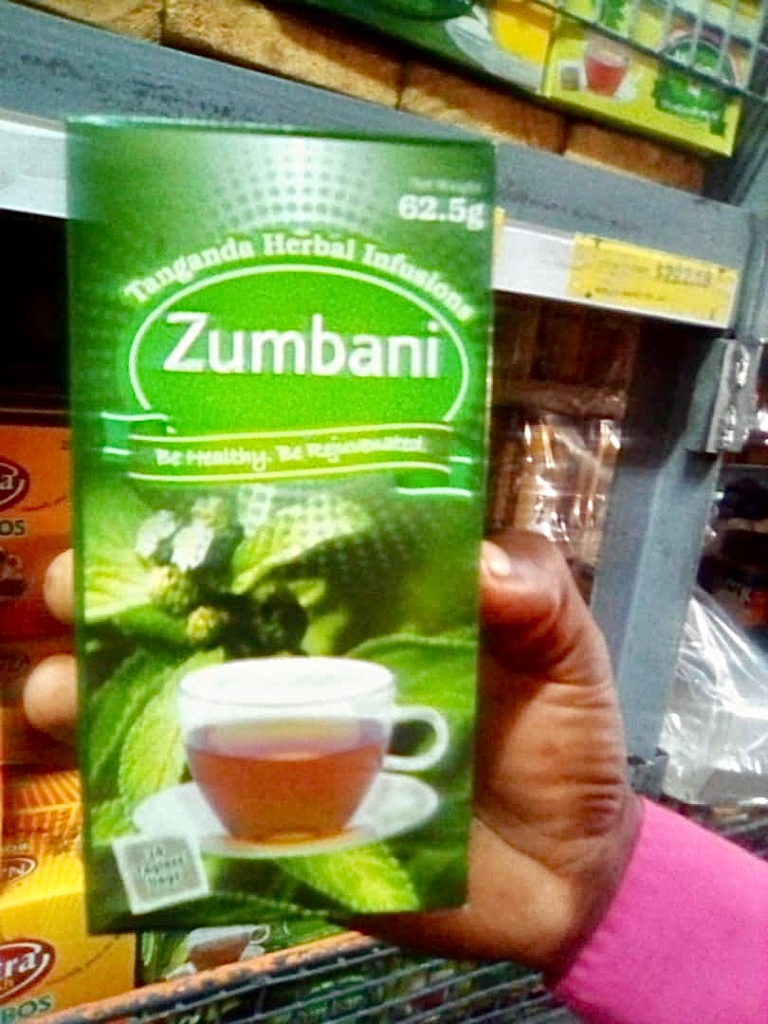
As team members commented, the shifts in behaviour over the past year around hygiene in particular have been impressive. As one commented, “you go to people’s houses and there’s hand sanitiser or soap to wash; even the kids will pull you up and ask if you’ve washed your hands!” The village health workers reinforce health messages, and continue to work on small allowances, but are widely respected in local communities. With schools opening soon again, school development committees have been mobilised to supply sanitisers and masks and parents have set up duty rotas to clean and sanitise classrooms.
Despite the lack of coronavirus, people have seen the potential risks through high-profile deaths and sickness (including of relatives) in towns and in the diaspora, in South Africa and the UK in particular. This has prompted local mobilisation and collective action in the absence of state support.
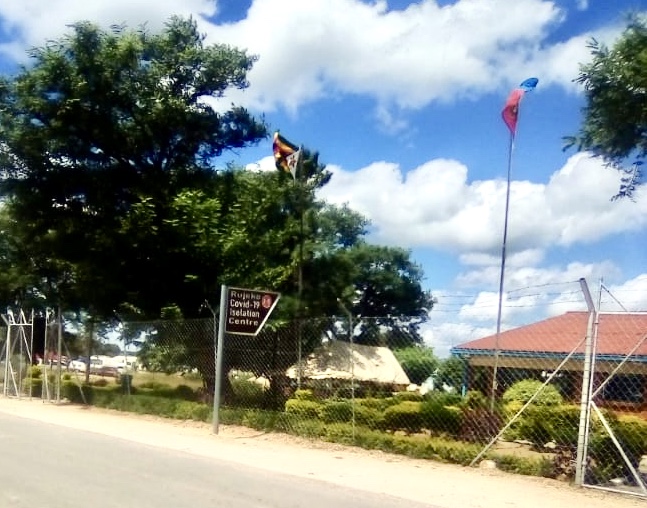
Lockdown easing, but other challenges
In early March, the president eased the lockdown conditions. You can now move without permits between towns (although police are still at road blocks, extracting ‘fines’), and the massive price hikes that were seen in the last lockdown have reversed to some extent. There is more transport on the road and so greater competition among operators and now lower prices, which is in turn easing transport challenges for farmers who can bring their produce to towns to sell. Many suffered badly in the last lockdown as perishable crops just rotted at home, unable to be moved. Now things have improved, and there was a definitely more positive mood reported this month.
What has really struck people hard in this last period has been the tick disease of cattle known as January disease (theileriosis). People refer to this as ‘cattle COVID’, and it is hitting cattle herds really hard. Our team member from Mvurwi estimated that around 25 percent of all cattle have been lost. This collapse in a core asset will have long-term consequences, including damaging knock-on effects for ploughing next season. Tick grease has been supplied as part of government packages, but this is not easy to use given the density of ticks that have grown in number thanks to the heavy rains this season.
Lockdowns have meant that movement of animals is not possible, and people could not go to town to buy dipping chemicals, and even if farmers could get there they were in short supply. Standard government dipping has not been functioning effectively for a while, and the veterinary department has been overwhelmed and not been able to respond. In many ways, the impact of this cattle disease on people’s livelihoods is far greater than COVID-19, and it is being felt across our sites, with farmers selling animals for as little as US$60, and many have died.
***
We never expected to be reporting on the responses to COVID-19 a full year on, but this is now the eleventh report since our first post at the end of March 2020, and we will continue to monitor what happens across our sites in the coming weeks and months as vaccines become more common and the seasons shift from the wet to dry season, hopefully with a decline in tick diseases resulting along with a continued decline in COVID-19.
Thanks to the team from Mvurwi, Gutu, Masvingo, Matobo and Mwenezi. Photo credits: Felix Murimbarimba
Written by Gideon Boniface and Aida Isinika
This blog uses data from recent APRA surveys to examine the changing situation among farmers resulting from the ongoing COVID-19 crisis. The authors look at how the farmers are responding to such changes, how their livelihoods have altered, and what the government and development partners can do to help.
This blog is linked to APRA Round One and Round Two country reports on the Impact of COVID-19 on Food Systems and Rural Livelihoods in Tanzania.
Read the full APRA synthesis report on the Rapid Assessment of the Impact of COVID-19 on Food Systems and Rural Livelihoods in sub-Saharan Africa, here.
Since March 2020, COVID-19 has caused many changes to livelihoods and social-relations (affected by social distancing and a fear of contracting the virus) among farmers in Mngeta division, Mlimba district in Morogoro region. The crisis caused people to adapt to control the spread of infection and cope with its impacts. In the two rounds of phone surveys that took place in July 2020 and October 2020 from five APRA study villages, the findings highlight the perceptions and effects of the pandemic among respondents.
Understanding and interpretations of COVID-19 among respondents
All respondents in both survey rounds showed that they are aware of the pandemic based on media coverage and instructions from the Ministry of Health but there were mixed thoughts on where the virus originated. Some respondents thought the pandemic was restricted to urban centres, while others understood how contagious it is.
Taking of precautions and adhering to control measures
After the first case of COVID-19 in March 2020, the government enacted restrictions on sports and games and limited social gatherings such as wedding ceremonies, funerals and religious services. However, by July 2020 (when the first round of data collection for this study started), restrictions were being relaxed. Universities were opened and other social gatherings (such as sports, concerts and large religious gathering) took place. Most of the respondents (75%) followed guidelines (hand-washing, face masks etc.) for preventing the spread of the virus. By the second round of data collection in October 2020, the number of people who followed guidelines decreased significantly to only 36%, and the majority did not take the pandemic seriously. This decline was partly due to an announcement by the government that spread rates of COVID-19 had significantly decreased.
To avoid unnecessary movement some farmers reported that they decided to stay at home in the first round of the survey, while others bought large quantities of essential goods to limit movement. Takeaway food orders also decreased, with home-cooking becoming more popular.
However, this was not the case in the second round. While most respondents treated the pandemic seriously, there are some who believed they were immune and did not follow any guidelines.
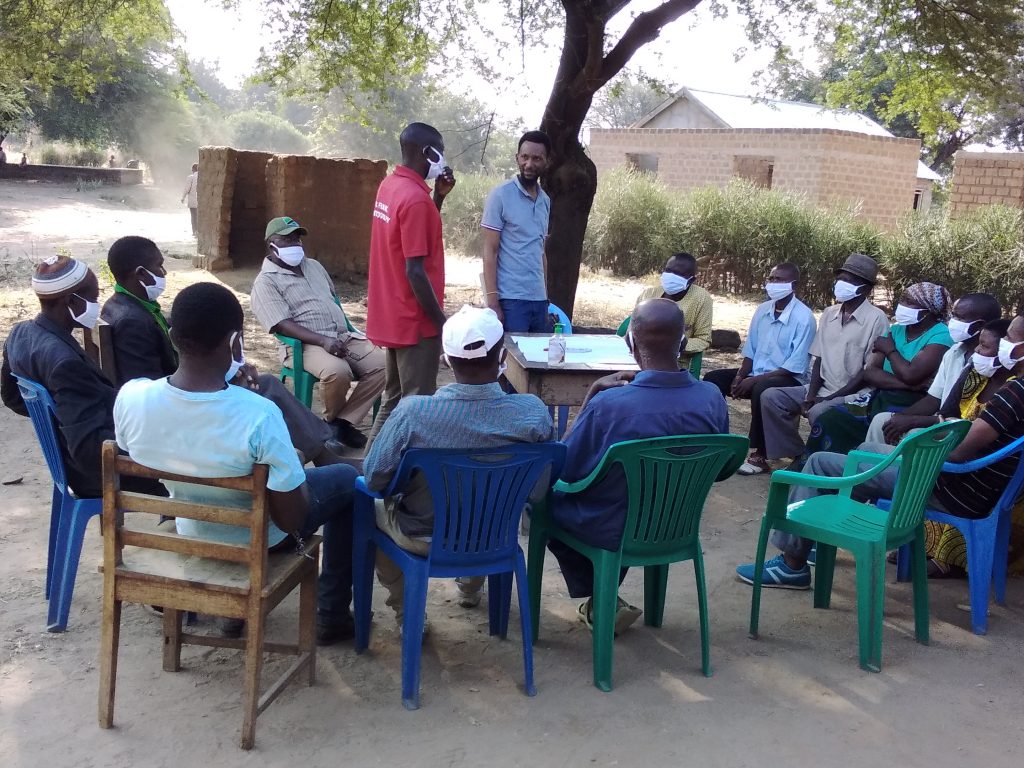
The dynamics in livelihoods
Agriculture is the main economic activity in Mngeta division, with rice as the main cash crop. Following the economic slowdown, many people lost their informal jobs due slowdown of businesses and the imposed restrictions. However, farmers managed to continue with their harvesting activities, incurring lower harvesting cost due to the increased supply of labour as due to job losses in other sectors. Meanwhile, restrictions on movement within the country, including borders to other countries, caused the number of paddy-buying traders to decrease by 70%. This led to an oversupply of harvested paddy and a decline in the price of paddy. In both Round 1 and 2, farmers’ were less able to sell their produce at local and other market channels, forcing farmers to rely on domestic demand within their local villages.
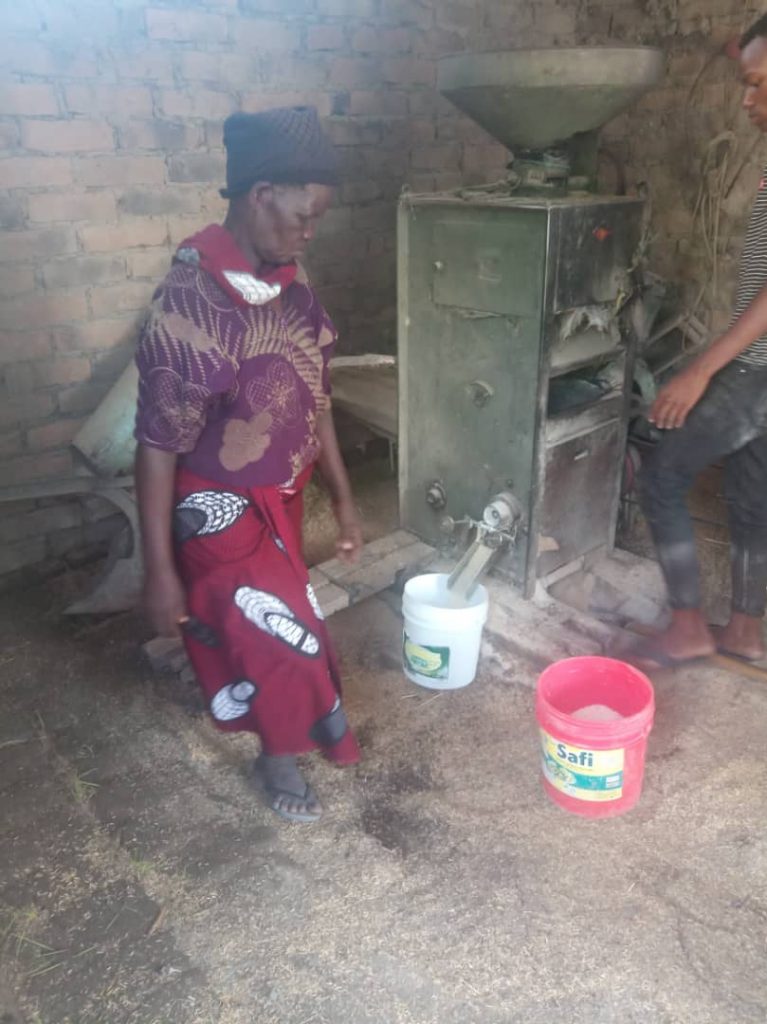
Revenue also declined due, leading to reduction in the farmers’ purchasing power, and a rise in cost of living for most. Due to the decline in farmer’s purchasing power, the majority of respondents ate less varied food, with some farmers having stopped cultivation of crops in short rainy season of 2020 (September–December) to cut production costs. Round 2 of survey highlighted concerns for the next agriculture season (planting is between November 2020–March 2021, with harvest starting in July 2021) due to not being able to afford inputs for production, even though prices remained unchanged.
In both rounds of the survey, operations of rice milling machines were reported to have declined, and processors operated at only 30% of their capacity. The processing that was taking place was mainly reserved for the paddy sold within the villages, or home consumption in small quantities. Worker numbers in this industry were reduced, and others had their pay halved.
To cope with the effects of the pandemic some people who lost their jobs decided to join fishing activities in Mngeta River. Others started selling face masks, sanitisers, and buckets, all of which were in high demand. In the first round, some respondents reported an almost two-fold increase in their income due to selling these items, and demand was so high that some stocks vanished within two days. By Round 2, these business disappeared as their demand has gone down significantly, a situation that hurt those traders who had stocked up on these items.
Conclusion
In Mngeta division, COVID-19 not only caused negative effects, but it also caused emerging opportunities for those who lose their jobs in the first wave of the pandemic. However, it also left unanswered questions, such as where did the virus originate from? When will the pandemic come to an end? And what will be the further social-economic impacts of the pandemic as it continues to disrupt the economies globally.
Government and development partners should keep urgent priorities in enabling farmers to afford the production costs by helping them accessing the inputs and services of/for production such as fertiliser, improved seed, pesticides and tillage services. This will help to avoid the possible threats imposed on food and nutrition security due to forecasting decline in the production level of the crops as farmer’s ability to afford enhanced production inputs has declined.
Feature photo: A group of farmers taking part in an APRA focus group discussion in Luono village, during lunch break. Credit APRA Tanzania
Please note: During this time of uncertainty caused by the COVID19 pandemic, as for many at this time, some of our APRA work may well be affected but we aim to continue to post regular blogs and news updates on agricultural policy and research.
The Agricultural Policy Research in Africa (APRA) Work Stream 2 team have continued to attend events, despite the technical challenges brought by pandemic-related lockdowns.
Dawit Alemu, Ethiopia-based academic, participated on behalf of APRA at the Zoom Webinar “COVID-19 Impact and Rice Competitiveness” on 25 February 2021, organised by Coalition for African Rice Development (CARD). The webinar was designed to deliberate on (i) the impacts of COVID-19 and possible mitigation measures, and (ii) to create an opportunity for the CARD initiative and its stakeholders to have a broader picture of the impacts of COVID-19 on the rice sector development in the continent.
More than 200 participants from 40 countries from across the world engaged in the webinar, including the Minister of Rice Promotion of Côte d’Ivoire, Japan International Cooperation Agency (JICA), International Rice Research Institute (IRRI), AfricaRice, APRA, participants from the 32 CARD member countries, development partners, and donors.
The webinar focused on the impact of COVID-19 on the agriculture sector and rice sub-sector in sub-Saharan Africa (SSA), and two presentations were made followed by reflections and a question and answer session. The first presentation was on JICA’s assistance on food and nutrition with COVID-19, while the second was on APRA’s Rapid Assessments on the Impact of COVID-19 on Rice Value Chain in Africa presented by Alemu. This included an overview of APRA’s main synthesis report, as well as the round 2 country reports for Tanzania and Ethiopia. In particular, the key timing, purpose and goals of these rapid assessments were explained to ensure timely action to address the emerging challenges related with COVID 19. Several other important issues were also discussed during these presentations, such as how regional trade can be facilitated within SSA, on systems over-reliant on international commerce, to reduce the impact of COVID-19
The sessions reflected on the need to consider specific challenges facing different countries and regions when addressing the impact of COVID-19, along with the on-going attempts to increase competitiveness through upgrading rice value chains covering process upgrading (farming and milling), product upgrading (variety, standard, packaging), functional upgrading (vertical coordination, channel upgrading, and inter-sectoral upgrading (by-product product development).
In conclusion, it was agreed that the CARD secretariat will document the key issues identified for further discussion and the design of interventions. The APRA research outputs are expected to inform the future discussion for the design of intervention options at both country and regional levels.
Mr Tadashi Sato, JICA Vice President, emphasised the timeliness of the event during his closing remarks in order to address the challenges caused by the pandemic, and urged those attending to sustain their engagement.
“APRA will continue its engagement activities, and inform CARD, and its member countries, on its latest research and policy findings. Our APRA researchers also look forward to attending the next CARD general meeting, held in Abidjan next year.”
APRA researcher Dawit Alemu, speaking after the webinar
The webinar focused on many topics that will also be raised in the upcoming East Africa Rice Conference on 20-22 May, which APRA is co-convening with CARD, CABE, JICA and IRRI. For more information on this conference, click here.
Access all of the presentations from the webinar, here:
Shinjiro Amameishi, JICA. JICA’s Assistance on Food and Nutrition with COVID-19 (Increase of resilience through CARD)
Dawit Alemu, APRA. The Impact of the COVID-19 Pandemic on Rice Value Chains: Findings from Ethiopia and Tanzania.
Ernst Zippel, AfricaRice Responding to the COVID-19 crisis:CORIS rice seed delivery model.
Shuichi Asanuma, JICA. Strengthening competitiveness through better seed systems.
Matty Demont, CGIAR. Upgrading rice value chains to increase competitiveness of domestic vis à vis imported rice in Africa.
Feature photo: field workers tend CIAT’s rice plots, during the Global Rice Science Partnership (GRiSP). Credit: ©2011CIAT.NeilPalmer
Written by Dawit Alemu and Abebaw Assaye
This blog uses new APRA research to explain how COVID-19 has increased the pressure on the Ethiopian rice sector. The authors provide details the APRA study, the impact on rice production, before examining the decline in household rice production and looking at the way forward for the industry.
Read more on the Impact of COVID-19 on Food Systems and Rural Livelihoods in Ethiopia in the Round One and Round Two APRA country reports.
Read the full APRA synthesis report on the Rapid Assessment of the Impact of COVID-19 on Food Systems and Rural Livelihoods in Sub-Saharan Africa, here.
Background
Like other African countries, rice has become one of the most important commodities for domestic production and consumption in Ethiopia. The increase in domestic consumption has surpassed the increase in domestic production, thereby forcing the country to import rice. It is estimated that the level of self-sufficiency has declined from about 70 per cent in 2008 to 24 per cent in 2019, creating a burden on the meagre foreign currency reserves (see APRA Working Paper 44 to understand the emerging importance of rice as a strategic crop in Ethiopia).
While different initiatives have been implemented to boost domestic rice production including public investment in rice research and training, public extension services, membership in Coalition for African Rice Development (CARD) initiative, and promoting commercial rice production, the outbreak of COVID-19 has created more challenges for domestic production, marketing and rice imports, creating considerable challenge to keep rice supplies well-stocked for consumers. This will disrupt the performance of the rice value chain influencing the opportunities rice offer as business for the different actors of the value chain and also the food and nutritional security status of rice consumers.
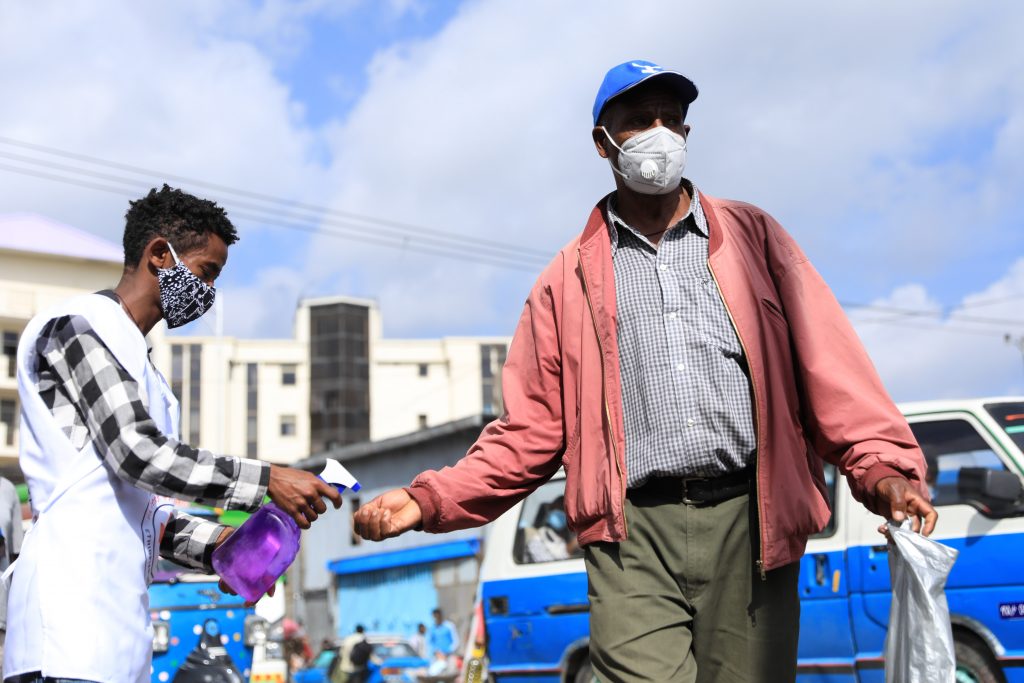
APRA Study
The APRA Ethiopia team assessed how COVID-19 has affected the rice value chains in Ethiopia based on surveys conducted in June-July and October, 2020, with a third round planned for February, 2021.
The impact of COVID-19 on the rice value chain originates from (i) the public restrictive measures implemented by the Government (via the State of Emergency declared from March-August 2020) and local authorities, which were related with the movement of people and goods; control of food prices and other goods; and a reduction of public services, (ii) the type and extent of responses in the commercial behaviours of the different actors of the rice value chain, and (iii) overall global trends in response to the challenges .
The results indicate that nearly all rice farmers reported that they are aware of COVID-19 along with the preventive measures such as social distancing and wearing of facemasks but very few abide by such measures. Many households reported reduced movements within and outside of villages due to the restrictions, which has resulted in certain changes in roles among household members, such as care and farm responsibilities.
Impact on rice production
Though there was limited impact on rice production activities due to farmers not fully abiding to COVID-19 restrictions, there was a considerable decrease in the availability of agricultural inputs with significant increase in input prices. There is shift in the commercial behaviour of actors of the rice value chain due to the mobility restrictions and import challenges linked with the export ban by major exporting countries mainly India and Pakistan and to some extent Vietnam, and increasing prices of paddy and milled rice. These have resulted in concerns about food nutrition and insecurity among many farmers.
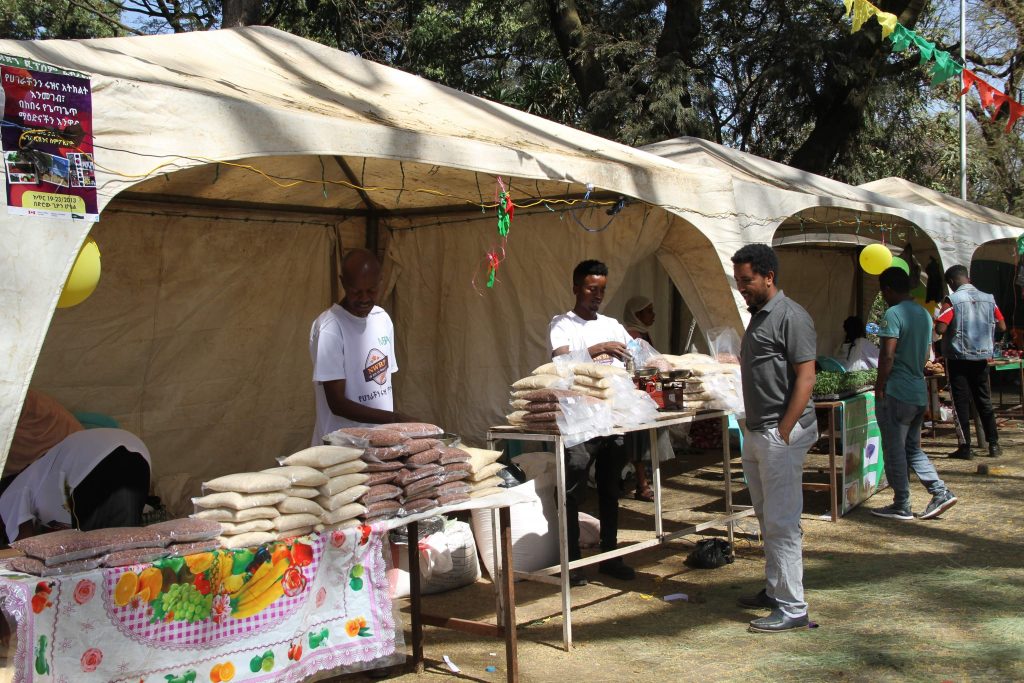
Decline in household rice consumption
There is also decline in rice consumption both in terms of frequency and volume of consumption in urban context. Comparing the changes observed in Addis Ababa in August 2019 with August 2020, about 21 per cent of respondents stopped consumption and almost the same proportion of respondents began consuming rice. The frequency of rice consumption per week has declined on average of 1.11 days per week to 0.88 days per week for each household. Because of the COVID-19 pandemic, 79 per cent of households had either stopped or reduced the volume of rice consumed.
Way forward
Given the declining trend in rice self-sufficiency over the last 10 years, the emerging challenges related with COVID-19 both for the domestic production and rice import, boosting domestic production and productivity of rice alongside enhancing the value chain performance are crucial. This demands the implementation of different interventions to boost domestic rice production and productivity along with market regulatory measures.
Specifically, enhancing the adoption of rice-related technologies (improved varieties, pre-harvest, harvest and post-harvest technologies, and application of recommended agronomic practices), expansion of rice production through improved access to irrigations, modernisation of rice processing industry, and improving an enabling policy environment for increased investment in rice sector.
Feature photo: Rice producers and processors display their rice products in Wereta, Ethiopia.
Please note: During this time of uncertainty caused by the COVID19 pandemic, as for many at this time, some of our APRA work may well be affected but we aim to continue to post regular blogs and news updates on agricultural policy and research.
Written by Louis Hodey & Fred Dzanku
This blog highlights the findings of a recent study that seeks to estimate the impact of COVID-19 on food systems and livelihoods in south-western Ghana and provides insights based on household-level and key informant data gathered in the first and second rounds of three expected surveys.
This blog is linked to APRA Round One and Round Two country reports on the Impact of COVID-19 on Food Systems and Rural Livelihoods in Ghana.
Read the full APRA synthesis report on the Rapid Assessment of the Impact of COVID-19 on Food Systems and Rural Livelihoods in Sub-Saharan Africa, here.
Background
Beyond its severe impact on public health, the COVID-19 crisis appears to be affecting broader spheres of life. Evidence is gradually emerging on the impact of the crisis on food systems and rural livelihoods worldwide. The first (R1) and the second round (R2) APRA surveys involved 110 households and 107 households respectively in the Mpohor and Ahanta West districts of Ghana’s Western region. Additionally, five key informant interviews were conducted in each round. The study communities are Akatanchie, Ahountemo, Hotopo, Manso and Adum-Dominase. The R1 survey was conducted in June/July 2020, and the R2 survey was in October/November 2020. The final round (R3) of the survey is scheduled for mid-February 2021.
Key findings
Our findings show that one of the immediate responses of farmers to the announcement of COVID-19 restrictions in the country was a decline in their participation in farm and off-farm economic activities. This however improved between R1 and R2 surveys, following the easing of most COVID-19 restrictions by the government.
Next, though farmers’ access to output markets improved marginally since R1, access to farm inputs such as seeds, fertilisers, as well as extension and advisory services remain highly constrained by increasing input prices, COVID-19 movement restrictions, and severe financial difficulties caused by the COVID-19 crisis. In one of our key informant interviews, a community leader in Ahountemo indicated that:
“The markets are relatively better since the last interview. Unlike the lockdown period, activities are back to normal. People can work now and have some money to help them meet their basic needs.”
Community leader in Ahountemo
This decline in access to farm inputs is likely to affect crop yields and subsequently, farm incomes, with potentially dire implications for households’ food security and well-being.
Further, we find that though the closure of many informal markets in key urban and peri-urban areas to avoid crowding has initially disrupted food supply systems in R1, the output market situation has improved considerably in R2, thanks to the easing of such restrictions over the period.
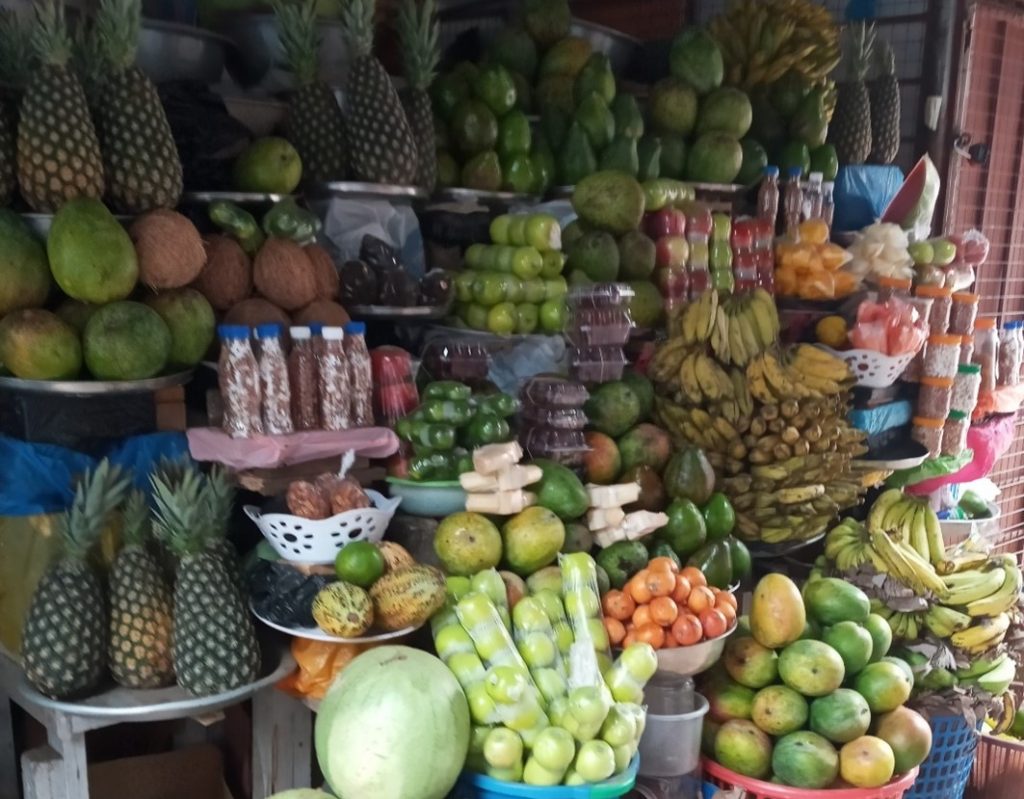
Households generally reported spikes in the cost of living, suggesting declining living conditions in the area, although the severity has eased marginally between R1 and R2 surveys. Decrying the price hikes, a community leader in Manso has this to say:
“The only food that is now in short supply is cassava. But the prices have really increased. We buy them at twice the prices we used to buy.”
Community leader in Manso
Indeed, Figure 1 shows that more than a half of respondents observed increased cost of living following the COVID-19 crisis, though this observation slightly declined between R1 and R2 surveys.
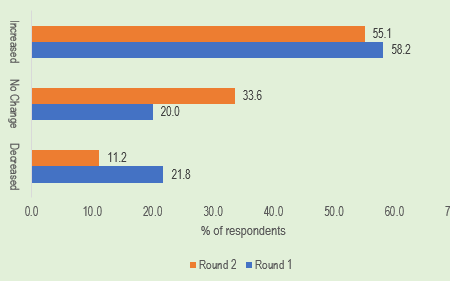
Subsequently, our findings point to a precarious food insecurity situation among households in the study area. This appears to be fuelled by increasing costs of living amidst financial hardships imposed by the COVID-19 crisis. Indeed, though the availability of food supplies has generally improved between R1 and R2 surveys, price hikes persist for certain important food items.
Quite markedly, we find that the COVID-19 alleviation support received by households from government and other local sources have considerably declined between the two rounds of survey.

Speaking in relation to the declining support, a male community leader in Manso, one of the study communities made the following passionate appeal during a key informant interview:
“We are still appealing to the government to come to our aid and help us with some form of financial assistance to lessen our hardship.”
Male community leader in Manso
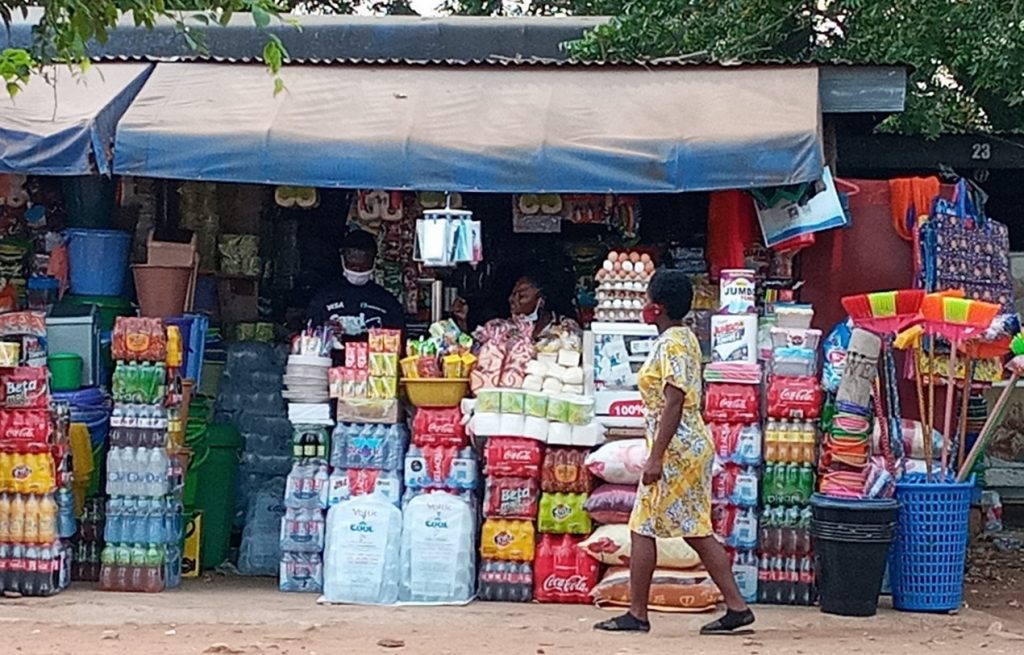
Conclusions and the way forward
In summary, our key findings so far point to increasing costs of living resulting from rising food prices and declining income levels. This has further heightened the food insecurity situation of farmers in the study area. Amidst these difficulties, COVID-19 alleviation support for farmers in our study area is reported to be waning. How would these vulnerable farmers cope with these conditions going forward? According to the Food and Agriculture Organization of the United Nations (FAO, 2020), safeguarding the lives and livelihoods of the most vulnerable people is important to mitigate the impacts of the COVID-19 crisis on vulnerable households in the short term. Therefore, efforts geared at building the resilience of food systems and improving livelihoods by targeting the worst affected groups such as smallholder farmers is critical to safeguarding the sustenance of the most vulnerable in Ghana.Indeed, improving farmers’ access to key agricultural inputs such as seeds, fertiliser, and other farm inputs would be critical to this end. Most importantly, the role of government and non-governmental organisations would be crucial in providing the required production and livelihood supports to smallholders.
Feature photo: One of APRA Ghana enumerators in an interview session prior to the COVID-19 crisis in Ghana. Credit: Louis Hodey
Please note: During this time of uncertainty caused by the COVID19 pandemic, as for many at this time, some of our APRA work may well be affected but we aim to continue to post regular blogs and news updates on agricultural policy and research.
Written by Chrispin Matenga and Munguzwe Hichaambwa
This blog highlights how COVID-19 preventative measures have affected small-scale farmers surrounding the Mkushi farm block in Zambia, focusing particularly how such measures have disrupted production, marketing and livelihoods. The authors then look at how the government and cooperating partners can help to make life easier.
Read more on the Impact of COVID-19 on Food Systems and Rural Livelihoods in Zambia in the Round One APRA country report.
Read the full APRA synthesis report on the Rapid Assessment of the Impact of COVID-19 on Food Systems and Rural Livelihoods in Sub-Saharan Africa, here.
Background
Zambia announced its first ‘imported’ COVID-19 case on 18 March 2020. As with other countries in sub-Saharan Africa, the Zambian promptly responded by imposing lockdown measures on 20 March 2020, but this was largely limited to issuing regulations and public health guidelines, and enforcement of partial restrictions.
On 13 March 2020, the Zambian government enacted Statutory Instrument Number 22 of 2020 to aid the enforcement of control measures. The first measures imposed by government involved the closure learning institutions, places of worship, gyms, bars, night clubs and restaurants were to serve food on a takeaway basis. Public health guidelines, such as wearing of masks in public and on public transportation, keeping social distance of 1 metre, avoiding handshakes, avoiding overcrowding during important social events such as funerals, kitchen parties (traditional gathering of women before weddings) and weddings. Social events were restricted to no more than 50 attendees.
Some restrictions were lifted on 8 May 2020 that included the opening of schools for students in final examination years, opening of restaurants and gyms but with strict adherence to public health measures.
APRA Study
To assess the impact of COVID-19 on local food systems and livelihoods, the APRA Study used mixed methods involving a quantitative survey involving 115 small-scale farming households and qualitative interviews with key informants from five communities surrounding the Mkushi farm block* in the Central Province of Zambia between 30 September and 6 November 2020.
Cross-border trade
As a landlocked country with eight borders, Zambia is particularly vulnerable to the pandemic. Thus, a mandatory 14-day quarantine period and testing for truck drivers entering the country was introduced as cases escalated. This, along with measures introduced by Zambia’s neighbour and main supplier of imports, South Africa, disrupted cross-border movement and transportation which had a knock-on effect on the supply chain for important commodities including agricultural inputs and markets crucial to business, as well as, smallholder producers.
The measures undertaken by the government had certain impacts on different sectors (e.g. agriculture, tourism, mining, service sector etc.), as well as spatial effects – or differential effects on the urban and peri-urban on one hand, and rural areas on the other.
Apart from grains, the small-scale farmers currently produce the largest proportion of the country’s vegetables, such as tomatoes, that are sold in regional markets and in the neighbouring Democratic Republic of Congo.
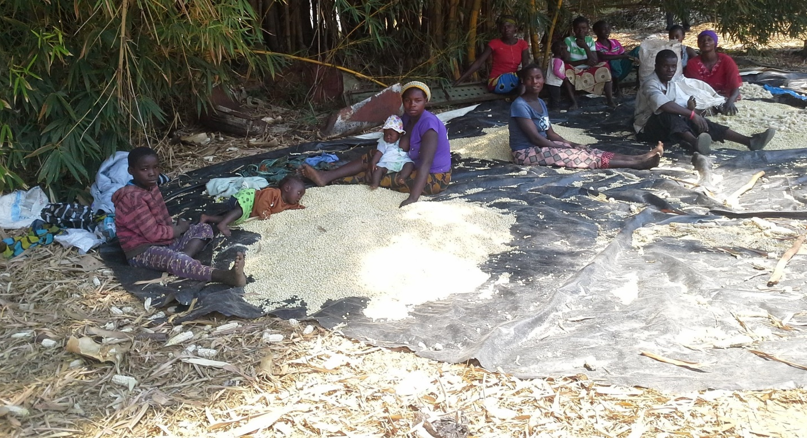
Impact of lockdown restrictions
The effects of social restrictions and partial lockdown measures include:
- Decrease in participation in farming activities by communities;
- Decrease in availability of labour and access to all markets, but an increase in the cost of farm labour and transportation of farm produce;
- Less availability of key foods such as milk and milk products, fish, eggs, meat, grains and nuts, but an increase in food prices compromising household food and nutrition security.
- Reduced movements within and outside the communities, and fewer traders visiting villages to purchase produce.
The escalation of COVID-19 cases during the period June/July coincided with the period of harvesting the annual grains like maize and other crops by small-scale farmers. The farmers reported staying at home for extended periods, while at the same time they were scared of hiring outside labour, fearing contamination. For many farmers, their produce were destroyed in the field and after harvesting, particularly the perishable vegetables and other horticultural products, and some farmers would wait for longer periods to transport their produce to markets.
Interviews indicated that key agricultural services, including agricultural extension services to farmers, contractual arrangements between traders and farmers for main cash crops ( maize and tomatoes and to a lesser extent beans, cassava sorghum and finger millet), and availability of farm inputs had decreased due to Covid-19. Farmers were, thus, unable to benefit from these services, negatively affecting their productivity.
Disrupted cross-border movement and transportation led to uncertainty in future supplies of inputs like fertilisers, agro-chemicals and stock-feed, resulting in price hikes. Worse, movement restrictions meant that farmers could no longer access their usual more lucrative markets in the border areas of Kasumbalesa with Congo DR and Nakonde with Tanzania, thus, denying them the high incomes they earned from these markets before the pandemic.
Farmers were challenged by low prices offered by local markets for their produce, and escalating prices for farming inputs. Therefore, the livelihoods of small-scale farmers were negatively impacted as they reported inability to purchase adequate food from the shops, therefore compromising their food and nutrition security.
Way forward
In spite of the challenges faced small-scale farmers, donors and government have focused efforts have focused their efforts on helping urban dwellers through various economic stimulus packages and emergency cash assistance programmes, leaving out small-scale farmers (who have no access to the programmes) that produce over 90 per cent of food production in the country.
Based on the above research findings, we recommend that government and cooperating partners should consider creating a COVID-19 agricultural stimulus package that centres on the challenges faced by small-scale farmers, rather than the traditional and more generic Farmer Input Support Programme (FISP). FISP targets vulnerable but viable small-scale farmers, thus leaving out the poorest small-scale farmers, and has largely focused on giving input in form of fertiliser and maize seed. The programme does not include other crops in horticulture/vegetables, meaning many more farmers are ineligible.
* A farm block is a large agricultural area where backbone infrastructure such as feeder roads, electricity, water for irrigation and domestic uses, and communication facilities are provided by Government to stimulate sustainable partnerships with private sector investors.
Feature photo: Labourers threshing maize grain at a farm in Mkushi farm block. Photo credit: Cyriaque Hakizimana.
Please note: During this time of uncertainty caused by the COVID19 pandemic, as for many at this time, some of our APRA work may well be affected but we aim to continue to post regular blogs and news updates on agricultural policy and research.
Written by Adebayo B Aromolaran
This blog presents a snapshot of the efforts of Agricultural Policy Research in Africa (APRA) to help stakeholders to track the initial impacts of the COVID 19 pandemic on agricultural commercialisation, food and nutrition security, labour and employment, and poverty and well-being in rural Nigeria.
This follows on from a blog posted in September, 2020 on the same subject.
Read more on the Impact of COVID-19 on Food Systems and Rural Livelihoods in Nigeria in the Round One and Round Two APRA country reports.
Read the full APRA synthesis report on the Rapid Assessment of the Impact of COVID-19 on Food Systems and Rural Livelihoods in Sub-Saharan Africa, here.
Introduction
Since the outbreak of COVID-19 in Africa, there have been serious concerns about the impact of the pandemic on agri-food systems – given that most of the population depends directly or indirectly on agriculture for their livelihoods. These concerns are compounded by the fragile state of the continent’s health and food systems.
The first case of COVID-19 in Nigeria was reported on February 27, 2020. In order to mitigate an impending health crisis, the Nigerian government commenced a series of COVID-19 lockdowns across states in Nigeria on 30 March, 2020. These lockdowns lasted for 3 months before a gradual relaxation began on 1 July, 2020. By the end of June, 25,694 infections and 590 deaths related to COVID-19 had been recorded, rising to 58,848 infections and 1,112 deaths by the end of September 2020.
By late November 2020, the Nigeria Centre for Disease Control (NCDC) was reporting a cumulative total of 67,412 cases, 1,173 deaths, and 3,184 active cases. Currently, a more serious second wave seems to have emerged with 127,024 confirmed cases and 1,547 deaths recorded by the end of January 2021. This interprets to a respective 89% and 32% increase in confirmed infection and death cases in the 2 months between the start of December 2020 and end of January 2021.
Data
The study involves three rounds of data collection and analysis from a random sample of 109 rural farming households drawn from five Local Government Areas (LGAs) in Ogun (Ijebu East, Obafemi Owode, and Imeko Afon) and Kaduna (Chikun and Soba) States. At the time of the start of the first-round survey, these LGAs had reported a small number of COVID-19 cases. The survey data was complemented by insights from seven in-depth key informant interviews conducted in the LGAs. This blog presents some insights obtained from the first and second round surveys implemented in July and October 2020. The third wave data collection is planned for mid-February 2021.
Highlights of findings
Our findings from the first two rounds of survey show that, compared with pre-COVID 19 period, most rural farm households in Nigeria experienced the following during the COVID 19 period:
- Increase in cost of purchased farm inputs, tillage services, land rentals and casual labour;
- Increase in prices of food items;
- Decreased access to farm inputs and agro-services;
- Decline in accessibility to agricultural markets;
- Decline in land area under cultivation; and a decline in household food consumption and dietary diversity.
In addition, the negative effect of the lockdown on children’s education was severe, in that the majority of households reported that boys and girls spent a substantial amount of the lockdown time in non-school related work and leisure activities.
The study also observed the softening of some negative impacts of COVID 19 lockdown on livelihood in Round 2 relative to Round 1 of the study. Some of the observed areas of improvement in between R1 and R2 data collection were:
- Increased availability of purchased farm inputs;
- Better access to farm-gate markets, increase in food availability;
- Improvements in food consumption and dietary diversity.
Even though, our study locations, Kaduna and Ogun states, are currently among the first 7 states in rank on the NCDC list of confirmed COVID 19 cases; less than 5% of sampled households have seen someone with COVID 19 in their community. Consequently, it can be said that the negative effects of COVID 19 pandemic on livelihood recorded in this study is largely due to government lockdowns and restrictions in movement rather than direct COVID 19 infection.
Case study: a poultry farmer
An interview with a prominent member of the Poultry Farmers Association of Nigeria demonstrates how the sub-sector was badly hit in the first two months of interstate border closures between April and May 2020. This poultry farmer had to starve the stock of layer birds of feed to bring down egg production from 90% to zero per cent in order to cope with the egg glut after about 2 weeks of inter-state lockdown. This was caused as most of the egg buyers were from outside of Ekiti State and could not easily cross state borders reach the farm in Ekiti.
To compound the problem, egg sales declined because of shrinking incomes of consumers resulting from low reduced level of economic activity due to the lockdowns. This was in addition to very high transportation costs that carriers of agricultural produce experienced during the lockdown. This high cost was partly driven by extortions from law enforcement officers in multiple check points on most Nigerian roads.
All of these factors put together nearly crippled investments of this poultry farmer in the first 3 months of lockdowns in Nigeria. The situation adversely affected the health of this farm household as the household head and the spouse needed sleeping pills to get some sleep at night.
This demonstrates how poorly managed the lockdown was by agencies of government, leading the unintended consequences, caused partly by inter-border closures and bribery by law enforcement agencies, arguably being more of a health risk to families than COVID-19.
Looking ahead
Finally, the APRA study observed a significant decline in compliance to government COVID 19 safety regulations between the first and second 4-month periods of COVID 19 pandemic in Nigeria. The Government may therefore need to find more effective ways of enforcing compliance if a severely impactful second wave is to be averted. To do this, the Government could identify and financially support influential local/community organisations to advocate for increased compliance to COVID 19 safety regulations at the grassroots level.
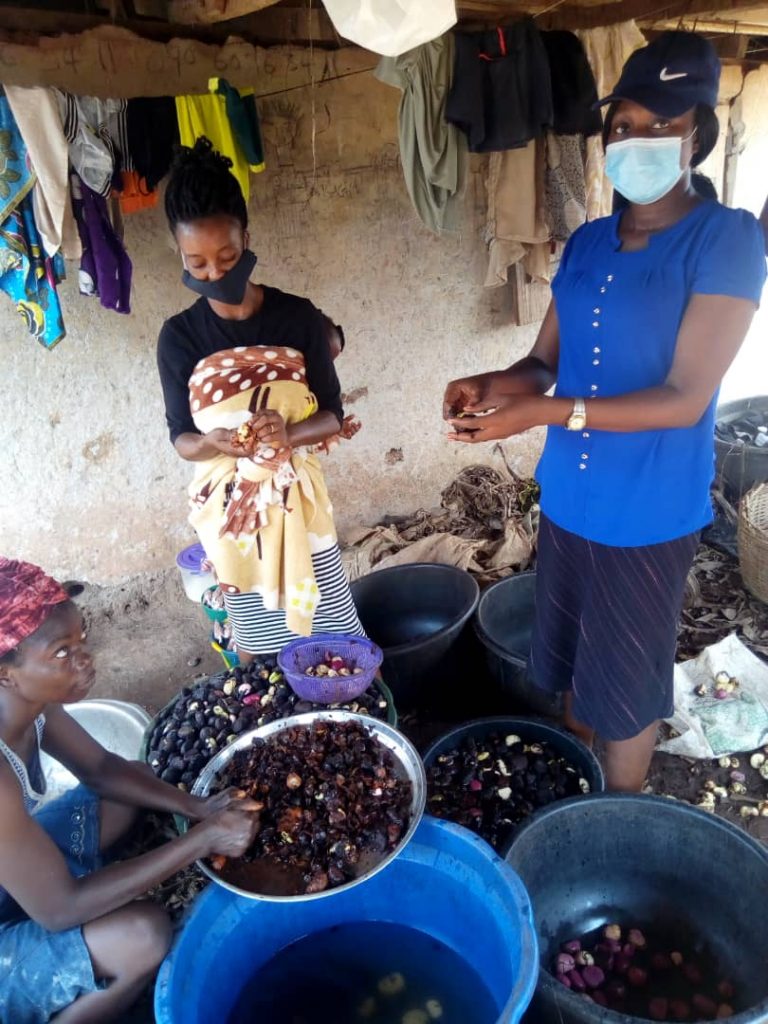
Peeling soaked Kolanut at Gbamgbam Village in Ogun State Nigeria. © Olayinka Taiwo 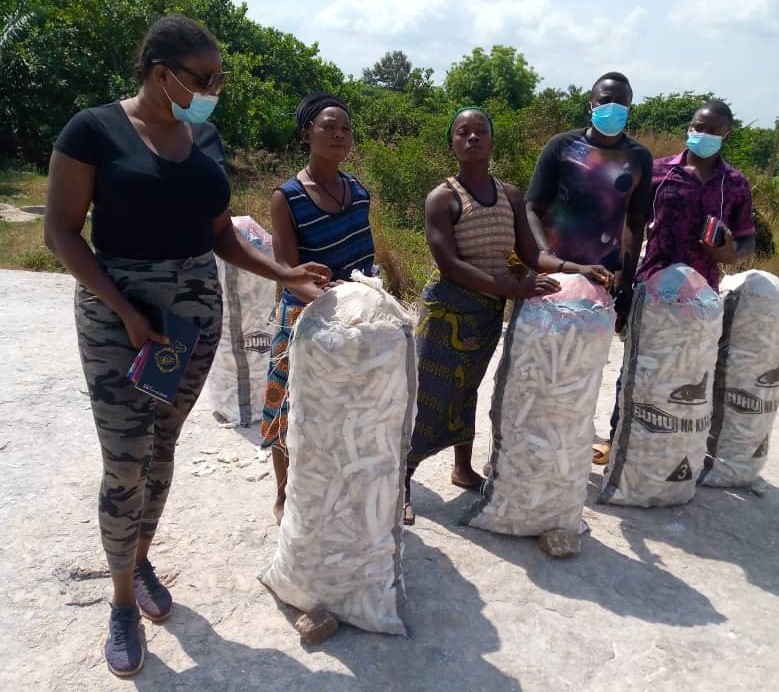
Peeled cassava roots at Agboro village Ijebu east Ogun state Nigeria. © Samson Afolayan
Feature photo: The Dopemu bus stop is seen amid the COVID-19 Pandemic in Nigeria. Credit: © IMF Photo/Ebun Akinbo
Please note: During this time of uncertainty caused by the COVID19 pandemic, as for many at this time, some of our APRA work may well be affected but we aim to continue to post regular blogs and news updates on agricultural policy and research.
This post was written by Ian Scoones and first appeared on Zimbabweland.
A few weeks back Oxfam released a major report, ‘The Inequality Virus’, documenting the way COVID-19 has affected different populations and parts of the world. The now well-established impacts on the already-marginalised are presented, alongside how the rich have benefited. But the debate in Zimbabwe is currently rather different – people are wondering why the virus is hitting the urban rich and well-connected the most.
The last weeks have seen a massive spike in reported cases and deaths in Zimbabwe. The deaths of senior politicians, party officials and business people have been widely reported. It has provoked a level of concern, even panic, across the country, especially given the parlous state of the health care system.
Last weekend I caught up with the team who is monitoring the situation across our rural study sites – in Mvurwi, Gutu, Masvingo, Matobo, Chiredzi and Mwenezi areas. This is the tenth blog in a series (see here, here and here for updates since last March)
A disease of the urban rich and powerful?
In our rural study sites the experience of COVID-19 as a disease remains limited. Team members were able to report a few cases from each of the sites, with some deaths usually among older business people, but many of the funerals were of those coming back from towns or from South Africa. COVID-19 is still, it seems, not a rural disease – although of course, given the complete absence of testing in these areas, we cannot know for sure.
Over the past week or so, team members have been discussing why COVID-19 seems to be concentrated among the urban rich and powerful with locals in the rural areas where they live. Many explanations were offered. The rich move around more, they fly in planes, drive in cars; we barely move, especially with lockdown. The rich don’t do physical exercise, they move in cars; we walk everywhere – we have to, and do manual work. The rich work in offices and enclosed spaces; we are outside, in the clean air. The rich eat junk food, and have conditions like BP, diabetes and so on; we have fewer chronic conditions and get good food from our own local vegetables, which give immunity.
All this makes sense epidemiologically, but what was central to local narratives across sites was that local responses were not just passive – the consequences of being poor – but due to active choices about prevention and treatment. Unlike a few months ago, there is a tangible fear of the virus now. The news reports of the rich and influential dying despite their privilege, mean that people have to act to protect themselves.
Local remedies and vaccine anxieties
There is today a booming market in local vegetables (such as Rudhe/Ulude and Mutsine/Umhlavangubo (Shona/Ndebele)– ‘weeds’ from fields mostly), as well as local medicines. Hot teas of many sorts – lemon and ginger, guava and eucalyptus, soaked onion – are combined with steaming using a variety of herbs. Herbs, roots and tree products such as Ndorani/Intolwani, Rufauchimuka/Umafavuke, Zumbani/Umsuzwane and Chifumura are hot commodities, and lemons are reportedly selling for 20 bond notes a piece.
As people explained, they cannot get to town for conventional medicines, and in any case they have no money, so local approaches are better. They point to cases where people have recovered using such medicines. WhatsApp group messages are full of advice on local herbal medicines, and offers of their sale.
What then of the prospects of a vaccine? Here there is a raging debate across our sites. When asked, most people seemed highly sceptical. The Chinese have offered vaccines to the country (to be available free, despite early confusion), and this has been widely trailed in the press, as part of China’s effective vaccine diplomacy. While in time there will hopefully be allocations from COVAX, the central global facility too, it’s the Chinese vaccine offer that seems to be generating the most debate.
Where does the scepticism come from? In part it emerges from (usually unfair and often racist) attitudes towards Chinese interventions in Zimbabwe and the quality of Chinese products, disparagingly referred to as ‘Zhing-Zhong’ – cheap, low quality products likely to break or be useless. People also worry that the state will force people to have the vaccine.
There are also rumours that vaccines cause infertility, make women grow beards and have other severe side-effects, potentially resulting in death. It is difficult to know where such rumours come from, but they are very real. I was sent a whole string of videos (mostly coming from anti-vaxxers and others in the US) by a friend who had received them from a church-based WhatsApp group. There are likely many similar ones circulating.
Amongst our informants across the study sites, there was a general unease about the rapidity of the vaccines’ development – pointing out of course that there is still no vaccine for HIV/AIDS after many years. There was also a sense that, among poor rural people, they have not been affected so far, and that the local medicines and remedies being used seem to be working so far.
As across the world, vaccine anxiety mixed with vaccine nationalism will be a big issue for Zimbabwe when vaccines finally come to the country.
Farmers’ lockdown struggles
Combined with the flood of migrants from South Africa coming back over the festive period, there were many press reports of the elite partying unprotected and churches gathering in large numbers. The consequences are now being felt with the current surge. For good reason, the government has clamped down on the strong advice of the medical professionals. Since Jan 2nd there has been a strict ‘Tier 4’ lockdown across the country, recently extended for two weeks until the middle of February.
People report that this is the strictest lockdown yet, with severe movement restrictions, a curfew and business hours restricted from 8am to 3pm. Many arrests have been reported and once again there are accusations that the lockdown is being used to suppress political dissent. In the past, people could flout the rules or get round them – especially if you could bribe the police or were well-connected. Some are still able to get round the lockdown restrictions, but many fewer this time. There are shebeens (drinking places) that operate after dark, some transport operators that dodge the police road-blocks and a few churches still flout the rules, but for most the elaborate process of getting exemption letters is a daily struggle. One of our colleagues explained how he had to get an exemption letter locally in the township in Masvingo to get another exemption letter in town to travel to Chiredzi so he could look after his sugar farm. It’s not easy being a farmer at the moment.
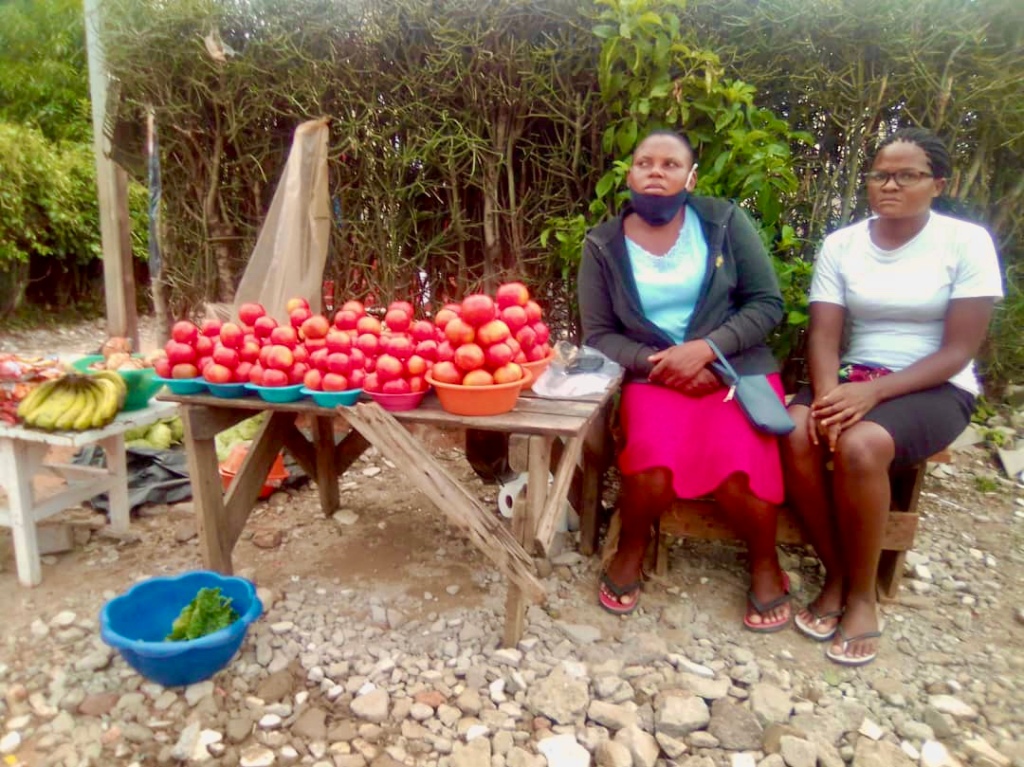
The informal markets and many shops remain shut. Getting farm inputs is nearly impossible as movement restrictions and curfews mean many businesses have closed. Farmers cannot move their produce, and horticultural produce is rotting in the fields. Those who used to rely on vending of agricultural products at fixed locations have to move around or sell from home, with far reduced returns. Input supplies for farming have dried up – with fertiliser being absurdly expensive (up to US$40 per bag) and much in demand because of the heavy rains this year. The rains have resulted in livestock disease outbreaks, notably blackleg, but getting access to medicines is difficult because of movement restrictions, and cattle are dying in numbers. Despite it being a good season overall, especially on heavier soils, gaining the advantage of this is proving tough, both in terms of production and marketing.
With the good season, there are at least some early crops. Cucumbers, pumpkins, sweet reeds and early maize are already being consumed, along with the proliferation of local vegetables and wild fruits that have grown this year. This is a major help to many. Those who planted early look like they will get a decent crop in most of our sites, including those that are traditional ‘drought prone’. But late planted maize is currently looking weak and, with the lack of fertiliser and incessant rain, much of it is yellowing.
The COVID barter economy
Even the COVID economy discussed in previous blogs is highly constrained at the moment. There is very little money circulating and people must get along with their own production and barter exchange. The growth of farming in town is dramatic – the outskirts of Masvingo are reported to be ‘one big farm’! Sugar beans or sweet potatoes with maize seem to be the favoured crops, and these will be keeping many people fed in the coming months.

Those who have some crops can exchange for other goods in their neighbourhoods. Barter is the basis for exchange without cash, and word is put out on the street or via the WhatsApp groups if things are available or needed. Goods are moved around the townships by a proliferation of push-carts, operated by many who have lost their jobs. And with the informal markets closed, selling has moved to people’s homes or mobile shops – in carts, wheelbarrows or cars – linking informal township-based wholesalers (who source for other towns or abroad) and a network of small-scale retailers and vendors.
As we have discussed before, there has been a massive growth of small-scale mining across our sites. In the last few weeks, two new areas have opened up near Masvingo and adjacent to our study sites, with now thousands of miners arriving in a new gold rush. Many underground mines have been flooded with the heavy rains, and some are now dangerous, but mining continues in others, often with serious attendant dangers – not only of mine collapse, but also of COVID-19 infection.
An unequal disease
COVID-19 is certainly an unequal disease, but in unpredictable ways. In Zimbabwe, it affects the rich and powerful disproportionately through illness and death and the poor through livelihood struggles during lockdown. How will the inequality virus’ evolution pan out over the coming months? Check out the blog for further updates.
Thanks to the team in Mvurwi, Gutu, Wondedzo, Masvingo, Matobo and Chikombedzi.
Picture credits: Felix Murimbarimba (Mrs Florence Magura and her daughter selling sugar bean seed to farmers from her place of residence as the kutrain market is closed due to lockdown; Road-side vendors, Mucheke; Loice Dzoro’s maize and sweet potato crop in Victoria ranch suburb, Masvingo).
Written by John Olwande and Miltone Ayieko
In our latest blog, John Olwande and Miltone Ayieko of the Tegemeo Institute examine the results of recent APRA studies and assess the impact of an easing of COVID-19 lockdown restrictions in Kenya on the livelihoods of small-scale farming households.
This blog is linked to APRA Round One and Round Two country reports on the Impact of COVID-19 on Food Systems and Rural Livelihoods in Kenya.
Read the full APRA synthesis report on the Rapid Assessment of the Impact of COVID-19 on Food Systems and Rural Livelihoods in Sub-Saharan Africa, here.
Kenya confirmed its first case of COVID-19 on March 12, 2020. Since then, the Ministry of Health has confirmed a cumulative total of 98,432 cases of new infections, 81,255 recoveries and 1,716 deaths as of January 12, 2021. The initial response by the Kenya government was to implement a range of policy measures in efforts to contain the spread of the coronavirus. These included:
- Restricted movement of people;
- Countrywide dusk to dawn curfew;
- Ban on dense crowds of more than 100 persons;
- Closure of universities and schools, restaurants and other entertainment spaces, and some open-air markets, which are managed by county governments and hence the discretionary to close only some of them;
- Ban on all inbound and outbound international flights restricted cross-border movement of people and;
- Mandatory testing of drivers of vehicles transporting cargo over long distance.
Consequences of restrictions
Some of these measures helped to restrict the local spread of virus, but with negative consequences to the country’s food system, such as limiting supply of food, particularly perishables, to the local markets.
For example, a discussion we had with an agricultural officer from Kwale County in June 2020 revealed that the restricted cross-border movement of food and people from and into Kenya and Tanzania at Kinango border point resulted in reduced supply of food in local markets and increased prices. Prices for food items such as beans, cowpeas, green grams, rice, and onions went up, with the price of 1 kg of onions, which is mostly imported from Tanzania, doubling from KES 90 ($0.82) to KES 180 ($1.64). The quality of produce in local markets also deteriorated due to the prolonged transit, caused mainly by police roadblocks set up to enforce COVID-19 protocols.
In a survey that we conducted in June 2020 on rural households in five counties in proximity to Nairobi, Mombasa and Kilifi towns (the five initial hotspots for COVID-19 infections in Kenya), over 40 per cent of the households experienced reduced availability of fruits and vegetables, pulses, nuts and seeds, and white roots and tubers in local markets, while about one-third observed a decrease in the supply of grains, processed foods and fish and seafood.
The reduced supply of food and higher prices not only reduced food access by rural populations, but employment, and therefore income to meet their food and other needs, was also negatively affected.
As an agricultural officer in Nakuru County said, “When COVID-19 struck, many large farms especially in the flower industry lost contracts and laid off labourers”. This observation was also made by an agricultural officer in Kilifi County: “Finding casual work for small-scale farmers was a challenge as demand for off-farm labour decreased drastically”. About 58 per cent of the households in the rural survey in June 2020 also reported that they were unable to hire labour for their farm and off-farm enterprises”.
Household needs not met
Approximately 89 per cent of the households in the June 2020 survey reported that they did not have adequate food for their needs. Additionally, 97 per cent of the households reported that the cost of living generally increased since restrictions, outlining the struggle faced by rural households.
In the third quarter of 2020, the national and county governments relaxed some of the restrictions that were previously in place. According to a follow-up survey on the same households and key informant interviews with government officers in early October 2020, the removal or relaxation of the restrictions appears to have resulted in stabilised food supply in local markets and subsequently moderated food prices. In Nakuru, for example, food supply in the markets generally stabilised compared to June 2020. In Kiambu, some marketplaces had been closed, which led to many traders using their own cars as mobile roadside stores. However, there have been significantly less cars since the markets opened. In Kilifi County, food supply in local markets has changed a little since July 2020. Since transport services have normalised, food traders are able to access the Mombasa market, and food prices have decreased slightly.
Rural labour demand
Employment of rural labour has increased since restrictions were eased in July 2020. People are less cautious about COVID-19 and farms are more accommodating to labourers. The October 2020 survey indicates that 46 per cent of the farming households could not hire labour, down from 58 per cent in June 2020. But demand for labour is low because many farms and businesses have not fully resumed normal operations, while the poor economic situation has lowered farmers’ purchasing power to hire labour. For example, in Muranga County, many export-orientated horticultural farms have not resumed full operations, while in Kilifi County, low demand for labour in the non-farm businesses in nearby towns has continued to affect many small-scale farmers who depend on casual work to supplement their income.
Conclusion
Results from the October 2020 survey show that approximately 77 per cent of the households reported that they did not have adequate food for their needs, which is lower than the June 2020 survey (89 per cent), and a noticeable improvement between July and October 2020.
This implies that a significant improvement in food security among the rural population can be realised if policy responses to curtail the spread of COVID-19 do not restrict food supply in local markets, which would raise food prices, and stymie rural employment, leading to reduced income earnings of rural people. With many COVID-19 restrictions removed or relaxed, the food security situation in the country’s rural areas will likely continue to improve. This will be clear when the third round of the survey is finalised in the first quarter of 2021.
Cover photo: Nakuru, Kenya. ©The Sanitation and Hygiene Fund on Flickr.
Please note: During this time of uncertainty caused by the COVID19 pandemic, as for many at this time, some of our APRA work may well be affected but we aim to continue to post regular blogs and news updates on agricultural policy and research.
Written by Libor Stloukal and Susan Kaaria, Inclusive Rural Transformation and Gender Equity Division, Food and Agriculture Organization of the UN (FAO), Rome, Italy
In the previous blog, demographic factors that leave rural women more susceptible to socio-economic marginalisation were highlighted. In this blog, we focus on the socio-economic participation of rural women, including the “feminisation of agriculture” phenomenon and the impact of crises such as COVID19.
Feminisation of agriculture
Evidence for many developing countries indicates that women’s involvement in agriculture is increasing over time, whether as independent producers, as unremunerated family workers, or as agricultural wage workers. This shift is often referred to as the feminisation of agriculture, and sometimes it is (incorrectly) portrayed as a global trend.
In reality, national-level data sources are seriously deficient with regard to women as independent producers. In many countries, much of women’s work in rural areas is informal or unpaid, and therefore goes unrecorded. From the patchy evidence available, it can be estimated that women comprise over 37 percent of the world’s rural agricultural employment, a figure which rises to 48 percent for low-income countries (estimates based on ILO, 2020). In Sub-Saharan Africa, women make up about 46 percent of agricultural employment. In Southern Asia, although fewer women than men are engaged in employment activities in general, women still make up 30 percent of agricultural employment. In Latin America and the Caribbean, women make up 21 percent of agricultural employment. These shares are higher in some countries and vary greatly within countries.
Globally, there is evidence of only a slight feminisation of the agricultural labour force over the last 30 years, except in the Near East and North Africa regions where the trend is clearly pronounced. In other regions trends are much less clear-cut, with variations in both directions (e.g. significant masculinisation of agricultural labour in parts of South-East Asia and some countries in Latin America and the Caribbean; and feminisation in some parts of Africa, where women traditionally have engaged strongly in agriculture, but their share seems to be rising, e.g. in Botswana, Chad, and Malawi).
We can determine that rural out-migration seems a more significant phenomenon in South-East Asia and Latin America (where the diversification of the rural economy appears more advanced, at least in some regions, and where women seem to be taking on farm management responsibilities in some cases) than in South Asia or sub-Saharan Africa. Southern Africa, however, is more effected by the HIV and AIDS epidemic, which through its sex- and age-specific mortality effects on the composition of rural households, has a stronger influence on the feminisation of agriculture than in any other region.
Agricultural transformation is affecting rural areas everywhere, and each region and country in different ways, depending on local socio-economic and institutional structures. For example, the increased demand for female labour in the agricultural wage labour market as a result of expanding non-traditional agricultural exports is affecting Latin America the most, and to a lesser extent India and some countries in Sub-Saharan Africa, such as Kenya, Rwanda and Uganda.
Socio-economic participation of rural women
Evidently, the forms and conditions under which women participate in agriculture matter for demographic reproduction, gender equality and economic development – as does whether an increase in the percentage of women in the agricultural labour force relative to men is because more women are economically active or because fewer men are working in agriculture.
However, in many settings rural women’s social and economic participation is severely hindered by deeply rooted discriminations which affect their access to resources and assets such as land, technology, education, information, services, rural organisations, employment opportunities outside the family farm, and legal rights.
Women are significantly disadvantaged relative to men with regard to their land rights. This is true for all dimensions of land rights associated with agricultural land: ownership, management, transfer and economic rights. According to FAO’s Gender and Land Rights Database (http://www.fao.org/gender-landrights-database/en/), less than 15 percent of all landholders in the world are women. The distribution of women landholders ranges from 5 percent in Middle East and North Africa to 18 percent in Latin America and the Caribbean. The proportion of women out of all landowners ranges from less than 20 percent in Honduras to slightly over 50 percent in Malawi. Furthermore, women reported owners are less likely than men to have a legal document proving ownership of their plots or to have their names on the land ownership document. Women’s limited land rights effect all dimensions of land use: ownership, management, transfer and economic rights. Existing studies suggest that the gender gap in land ownership is substantial in many countries. In Nigeria, 3.9 percent of women own land, compared with 23.3 percent of men (FAO, 2020).
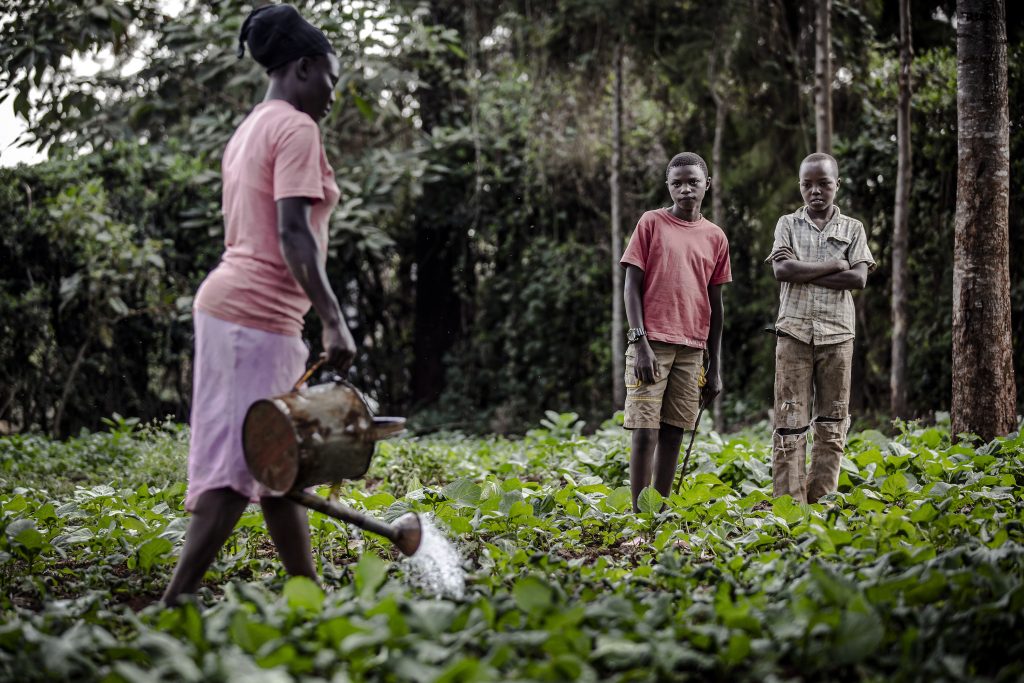
One restricting factor is a lower education level by women compared to their male counterparts. This is partly due to discriminatory access as children and partly due to higher school drop-out rates, driven by factors such as early marriage or pregnancy, but also unsafe school environments and girl’s engagement in unpaid or paid labour.
Similarly, rural women’s access to improved technologies, agricultural inputs, credit and other productive resources, as well as to decision-making, is generally much more limited than men’s. In some rural settings, it continues to occur mainly through the mediation of men, especially husbands or fathers. The multiple biases against women’s access to services, information, financing, technology, and decision-making make it more difficult for them to produce and market as much as men with similar assets. The impacts of climate change further aggravate the situation for rural women, who tend to be generally more dependent on natural resources than men, but their disadvantaged socio-economic status undermines their access to climate-smart technologies and services.
Rural women and COVID-19
Rural women are particularly vulnerable to shocks affecting the agricultural sector, including rising food prices, climate change and socio-economic crises. In this regard, evidence on the gendered impacts of the COVID-19 pandemic is especially revealing. From the limited information that exists, we can conclude that the pandemic has significantly reduced the economic opportunities for rural women.
In Africa, women constitute nearly 46 percent of agricultural workforce and own 1/3 of small and medium enterprises (SMEs). COVID-19 restrictions have undermined women’s ability to access resources for productive activities, find finance to keep their SMEs afloat, and earn incomes in rural markets (CARE, 2020a).
The pandemic has also worsened women’s and girls’ access to nutritious and safe food. According to research conducted by CARE across 40 countries, 41 percent of women and 30 percent of men reported lack of food was a key impact that COVID-19 had on their lives (CARE, 2020b).
Due to COVID-19, women’s unpaid care work and the unequal division of labour within households both increase, as response measures close schools, public spaces and care services (CARE 2020a). Gender-based violence has also increased during the COVID-19 crisis as lockdowns and self-isolation measures increase stress and economic hardship. In Tunisia, initial information indicates an average increase in the incidence of gender-based violence of 50-60 percent, rising up to 400 percent, based on survivors’ calls for help to women’s organisations hotlines (UN Women, 2020).
Therefore, there is urgent need to prioritise women’s access to social protection programs and humanitarian aid. Programs also need to ensure that women (including married women) are able to access aid independently, and that they participate equally with men in COVID-19 response committees and task forces (CARE, 2020b).
Conclusion
The current global demographic and socio-economic picture is one of considerable diversity and ongoing change. The continuation and consequences of demographic trends present unique opportunities as well as challenges for all societies. Understanding a country’s demographic situation should help in prioritising policy responses.
Empowering rural women economically and socially emerges as a clear priority regardless of the country’s demographic scenario, but especially so for the LDCs. Empirical evidence strongly indicates that lasting improvements in household food security in less developed countries can only be achieved through the expansion of women’s access to productive resources, decent employment and education, and their enhanced role in decision-making at all levels.
Improving gender equality in rural areas is one of the most powerful instruments to fight rural poverty and hunger, improve human capital for future generations, and foster inclusive economic growth. The specific nature of gender equitable interventions should reflect the different demographic realities as well as the diverse development needs of countries.
References
CARE, 2020. COVID-19 Rapid Gender Assessments. http://www.careevaluations.org/keywords/covid-19-rga/
CARE, 2020b. She Told Us So. Rapid Gender Analysis: Filling the Data Gap to Build Back Equal. https://insights.careinternational.org.uk/media/k2/attachments/CARE_RGA_SheToldUsSo_Sept-2020.pdf
Committee for the Coordination of Statistical Activities, 2020. How COVID-19 is changing the world: a statistical perspective. https://unstats.un.org/unsd/ccsa/documents/covid19-report-ccsa.pdf
FAO, 2019. RuLIS – Rural Livelihoods Information System [online].
FAO. 2020. Gender and Land Rights Database [online].
FAO, forthcoming. Data Snapshot: Using sex-disaggregated data to better understand gender gaps in agriculture.
Global Strategy for Improving Agricultural and Rural Statistics (GSARS), 2017. Field Test Report: Intra-household decision-making in agriculture. http://gsars.org/wp-content/uploads/2017/05/WP-02.05.2017-Field-Test-Report-.pdf
ILO, 2018. Women and men in the informal economy: A statistical picture. https://www.ilo.org/wcmsp5/groups/public/—dgreports/—dcomm/documents/publication/wcms_626831.pdf
ILO, 2020. World Employment and Social Outlook. http://ilo.org/wesodata
Slavchevska, V., Kaaria, S. and Taivalmaa, S. 2016. Feminization of Agriculture in the Context of Rural Transformations: What is the Evidence? https://openknowledge.worldbank.org/handle/10986/11866
Komatsu, H., Malapit, J. L. H. and Theis, S. 2015. How does women’s time in reproductive work and agriculture affect maternal and child nutrition? Evidence from Bangladesh, Cambodia, Ghana, Mozambique, and Nepal. IFPRI Discussion Paper 01486.
UN DESA, 2019. World Population Prospects 2019.
UN ESCWA and UN Women, 2020. The Impact of COVID-19 on Gender Equality in the Arab Region. https://www.unescwa.org/sites/www.unescwa.org/files/20-00131_gpid_pb_eng_apr5.pdf
UN Women, 2020. Press release: Gender-responsive measures to combat COVID-19 urgently needed to preserve and advance Tunisia’s progress on human rights, warns UN Women. http://gsars.org/wp-content/uploads/2017/05/WP-02.05.2017-Field-Test-Report-.pdfer equitable interfor-gender-responsive-measures-to-combat-covid-19
Feature photo: Members of FAO trained group of youth Blessed Achievers Group harvest indigenous vegetables at a farm in Kiambu, Kiambu County, Kenya on October 5, 2020. Credit: ©FAO/Luis Tato.
No commercial use, advertising, marketing, storage or third-party distribution of FAO photographs is allowed. Photographs may not be modified without prior permission.
Written by Masautso Chimombo and Mirriam Matita
This blog focuses on the perceptions of Malawians in the rural districts of Mchinji and Ntchisi towards COVID-19 and their perception of risk and vulnerability based on the qualitative APRA interviews. It highlights the difficult task faced by authorities in Malawi as they try to curb the threat of the pandemic across the country.
For more on the impact of COVID-19 on Food Systems and Rural Livelihoods in Malawi, read our round one and round two country reports.
Access the full APRA synthesis report on the Rapid Assessment of the Impact of COVID-19 on Food Systems and Rural Livelihoods in Sub-Saharan Africa, for free, here.
Background
The first confirmed cases of COVID-19 in Malawi were reported in April 2020, but the then President of the Republic of Malawi, Arthur Peter Mutharika, introduced lockdown measures which included the closure of learning institutions, mobility restrictions and the closure of borders. Furthermore, markets had to close at 5pm, bars were only allowed to open from 2pm to 8pm for takeaways, no more than 100 people (later reduced to 50) could meet up in public, and many employers were encouraged to let their staff work at home.
APRA study
From late June to early July 2020, the APRA Malawi team conducted both qualitative and quantitative interviews with randomly selected heads of farming households and key informants from government and NGO organisations in the two central districts of Ntchisi and Mchinji. The aim was to understand how ordinary Malawians were reacting to the COVID-19 restrictions and preventive measures, and how these are impacting on the agrarian-based food and livelihood security.
Misconceptions of the pandemic
There is a false and discriminatory view among some in Malawi that because China is the purported origin of the coronavirus (‘China virus’), Chinese people are more likely to have it. In a similar view, which targets the rich, the virus is known as the ‘biggies virus’, apparently because they think the virus only targets rich people who are living in Malawi’s big cities of Mzuzu, Lilongwe, Zomba and Blantyre.
With testing being done mainly in the four big cities, all confirmed COVID-19 cases, critically ill patients, and deaths were only being reported in the four cities. There were, generally, no confirmed COVID-19 reported cases in the rural areas at the time. The profiles of people that were confirmed to be COVID-19 positive portrayed the better off urban elite as the exclusive social class who were affected by the pandemic.
Rural communities therefore only experienced reduced traffic of visitors, such as agri-business vendors who normally travel together to buy farm produce from farmers. For these reasons, in the rural community narratives and discourses, COVID-19 is being discussed in the context of being a disease for the town and city residents.
Smallholder farming households’ perception of risk and vulnerability to COVID-19
According to the Health Belief Model, people will not change their health behaviours unless they are convinced and believed that they are indeed at risk of catching a serious life-threatening disease. If people think that they can’t be infected, or at least not become seriously ill, they will ignore all the COVID-19 preventions which are being promoted by the World Health Organization and its member countries. It is therefore important that farming households, led by their heads, should feel that they are not immune to COVID-19.
Our findings show that overall, the smallholder farming communities in the two central region districts of Mchinji and Ntchisi do not feel that they are at risk of catching the virus. And even if they do, they think the hardships they survive on a daily basis will help them not to get seriously ill with the disease
The rural farmers also attributed their diets – dominated by indigenous vegetables and low use of processed foods like cooking oil – as another reason for their apparent immunity, equating such to herbal vaccinations against diseases. They argue town folks eat processed foods that are full of fats giving them weaker bodies and no immunity.
The key informants reported that the rural farming households believe that the coronavirus cannot affect them, as it is only found in hotels, airports, airplanes, and other places frequented by rich and successful people. Consequently, the people are living within their own world of ‘exaggerated’ safety.
Some members of smallholding farming households in central Malawi think that they are not vulnerable to Covid-19 as they are not “Azungu” (white or light skinned foreigners), who they see as being more susceptible to coronavirus.
‘Fake news’
The same people believed that the local media coverage of COVID19 is fake, for two reasons. Firstly, they accused Peter Mutharika’s government of trying to avoid court-sanctioned fresh presidential elections, which had threatened his grip on power. Secondly, they thought he was faking COVID-19 cases in order to benefit from potential aid from the World Health Organization and other rich western countries, who they believe pressured the government to declare the existence of the virus. They speculated that the government was under pressure to declare existence of COVID-19 from the world super powers.
This conspiracy theory did not spare urbanites, the majority of whom were believed to back regime change and therefore as a result, urgently needed the court-ordered fresh elections to take place. That most of the people who contracted COVID-19 were asymptomatic and never required hospital treatment added to the speculation. Questions arose such as where are COVID-19 patients? Or worse still, where are the dead bodies?
COVID-19 and secularisation
Malawi is very religious country. When COVID-19 restrictions were announced, congregations in churches and mosques were instructed to limit gatherings to no more than 100 congregants. Face masks were also mandatory, which dissuaded some worshippers from attending services at all for reasons such as not being able to afford a face mask. This also led to many religious conspiracy theories, creating further mistrust of the authorities and COVID19.
Conclusion
Perceptions are very important because of their behavioural implications. Those of the smallholder farming communities in Malawi’s central regional districts of Mchinji and Ntchisi points to the conclusion that people do not believe in the existence of COVID-19 and the threat to life that it poses to Malawians. It is therefore important that whatever strategies are being put in place by government and other stakeholders to manage the virus, their existence should be taken into account. As the Health Belief Model warns, people first have to acknowledge the existence of a serious risk for them to change their health seeking behaviours. Preventing COVID-19 is crucial, as only physically healthy people can contribute to food and livelihoods security.
Feature photo: Man transporting firewood along the 50km road to Lilongwe, Malawi. Photo Credit: Mitchell Maher/International Food Policy Institute.
Please note: During this time of uncertainty caused by the COVID-19 pandemic, as for many at this time, some of our APRA work may well be affected but we aim to continue to post regular blogs and news updates on agricultural policy and research.
To better understand the impact that COVID-19 is having on food systems and rural livelihoods in the region, APRA researchers have been conducting a rolling series of telephone-based household surveys and key informant interviews. This blog is based on the findings of these two reports, that were written by Amrita Saha, Marco Carreras and John Thompson.
The first round of surveys and interviews was conducted in seven countries – Ethiopia, Ghana, Kenya, Malawi, Nigeria, Tanzania and Zimbabwe – in June-July 2020. The second round was built on these baseline reports, with the addition of Zambia as an eighth country in October 2020.
Click here to access the country reports.
Since arriving in Sub-Saharan Africa in early 2020, the shockwaves of COVID-19 have hit food systems throughout the region. Many countries, to varying degrees, introduced a series of strict control measures on social and commercial activities with detrimental impacts on food systems in several areas, arguably causing more damage to livelihoods and local economies than the virus itself.
Food and nutrition security at local levels, particularly in Africa, is under the most strain, in spite of global agricultural markets being predicted to remain stable throughout 2021. Further stresses, such as extreme weather events, conflict and insecurity (or a combination of these), and desert locust infestations have added to the pressure for smallholder farmers.
Emerging income-nutrition-livelihood crisis
As efforts to tackle hunger decreased due to the pandemic, there has been an intensification of pre-existing vulnerabilities and inadequacies of Africa’s food systems – understood as “all the elements (environment, people, inputs, processes, infrastructures, institutions, etc.) and activities that relate to the production, processing, distribution, preparation and consumption of food and the outputs of these activities, including socioeconomic and environmental outcomes” (HPLE 2014: 12).
Round 2 findings from October 2020 suggest that the shock of COVID-19 has resulted not so much in a ‘food production crisis’ as an ‘income-nutrition-livelihood crisis’ in some communities and households in the eight countries, mainly from a decline in economic activities, which in turn led to income losses and reduced household purchasing power, and a multitude of food-system wide shocks.
Compared to Round 1, fewer (though still a large proportion) respondents reported a decrease in the number of buyers or traders coming to their village to do business (Stevier Kaiyatsa’s recent three-part blog outlines the decrease of grain buyers in Malawi), excluding in Ethiopia, where marketing activities were largely unaffected.
The availability of transport also declined, while food prices have increased, thus reducing access to vital farm inputs and constraining the movement of goods to local and regional markets. Supplies of staple foods in local markets were also reduced as a result of the trade restrictions, and food prices saw a marked increase.
The loss of income, decrease in food availability and increase in food prices is reflected in local diets, with a sizeable number of households stating that they have been skipping meals and facing a shrinking basket of available foods locally. For example, a large number of households in Kenya (40%), Malawi (34%) and Nigeria (16%) indicated that they “went without eating for a whole day because of a lack of money or other resources”. In Zambia, food availability issues appear particularly stark as nearly half of all respondents reported a decrease in the availability of several food groups. Concurrently, food prices have increased across several major food groups, with the prices of grains, pulses, and nuts and seeds most affected.
The report also outlined that women and girls in Zambia, Kenya and Ghana are encumbered the most by childcare and housework, households continued to report more childcare and housework compared to any other study area. Meanwhile, individuals were still reducing their movements both within and outside their own village, except in Tanzania where travel restrictions have been limited (for more on life in Tanzania following the lifting of restrictions, read this two-part blog series).
However, the effects of COVID-19 restrictions and control measures have not all been negative. Some households have innovated to survive, shifting towards more local production, shorter value chains and diversifying the range of their off-farm livelihood activities (see Ian Scoones’ Zimbabwe blog for an example of how farmers adapted to the challenges brought by COVID-19).
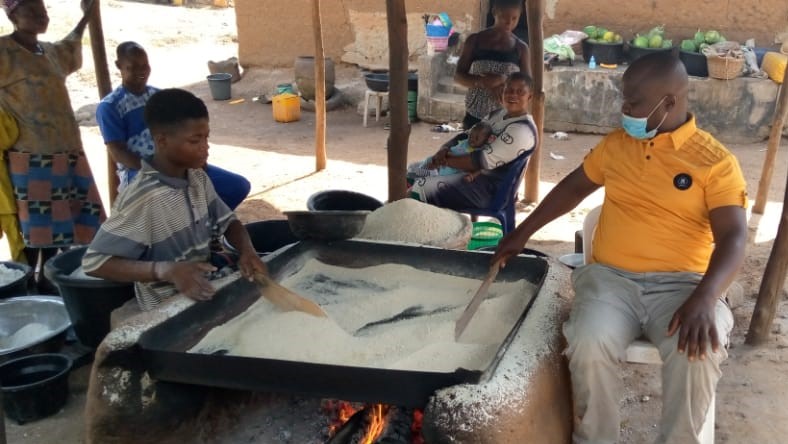
Decrease in emergency assistance
As government COVID-19 restrictions eased in most countries, a general decrease in households receiving any type of emergency assistance was observed, with many stating they had yet to receive any support since June-July, especially those in Kenya, Malawi, Nigeria, Tanzania and Ghana (see this blog for the agricultural implications of the pandemic in Ghana). Family, friends and local religious organisations remain important sources of support for some households, particularly in Ethiopia, Malawi and Zambia.
Mixed results
The APRA assessments found both positive and negative examples of the ability to households to continue their farming activities and non-farm economic enterprises during the COVID-19 crisis, depending on the community and country in question. For example, most respondents in Ethiopia, Ghana, Kenya, Malawi and Tanzania reported no major changes in their own participation in farming activities since the first round, but did experience a decrease in participation in business or household enterprises (except in Ethiopia). In Nigeria, Zambia and Zimbabwe, though, most respondents continued to report a decrease in their participation in farming activities as well as in their business activities. Conversely, in Ghana, farmers’ participation in both farm and off-farm economic activities has generally improved since June-July.
The impact on farm labour also saw mixed results in the different study countries. Most of the respondents in Ethiopia reported that they had managed to hire farm workers (see Agajie Tesfaye’s three-part blog series on the impact of COVID-19 on daily labourers and rice commercialisation). This was also the case in Tanzania, Zambia and Zimbabwe and Nigeria (for more on the unintended consequences of the lockdown in Nigeria, read this blog) but access to hired labour continued to be disrupted in Ghana, Kenya and Malawi. However, in several countries labour costs were on the rise, forming obstacles for many farm operations.
Way forward
For the majority of households in the sample communities, APRA’s multi-country research indicates that they have experienced significant hardship since the onset of COVID-19, with many facing a loss of income, reduced purchasing power, rising food prices and decreased food availability. Farming and business activities have also been affected. While some households have been able to cope with the crisis in innovative ways in the short-term, the intersection of COVID-19 restrictions with other environmental and political economic shocks and stresses has made it hard for others to adapt, particularly with little external assistance.
Although only a second ‘snapshot’ of changing conditions, these results suggest that it will be important to continue to track these households and communities over time to assess how the pandemic is unfolding in different parts of Sub-Saharan Africa. As several countries recently reported an increase in the number of COVID-19 cases, APRA is planning to return to the study communities in the first quarter of 2021 to analyse how local people, governments and food systems are responding.
APRA researchers interview households in Adao Abeokuta suburb, Ogun State, Nigeria. Credit: Anas Umar
Please note: During this time of uncertainty caused by the COVID19 pandemic, as for many at this time, some of our APRA work may well be affected but we aim to continue to post regular blogs and news updates on agricultural policy and research.
In the third and final blog of the series on grain marketing in Malawi, APRA researcher Stevier Kaiyatsa looks at the contributing effects of COVID-19 on grain price instability, the implication of this, and what the Malawian government can do to tackle the problem.
Part one examined the role played by small-scale traders in the grain supply chains of Malawi, while part two looked at how farmers are being exploited by some of these traders.
For more on the impact of COVID-19 on Food Systems and Rural Livelihoods in Malawi, read our round one and round two country reports.
Access the full APRA synthesis report on the Rapid Assessment of the Impact of COVID-19 on Food Systems and Rural Livelihoods in Sub-Saharan Africa, for free, here.
Written by Stevier Kaiyatsa
Malawi recorded its first COVID-19 case on 2 April 2020. Prior to the first COVID-19 case, the former President Peter Mutharika declared the disease a national disaster on 23 March 2020. The government closed schools and banned large gatherings as measures to control the spread of the disease. Further, the government announced a 21-day lockdown on 14 April that would run from 18 April to 9 May 2020. However, the Malawi High Court barred the government from implementing the lockdown on the basis that the Human Rights Defenders Coalition petitioned for more consultations on how to protect the livelihoods of poor and vulnerable Malawians.
Post-harvest period
The post-harvest period in Malawi starts in April, when small-scale traders buy agricultural produce from smallholder farmers. The APRA Malawi team has observed that fewer small-scale traders purchased grain from rural areas during COVID-19. As indicated in part one of this blog series, small-scale traders operate at different scales, namely; low-tier, mid-tier, and top-tier. Thus, COVID-19 created a situation where the big buyers, including local processors, were uncertain on the future of grain markets within and across national borders, which affected the grain supply chain.
Between April and July 2020, most countries implemented lockdowns with additional border controls, so it became risky for the big buyers to invest in grain – particularly those that rely on export markets. Rural areas did not see an influx of top-tier small-scale traders in the midst of COVID-19 relative to the previous years. Thus, it become difficult for the big buyers to purchase the grain through top-tier small-scale traders. As a result, the low-tier and mid-tier small-scale traders were the only ones that were purchasing grain from smallholder farmers since they use their own savings to invest in the grain trade. Although the mid-tier small-scale traders were functioning, their level of operation was affected by trading in smaller quantities, and therefore less trips to sell their grain to the big traders in urban areas.
Grain price instability
As we transition from the lean period (i.e. from October to March) when the grain is scarce to the post-harvest period (i.e. from April to September) when grain is abundant, the overall price of grain drops. Then, the price starts to increase as the post-harvest period progresses. As usual, purchasing prices were lower at the onset of the post-harvest period and farmers expected the prices to increase as the season progressed. However, due to lower competition among the grain traders, coupled with increased supply of the grain on the market, the price of grain continued to drop. For instance, at the onset of the post-harvest period in April, the price of soybean was MWK250 (US$0.33)[1] per kg, but it dropped to MWK180 (US$0.24) per kg in May, and reached as low as MWK150 (US$0.20) per kg in July. Compared to the previous season, the price of soybean increased to MWK320 (US$0.42) per kg in July 2019. Further, the purchasing price of groundnuts was MWK550 (US$0.73) per kg in April, but the price dropped to MWK500 (US$0.66) per kg in May and reached as low as MWK450 (US$0.60) per kg in July, while it was trading at MWK700 (US$0.93) per kg in July 2019. However, I observe that the price for maize grain remained unchanged between April and July 2020 at MWK120 (US$0.16) per kg in most food markets, on average. This might make sense, given that maize grain is a staple crop while soybean and groundnuts are cash crops for smallholder farmers in Malawi. Both mid-tier and low-tier small-scale traders might have enjoyed lower purchasing prices between April and July 2020.
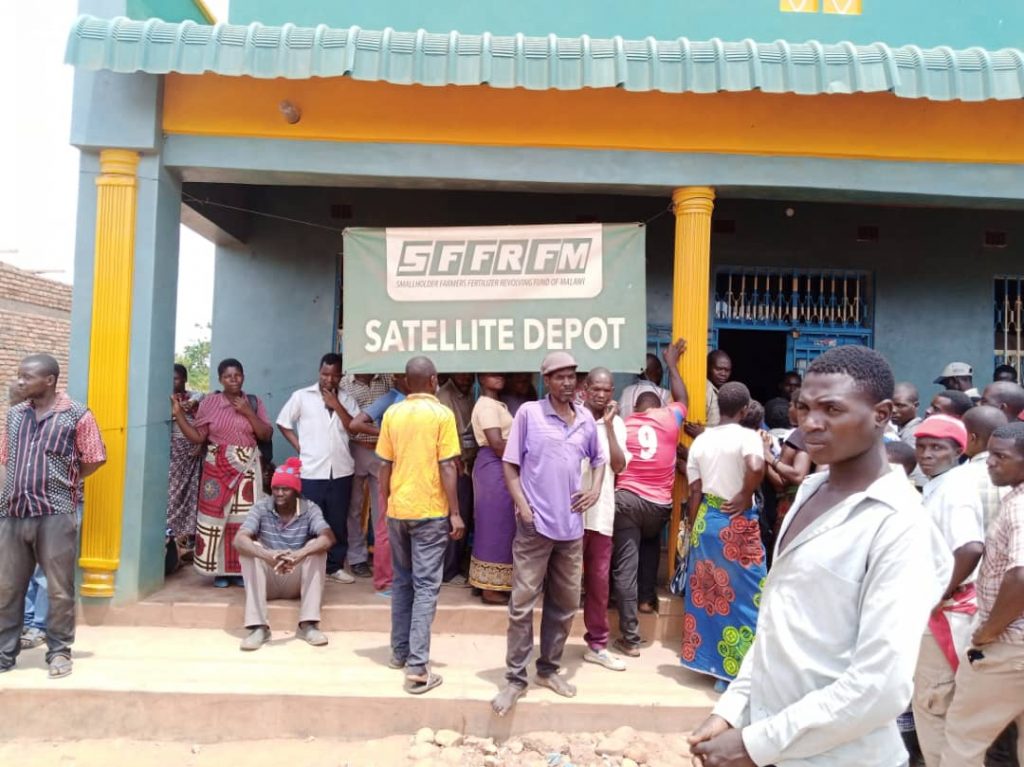
Implication of unstable grain prices
The lower grain prices that most smallholder farmers were offered have implications for smallholder farmers’ income and food security. Smallholder farmers that produce smaller quantities had no option but to sell their produce at very lower prices, while those that have other sources of income are hoarding their grain in anticipation of better prices in the lean period. The lower output prices have eroded farmers’ income, limiting their access to productivity enhancing technologies, such as improved seed and fertilisers, for the next growing season. Therefore, it is more likely that most farmers will not be able to invest in farming to produce greater market surpluses, which will directly compromise their food consumption and agricultural income. Conversely, small-scale traders have aggregated grain at lower prices in anticipation of better prices in the future should big buyers such as the Agricultural Development and Marketing Corporation (ADMARC), the National Food Reserve Agency (NFRA), the National Association of Smallholder Farmers of Malawi (NASFAM), and processors open up their markets as the lean period progresses.
Conclusions
As low levels of COVID-19 continues, the government has reopened schools and lifted the ban on large gatherings. However, uncertainty regarding the future of grain markets both local and across the borders continues to grow among grain traders. This has affected the incomes of smallholder farmers, which may lead to lower production in the upcoming growing season, particularly for non-staple commodities such as soybean and groundnuts. Further, through the Affordable Input Programme (AIP), a successor to the Farm Input Subsidy Programme (FISP), the government has invested about MWK160 billion (US$212.5 million) to subsidize maize production for about 4.3 million smallholder farmers. AIP beneficiary would be able to purchase two bags of fertiliser (NPK and UREA) weighing 50 kg at MWK4, 495 (US$5.97) each, a pack of maize, rice or sorghum seed weighing 7 kg at MWK2, 000 (US$2.66). Unlike the FISP, AIP does not subsidise legume seed for pigeon peas, cowpeas, beans, soybean, and groundnuts.
As a result, we should expect a decrease in the production of legumes including soybean and groundnuts in the upcoming growing season due to smallholder farmers’ limited access to legume seed and an increase in maize production.
A separate investment by government to procure expected surplus maize will be required to protect the incomes of smallholder farmers. One way is to fund ADMARC and NFRA in time to allow them to open up their markets early in the season and procure the maize grain directly from smallholder farmers. This would eliminate grain traders particularly top-tier small-scale traders in the supply chain that benefit at the expense of smallholder farmers. In the future, AIP should include seed for legumes, which are central to smallholder farmers’ incomes and food security.
[1] US$=MWK753 as of November 2020
Feature photo: A women wears a face mark in Mchinji district, Malawi. Credit: Symon Duwe.
Please note: During this time of uncertainty caused by the COVID-19 pandemic, as for many at this time, some of our APRA work may well be affected but we aim to continue to post regular blogs and news updates on agricultural policy and research.
Written by, Marco Carreras, Amrita Saha and John Thompson.
This report presents a summary of findings emerging from the second round of a three-wave rapid assessment led by the Agricultural Policy Research in Africa (APRA) Programme of the Future Agricultures Consortium (FAC) in October-November 2020 to examine how COVID-19 is affecting food systems and rural livelihoods in eight countries – Ethiopia, Ghana, Kenya, Malawi, Nigeria, Tanzania, Zambia and Zimbabwe. It builds on a set of phone-based household surveys and key informant interviews conducted in those countries in June-July 2020, which served as the baseline for this research.1 APRA will continue to monitor the situation as the
response to the pandemic unfolds through the third round of data collection and analysis planned for the first quarter of 2021.
Written by, Chrispin Matenga and Munguzwe Hichaambwa.
To assess the impact of COVID-19 on local food systems and livelihoods, a total of 115 small-scale farming households (102 male- and 13 female headed) were interviewed from five communities (Lilanda, Luang (Mankanda), Masansa, Nshinso and Miloso (Tazara Corridor) surrounding the Mkushi Farm Block in the Central Province of Zambia between 30 September and 6 November 2020. The respondents were selected as a random sample, targeting 20-25 households per community or village. The small-scale farmers in these areas benefit from linkages with commercial farmers in the block.
Written by, Mirriam Matita and Masautso Chimombo.
COVID-19 continues to impact households and economies worldwide. For this reason, in June 2020 APRA started assessing its likely effects on food systems and livelihoods in Malawi. This report presents insights from the second round (R2) of data collection in October 2020. Data was collected from a stratified random sample of 111 households (59 female and 52 male respondents) drawn from an APRA household survey of groundnut producers in Mchinji and Ntchisi districts, Central Region, as well as from eight key informants. One additional round of research is planned for the first half of 2021.
This post was written by Ian Scoones and first appeared on Zimbabweland.
On January 2nd, Vice-President and Minister of Health, Constantino Chiwenga, announced another strict lockdown on the whole country. As in March, non-essential businesses are shut, travel is restricted and schools are closed. Everyone is urged to stay at home. In the last week, there have been a further 1342 cases, adding to the total of 14084 recorded. There have been a further 29 deaths too, including a number of high profile business people and politicians, adding to a cumulative total of 369.
Zimbabwe seems to be facing a second wave, driven by the new variant coronavirus from South Africa. I caught up with colleagues yesterday to hear about the current situation and to reflect on how has Zimbabwe fared since the first case was identified in March 2020 (see the Zimbabweland COVID-19 blog series).
On the face of it, Zimbabwe like many other African countries outside South Africa and to some extent Nigeria, has been relatively spared the ravages of COVID-19 to date. The total (reported) cases and deaths remain low. Compared to the US, UK and much of the rest of Europe, where last week’s reported figures are a small fraction of what is happening each day in these countries, the figures seem to portray (relative) good news.
At the beginning of the pandemic, there was a wave of Afro-pessimism: Africa was going to be hard hit, and with poor health services and many co-morbidities the toll would be massive. This did not happen during the first wave of the pandemic. In fact, the richest, supposedly most ‘efficient’ countries on the planet suffered worse. Why is this?
Why so few cases?
There are many theories out there, and no one really knows – uncertainties are everywhere. Some claimed it was the heat, but of course there are cold parts of Africa in some seasons and places, and hot places around the world have suffered terribly too, notably in Latin America. Some said it was because of widespread BCG tuberculosis vaccination, but the comparative data proved dodgy. Some said it was because of a young population demographic. This certainly helped, given the susceptibility of different age groups, but there are plenty of other places where a ‘young’ population was hit hard.
Certainly African countries, including Zimbabwe, responded to the pandemic quickly and effectively in line with WHO recommendations, with national lockdowns, restrictions on movements and health campaigns. This was unlike Western nations where the response was sluggish, with an arrogance that they knew best. Clearly, they didn’t and coronavirus did not turn out to be like ‘flu as all the elaborate preparedness and contingency plans assumed.
The experience of past pandemics/epidemics has also probably helped in Africa. The AIDS pandemic taught African nations and peoples a lot of important lessons: know your epidemic, take it seriously and change behaviour to save lives. The same applied to Ebola in West Africa and of course SARS in southeast Asia. Such experiences shape cultures and practices, and citizens, experts and institutions learn lessons the hard way. In the West, assuming that COVID-19 was ‘flu was fatal – literally, and resulting in hundreds of thousands of deaths in the US and Europe – but Western nations had not experienced the ravages of a serious pandemic for many years outside certain communities.
In some ways it may have been that poor health conditions actually helped. Acquired or pre-existing immunity through the frequent attack of multiple pathogens may have made certain people more able to fend off COVID-19. Noone knows this for sure, and plenty of poor and marginalised people have died, but it’s a hypothesis worth exploring, as many of the (recorded) deaths have been among middle class and richer people, where co-morbidities – being overweight, having diabetes etc. – are similar to those in the ‘healthy’ West.
The spatial pattern of cases also gives some clues. Cases in Zimbabwe, for example, are heavily concentrated in the larger urban centres, where poorer people live in crowded places and moving to jobs means travelling on crowded transport. The colonial design of racially-segregated cities has resulted in increased susceptibility to this type of respiratory disease, requiring new thinking in city planning.
The other foci of infection are on the borders, highlighting the impact of migration as a spreader of disease, especially from South Africa. With the new variant extending from the coastal areas of South Africa, the transfer of the virus through migrant populations moving back and forth, especially through the festive period, has already happened. Add to this the crowded conditions and long queues at the borders such as Beitbridge seen over the holidays, it has been a recipe for rapid spread.
Understanding disease contexts in rural areas
However, there still remain very few (recorded) COVID-19 cases in any of our rural study areas, and few stories about people who have died. This is the case across the country – from Mvurwi to Chikombedzi – and the exceptions are in all instances a few imports from returning migrants, most common in Matobo. This is striking and contradicts the national narrative of growing infection.
We have been observing the local situation now for 9-10 months, and the pattern seems clear. Despite massive under-reporting due to an almost complete absence of testing, the rural areas seem to have been spared so far. As colleagues noted, “it may be that we have had the disease, but there are a range of ‘flus’ (respiratory diseases), and we know how to treat them with herbal medicines. Even the local village health workers are encouraging their use.”
We asked people in each of the study sites about why there were so few cases, and they consistently identified the activity patterns of people in rural areas. They live outside, there is ‘plenty of air’, they are not crowded together, as villages and homes are spaced out and people don’t move around so much – certainly compared to the ‘big bosses’ from Harare who seem to be suffering most. The moments when infection might happen included, according to their listing, funerals, markets, tobacco selling points, schools, indoor church services and beer parties where receptacles are shared. They also all pointed out that people are generally good at hygiene as this part of cultural practices for washing and cleaning, especially before eating.
As Paul Richards and Daniel Cohen point out on the African Arguments blog, understanding infection risk in context is essential, and this requires detailed insights into what people do where and why. In Africa it is not meat packing plants or care homes where concentrated transmissions occur, but in other settings. In order to shift behaviours and reduce infection, there is a need to know more about – for example – “the way infection hazard is shaped by key ceremonial activities in private spaces.” This means not just relying on the generic ‘science’ and projections from generalised models, or even the direct experiences of elite policymakers in large urban centres, but engaging with those who are confronting the disease, even if at this stage at very low levels. As they comment, it’s imperative to:
“involve at-risk communities of all kinds in debate about how to manage the hazards associated with a second wave of the disease in Africa, based on diligent backward contact tracing undertaken while disease circulation remains relatively low. The time to do this work is now.”
Paul Richards and Daniel Cohen
Only with such engagement and supported by effective testing – as was the case with Ebola in West Africa – will people shift practices, perhaps in quite subtle ways, to prevent disease spreading. The blunt tool of lockdowns and generic health messaging may be increasingly ineffective in a second wave, and more attuned responses will be needed.
Dangers at the borders
As colleagues said, “people are fed up with lockdowns, they don’t know why they are happening”. In the last period, things had got back to a (sort of) normal. Or at least people had found ways of managing the restrictions. Businesses had been re-established, markets had reopened, people were moving about (even if paying bribes to the police at roadblocks), funerals were being held with numbers way beyond the stipulated number, schools were open and mask wearing had become much more casual. The announcement of a new harsh lockdown has been met with dread. People remember the first major lockdown from late March, and cannot afford to return to that situation of extreme hardship.
But notes of caution also come from the border areas, especially in the last weeks. Over the festive period there have been a huge number of returnees from South Africa wanting to visit their relatives and rural homes. The massive queues at the border posts, with traffic jams of 20km or more have been widely reported. Traffic disruption has also occurred further away as police check for COVID test certificates among motorists and truckers.
As we have observed in previous blogs, migrants have invested in their rural homes during the pandemic, and have opened up fields, moving members of their families to these homes and away from towns in Zimbabwe or South Africa. Some villagers have been complaining that grazing areas are becoming short as so much land once fallow (and so available for grazing) has been ploughed this year, spurred on by the very good rains. There is now more movement and mixing with migrants from elsewhere, and especially around holiday times.
With the main border posts highly congested, others have resorted to illegal crossings. The Limpopo is flowing due to plentiful rains and normal crossings on foot are not passable. Boat operators have sprung up using large inflatables, with crossings costing Rand 200 per head. Huge numbers of people cross each day – around 150 per boat – along with goods and supplies, and sometimes even vehicles. Soldiers and border security forces are paid off, and a lucrative transport business has emerged, alongside other activities including supplying food to travellers. These crossings are taken by those without the full paperwork and who cannot pay for the U$50 cost of a COVID test. No doubt viruses along with people and goods are being imported too.
What next?
To date, the rural areas of Zimbabwe have yet to experience the direct impact of the disease, and only the consequences of lockdowns. This may yet change. In the coming weeks, we will continue to monitor the situation in our study areas. How will they cope with the new lockdowns? Will the second wave hit the rural areas this time? What strategies are being used to respond locally, with they remain effective even with greater transmissibility of the virus? Before the next update report, next week the blog will look more broadly at the debate about lockdowns and their politics.
Thanks to the team from Mvurwi, Gutu, Masvingo, Matobo and Mwenezi.
Photo credit: KB-Mpofu/ILO
Written by, Vine Mutyasira.
In response to COVID-19, the Government of Zimbabwe enforced a nationwide lockdown on 30 March 2020, closing most sectors of the economy, including informal markets. However, with limited cases, lockdown movement restrictions were eased and supermarkets, restaurants and vegetable markets allowed to reopen. Between 3-13 October 2020, a second-round (R2) of surveys was conducted, targeting farming communities in Mvurwi and Concession Areas of Mazowe District, to assess COVID-19 impacts on food production systems, supply chains and general livelihoods. This report summarises insights obtained from the phone-based survey, covering 102 respondents (20 female and 82 male-headed households), and 5 local key informants (councillors and extension officers). Results are compared to the earlier R1 survey carried out in late June/early July.
Written by, Gideon Boniface and C.G. Magomba.
On 8 June 2020, the Government of Tanzania officially declared the country to be free of COVID-19 and all restrictions have since been lifted. As of 3 December 2020, Tanzania had only 509 confirmed cases of the virus and 21 deaths. Nevertheless, neighbouring countries are still facing the threat of the pandemic, all of which are key trading partners. Their continuing COVID-19 control measures have disrupted regional and domestic agricultural markets and affected local livelihoods and food systems. This study analysed the resulting impacts in those systems in several rice-producing communities in Morogoro Region, south-western Tanzania.
Written by, John Olwande and Miltone Ayieko.
Since 12 March 2020, when Kenya reported the first COVID-19 cases, the Ministry of Health confirmed a total of 45,076 cases and 839 deaths, as of 19 October.1 Despite the rising number of COVID-19 confirmed infections and deaths in Kenya during the third quarter (Q3) of 2020, the national and county governments relaxed some of the restrictions that had been in place during Q2 aimed at controlling the spread of COVID-19. This assessment was aimed at understanding the effects of COVID-19 at household level and attendant policy responses during Q3 of 2020, to inform actions to assure protection of local food systems, rural livelihoods and the supply of adequate, affordable food of acceptable quality to the population.
Written by, Louis Hodey and Fred Dzanku.
This study seeks to assess the continuing impact of COVID-19 on food systems and livelihoods in south-western Ghana and provides insights obtained from household-level and key informant data in the second of three surveys conducted during October/November 2020. This second round (R2) survey involved 107 households of oil palm farmers (86 male-headed and 21 female-headed) and 5 key local informants in the Mpohor and Ahanta West Districts of the Western Region.
Written by, Abebaw Assaye and Dawit Alemu.
This report presents an assessment of the changes in effects of COVID-19 on agricultural commercialisation, food and nutrition security, labour and employment, and poverty and well-being in rural Ethiopia by comparing the results of a baseline household survey (R1) in late June 2020 with a follow-up survey (R2) in late October 2020. Data was collected from a stratified random sample of 106 smallholder rice farmer households (24 female and 82 male-headed) in five kebeles (villages) in the Fogera Plain
area of Amhara Region. Data was also collected through 25 key informant interviews conducted in the kebeles.
Written by, Adebayo B. Aromolaran and Milu Muyanga.
This study provides insights from a second survey assessing COVID-19 impacts on agricultural commercialisation, food and nutrition security, labour and employment, and well-being in rural Nigeria. Data for round 2 (R2) were collected between September and October 2020, from 109 households that were interviewed in mid-July (R1). Households were drawn from a stratified random sample from three Local Government Areas in Ogun State and two in Kaduna State. This survey data is complemented by insights from seven in-depth key informant interviews. This analysis compares COVID-19 effects in the second quarter and the third quarter of 2020, which corresponds to the first and second 3-month periods after Nigeria’s countrywide lockdown was put in place.
This post was written by Ian Scoones and first appeared on Zimbabweland.
2020 has been quite a year in Zimbabwe and across the world. The blog has had two major series of posts, and this wrap-up features both – now with the links all working.
One series has followed the COVID-19 pandemic in Zimbabwe, and particularly the consequences of lockdown in rural areas. The blogs are based on discussions with our team based across the country – from Mwenezi to Matobo to Masvingo to Gutu to Mvurwi. The pandemic measures have radically reshaped the rural economy, with diverse impacts on different people. Heavy-handed clamp-downs have combined with (as ever) plenty of innovation and adaptation as people find ways of surviving. Luckily, despite dismal predictions, Zimbabwe has as yet not been heavily affected by the disease, a pattern seen in many parts of Africa. Why this is will be the focus of continuing discussion in the new year when this series will continue.
2020 has also seen the 20th anniversary of the fast-track land reform. Our surveys across Masvingo province have continued throughout the 20 years, documenting how livelihood changed in this turbulent period in Zimbabwe’s history, where economic collapse, political chaos and continuous sanctions preventing investment by Western development agencies have persisted. The other major blog series this year therefore presents of the results of our longitudinal studies looking at what has happened in A2 medium-scale farms, A1 self-contained, villagised and informal settlements across Masvingo. The story is fascinating yet complex, and the blogs present much data to show how there have been both important successes, but also major challenges.
Links to the two blog series are presented below. Additional themes discussed this year include commentary on the important compensation deal signed between former white commercial farmers, yet another blog on land tenure (given the on-going intransigence of the debate) and one on conservation and development in the Lowveld. A new paper on the history of commercial farming in Mvurwi was also highlighted.
As ever the blog has been widely read across the world, with many thousands of views, multiple subscribers and plenty of reposts, notably in The Zimbabwean and Chronicle newspapers. The blog will return in the new year with more evidence-based research and comment on agriculture and rural development in Zimbabwe and beyond.
COVID-19 in Zimbabwe: a blog series
Women and young people in Zimbabwe’s COVID-19 economy, Nov 9
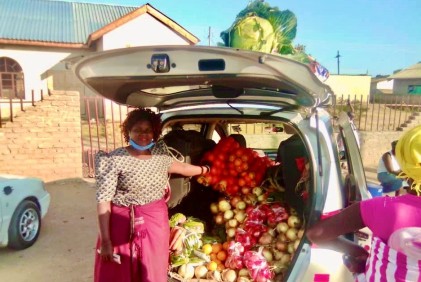
“Know your epidemic”: Reflections from Zimbabwe, Sep 27

Innovation in the pandemic: an update from Zimbabwe, Sep 7

Viral politics and economics in Zimbabwe, Jul 27

COVID-19 lockdown in Zimbabwe: ‘we are good at surviving, but things are really tough’, Jun 15
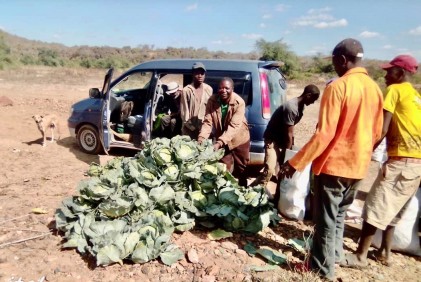
COVID-19 lockdown in Zimbabwe: a disaster for farmers, Apr 27

Surviving COVID-19 in a fragile state: why social resilience is essential, Mar 30
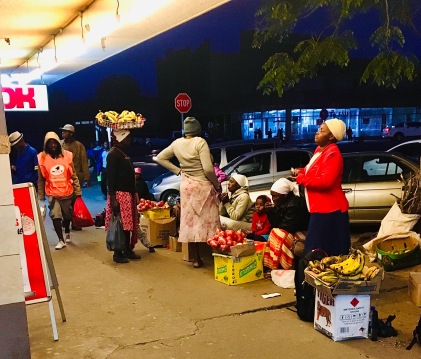
Twenty years after Zimbabwe’s land reform: a blog series
20 years after Zimbabwe’s land reform: what does the future hold? Jun 29
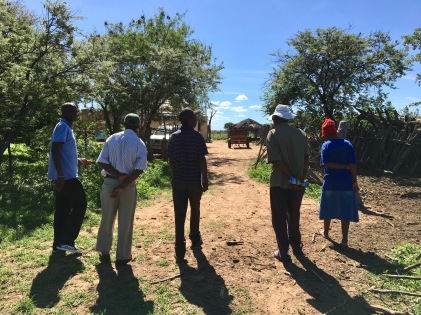
Zimbabwe’s land reform areas twenty years on (summary and reflection), Jun 22

Zimbabwe’s land reform areas twenty years on (A2 areas), Jun 8
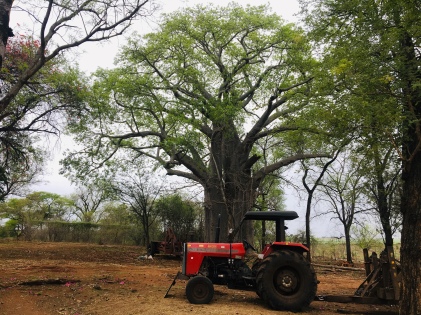
Zimbabwe’s land reform areas twenty years on (A1 informal settlements), Jun 1

Zimbabwe’s land reform areas twenty years on (A1 villagised areas), May 25

Zimbabwe’s land reform areas twenty years on (A1 self-contained areas), May 18
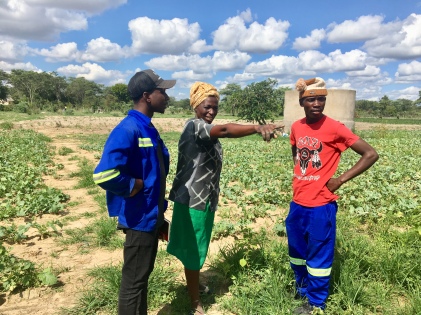
Zimbabwe’s land reform areas twenty years on: Introduction to the blog series,May 11

All photo credit: Ian Scoones
On Wednesday, December 16, 11.00 – 12:00 GMT, a one hour webinar ‘‘The impact of COVID-19 on food systems and rural livelihoods in Africa’ will feature two presentations by John Thompson (SSRP Deputy Director, IDS Fellow and CEO of the APRA Programme) and Imogen Bellwood-Howard (SSRP Member, IDS Fellow and APRA Researcher).
They will discuss recent APRA work, providing policy-relevant insights into the differential impact of COVID-19 in Sub-Saharan Africa.
The presentations will be followed by a question and answer session chaired by Joseph Alcamo, Director of SSRP.
Visit our events page for more information. For more information about this event, please contact ssrp@sussex.ac.uk.
Feature photo credit: World Bank.
Following APRA Tanzania’s recent report on the Impact of COVID-19 on Food Systems and Rural Livelihoods in Tanzania in October, the team has presented further evidence of the effects of COVID-19 on agricultural value chains in Africa.
Researchers Aida Isinika, Ntengua Mdoe, Gideon Boniface, Gilead Mlay, Devotha Kilave, Christopher Magomba and John Jeckoniah attended the Agricultural Society of Tanzania (AGREST) 12th Scientific Conference in Dodoma, 2-4 December 2020, with the theme ‘Unleashing the potential of food systems to enhance intra-African agriculture trade.’
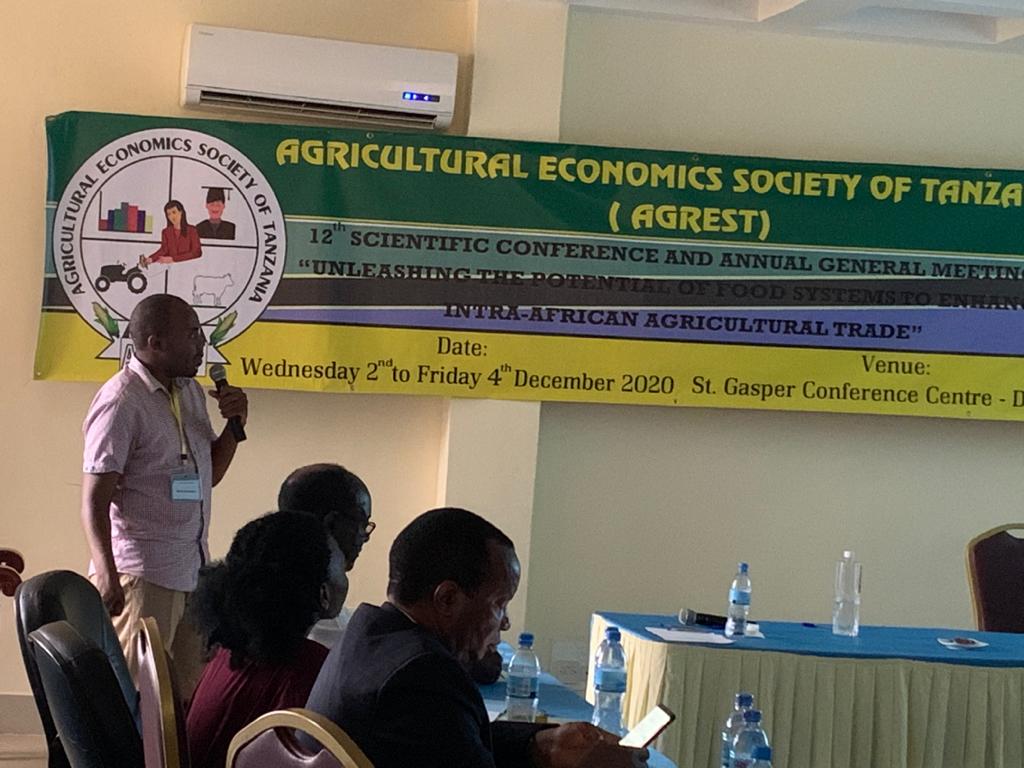
On the opening day of the event, Gideon Boniface presented a paper on ‘Effect of COVID19 on agricultural value chains in Tanzania: The case of the rice value chain in Morogoro region’. Several points were highlighted:
- The COVID -19 crisis brought rice surplus due to significant reduction of trade from neighbouring countries;
- Most traders now depend on the local market, which has also shrunk due to reduced income;
- Farmers’ purchasing power has significantly declined;
- 58% of the respondents reported a decline in their living standards;
- Reduced rice paddy production next year;
- Urgent measures to be taken to address the liquidity problem facing farmers.
The paper was also summarised in APRA Tanzania’s recent two part blog series ‘Rice value chain: has life returned to normal after lifting of COVID-19 restrictions in Tanzania?’ (Click here to read the blogs).
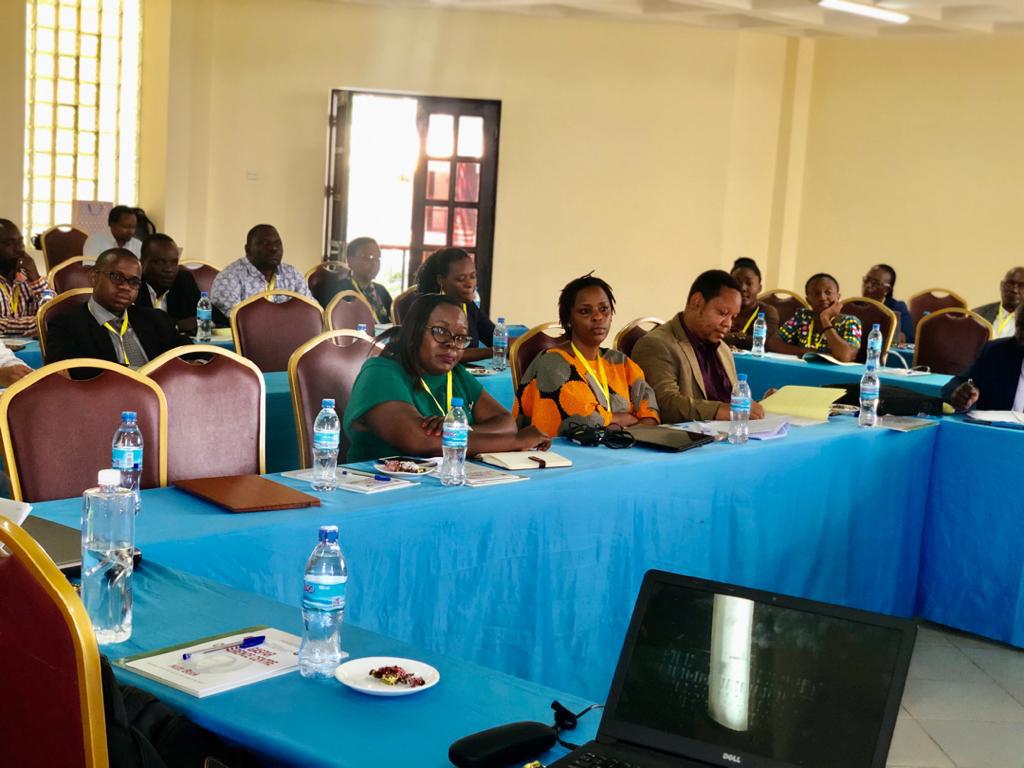
Ntengua Mdoe then presented a paper on ‘Youth participation in commercial rice farming in Kilombero Valley, Tanzania’.
On the second day of the event, Aida Isinika presented a paper called ‘Rice exports, an untapped potential in Tanzania: Factors limiting rice commercialisation in Mngeta, Kilombero valley’.
The APRA presentations were amongst 38 scientific research papers presented to over 80 participants from across Tanzania who attended the conference, including academics, researchers, NGO representatives and government officials led by retired Prime Minister, Hon. Mizengo Pinda, who was the guest of honour.

Goals of conference
The theme of the conference was “Unleashing the Potential of food systems to enhance Intra-African Agricultural Trade.” The outbreaks of the COVID-19 pandemic and the responses to the crisis has created deep structural problems in the way our food system works with the shrinkage of the global and local food supply in particular in many countries, which has resulted in a ‘food emergency’ being declared by the UN.
Conference organisers, AGREST, defined the “food emergency” as, first, the difference between rural and urban food prices due to the break in connection between the food supply in rural regions and the food demand in urban areas. Secondly, they highlighted smallholders’ restricted access to inputs, which disrupted preparations for subsequent production season. Thirdly, they underlined that agri-businesses only had a limited capability to cope with severe disruptions such, as the COVID-19 pandemic.
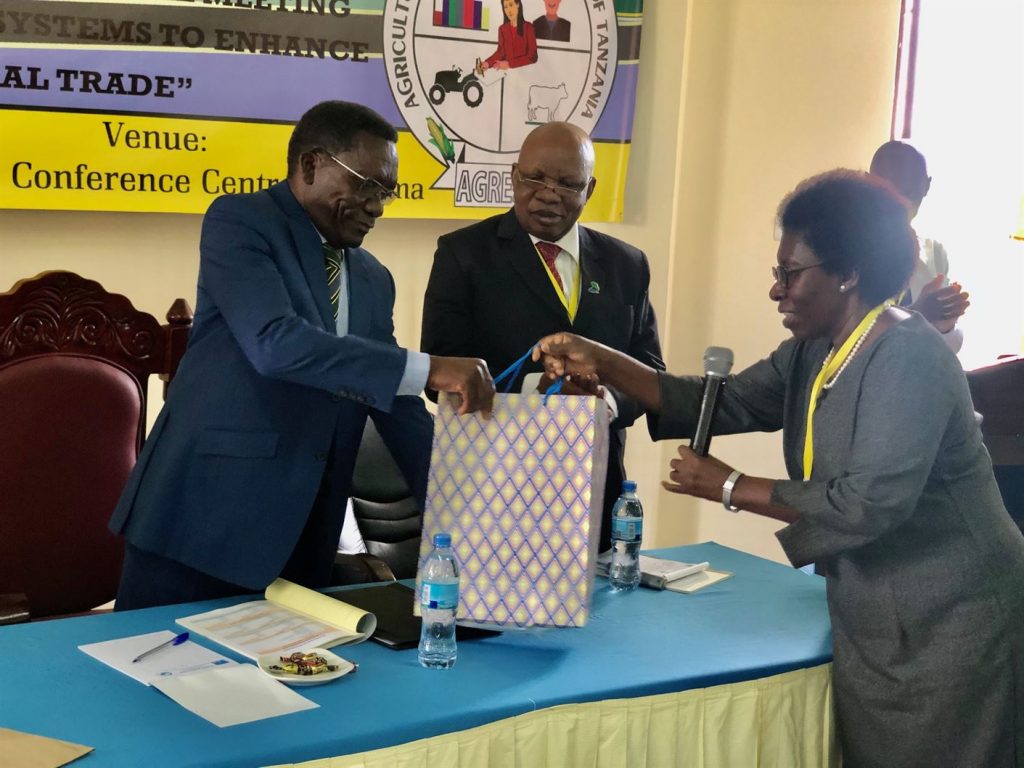
To respond to the situation and seek some answers, the following questions were posed in AGREST’s call for papers for presentation and discussion at the conference:
1. How should food systems be transformed to meet the rural and urban demands while ensuring sustainability?
2. What initiatives have been and or are being taken to ensure that food systems transformations contribute to the attainment of SDGs?
3. What kind of policy frameworks are needed to foster sustainable food systems?
4. How can we better nature domestic and intra-African Trade for improved resilience?
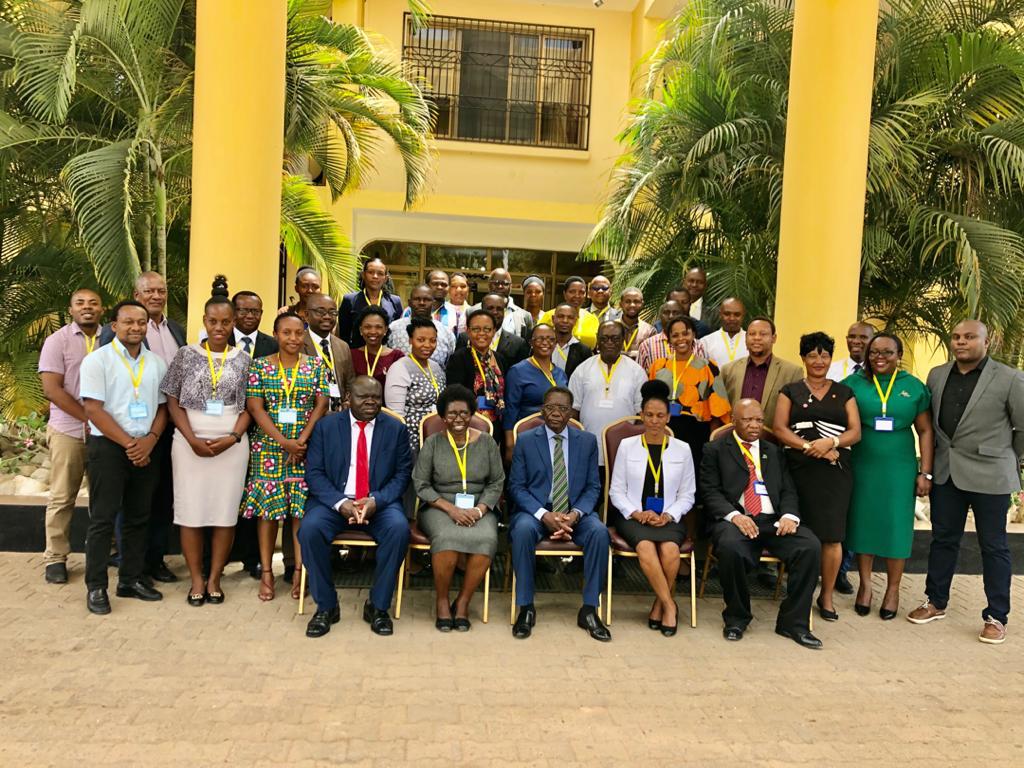
Other conferences attended by APRA
In what was a very busy week for APRA Tanzania, Ntengua Mdoe also presented two papers based on the APRA Study to the Tanzania Animal Science Association (TSAP) and the Tanzania Society of Agricultural Extension (TSAE), in Dodoma, 2-9 December 2020. The papers were: “Agropastoralists and rice commercialisation in Kilombero valley, Tanzania” for TSAP and “The effects of formal education and agricultural extension on rice productivity in Kilombero valley: Implications for agro-industrial development in Tanzania.
Feature photo credit: Calvin Gwabara, SUAMEDIA
In part two of this blog series, APRA Tanzania researchers Ntengua Mdoe, Gilead Mlay and Gideon Boniface use data from follow-up interviews with raw rice traders and the hospitality business in Morogoro and Mbeye regions, before drawing a conclusion on the way forward.
For the first blog on their interviews with farmers, processors and input suppliers, click here.
This blog is linked to APRA Round One and Round Two country reports on the Impact of COVID-19 on Food Systems and Rural Livelihoods in Tanzania.
Read the full APRA synthesis report on the Rapid Assessment of the Impact of COVID-19 on Food Systems and Rural Livelihoods in Sub-Saharan Africa, here.
Written by Ntengua Mdoe, Gilead Mlay and Gideon Boniface
Part two: Experiences from follow up interviews with raw rice traders
Previous COVID-19 blogs have indicated that the Tanzanian Government’s decision to close educational institutions and suspend big social and other gatherings on 17th March 2020 to prevent the spread of the pandemic negatively affected rice businesses.
The decision to remove most of the control measures (listed in part one of this blog series) taken to prevent the spread of COVID-19, effective from 29th June 2020, except the enforcement of the WHO health standards was well received by the rice value chain actors, including those who stepped out of the value chain. This blog highlights experiences of the value chain actors on the effect of the government decision on their businesses through follow-up interviews with the same actors interviewed in June 2020 as presented below
Effect on hospitality businesses
The follow-up interviews conducted by the APRA Tanzania team covered owners of hospitality industry businesses, including hotels, restaurants and other eateries selling rice recipes in Morogoro municipality who were interviewed in June 2020 to determine the effect of COVID-19 control measures on their business. The control measures that affected their businesses included the closure of educational institutions, the ban on big social and other gatherings, restriction of international flights, and the enforcement of the WHO health standards (such as the costs associated with providing washing facilities for clients).
The removal of the first three measures at the end June 2020 led to recovery of businesses in the hospitality industry. The interviewed businesses highlighted the positive effect of the government decision, as the number of customers has been increasing over time. However, they indicated the recovery is slow because of the following reasons:
- Fear of the pandemic among potential customers is still prevailing.
- Low purchasing power of potential customers resulting from low business during period with COVID-19 control measures.
- Travel restrictions prevailing in a number of counties with potential visitors to Tanzania especially tourists.
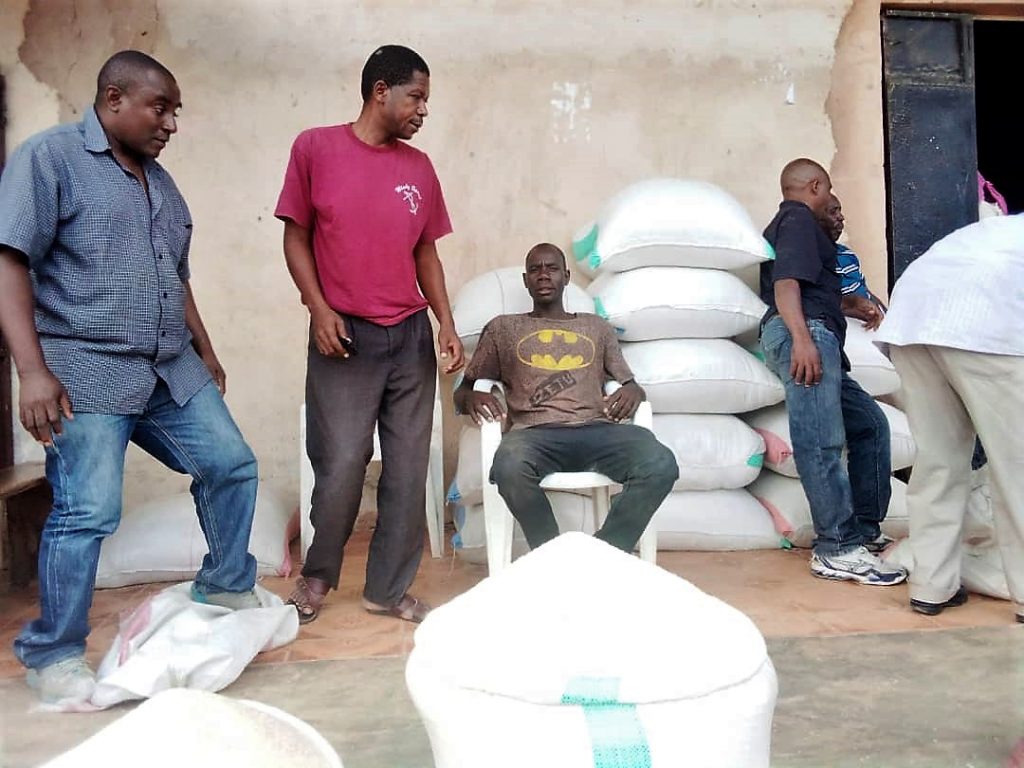
Effect on domestic traders of raw rice
All categories of the interviewed domestic traders of raw rice reported that, contrary to the negative impact experienced before the removal of the COVID-19 control measures, they have been experiencing a slight increase in rice revenue due to an increase in the number of buyers and a slight increase in rice prices. On average, rice retail prices in Morogoro municipality have increased from TZS 1,300 ($0.56) per kg of grade 1 rice during COVID-19 to TZS 1,600 ($0.69) after the removal most of the COVID-19 control measures. However, prevailing prices of low quality rice grades remain unchanged.
Effect on inter-regional (export) traders
The experience of exporters of rice to neighbouring countries of Kenya, Rwanda, South Sudan, Zambia, Malawi and DRC Congo on the effect of removal of COVID-19 control measures is mixed. Some processors have stopped exporting rice despite the removal of the cross-border physical barriers while others are still exporting, although in lower quantities than the pre-COVID period. The interviewed traders who are exporting rice to Zambia reported that the prevailing charge for a truck transporting rice across the Tanzania-Zambia border is more than twice the charge during the pre-COVID period – from TZS 300,000 ($ 128.21) to the prevailing charge of TZS 700,000 ($ 299.15) per 30 tons-truck.
Besides the high transport charges at the Tanzania borders, rice export trade has been affected by a decline in export demand. Most neighbouring countries are still restricting gatherings and movements that are affecting cross-border trade, implying that domestic traders will largely depend on local demand for rice, estimated at about 6 million tons, which is lower than the estimated current supply of about 8 million tons. Like the processors, they have piles of paddy and milled rice in their warehouses. Some of the exporters with processing facilities are resorting to provision of processing services.
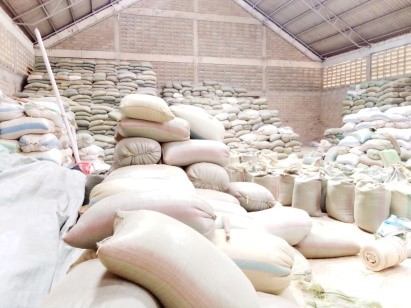
Conclusion
Evidence from the follow-up interviews with the various actors in the rice value chain indicates that the business across the rice value chain is gradually returning back to normal after the government’s decision on 29th June 2020 to remove most of the restrictive measures taken to prevent the spread of the pandemic. However, this gradual revival suggests that a full recovery may take longer, not only due to the COVID19 control measures still existing in neighbouring countries that limit cross border trade, but also due to international travel restrictions in other foreign countries that limit visitors to Tanzania.
This suggests that it is unlikely that most of the businesses will be able to meet their operational costs and meet debt obligations. To sustain the rice business, the actors need liquidity support in terms of accessing and making good use of any government established survival fund for small businesses. The International Monetary Fund (IMF) has funds earmarked for bailing out COVID-19 affected businesses. This should be complemented by a revision of the repayment terms of the funds borrowed by the businesses before the COVID-19 pandemic as directed by the Bank of Tanzania.
Regarding facilitation of cross-border trade, a regional committee has been established to coordinate the implementation of guidelines and facilitate the resolution of operational issues at borders during the COVID-19 pandemic. These guidelines include allowing cargo trucks to cross the borders if they submit certificates from the member state that they have been screened and are have no COVID-19 disease. What remains is authorities at the borders to fast track verification of the certificate to avoid delays at the borders.
Feature photo credit: Nkumi Mtimgwa/CIFOR
Please note: During this time of uncertainty caused by the COVID19 pandemic, as for many at this time, some of our APRA work may well be affected but we aim to continue to post regular blogs and news updates on agricultural policy and research.
Following his blog on the winners and losers in livestock commercialisation in northern Kenya and the accompanying working paper, researcher, pastoral development and dryland management specialist Guyo Roba examines the impact of COVID-19 market risks, explaining how strengthening their resilience is a key priority.
Access this previous blog, and Working Paper 39, here.
This blog is linked to APRA Round One and Round Two country reports on the Impact of COVID-19 on Food Systems and Rural Livelihoods in Kenya.
Read the full APRA synthesis report on the Rapid Assessment of the Impact of COVID-19 on Food Systems and Rural Livelihoods in Sub-Saharan Africa, here.
Written by Guyo Roba
Livestock represent a marketable asset owned by pastoralists in northern Kenya, as well as other arid and semi-arid southern rangelands. Livestock marketing in these rural communities are highly personal exchanges, emphasised by more familiar relations between traders and pastoralists, particularly at the informal markets where the organisational structure or presence of authorities are minimal, and in a more controlled interactions at the formal markets. The latter offer opportunities for buyers and sellers to congregate in large numbers, and trade in substantial volumes. Although the numbers of market participants are usually very high in relatively vibrant markets that are locally referred to as “hot” markets, the number of both the market participants and animals transacted varies from one market to another.
Typically, transactions in these markets involve lengthy negotiations between buyers and sellers, while deals are usually sealed through closer social interactions that involve a seller and buyer holding hands, raising and releasing mid-way to signify closed deal(s). Since most local markets have actors with common ethnic identity, other kinship discussions also take place. As such, markets also attract other people interested in dialogues that go beyond price negotiations to other exchanges related to the potential of grazing lands, animal health, and state of security in specific area. However, such ethnic connections cannot cushion pastoralists to deal with multiple risks, such as supply uncertainty, price volatility, high transaction costs, post-harvest losses and other market risks.
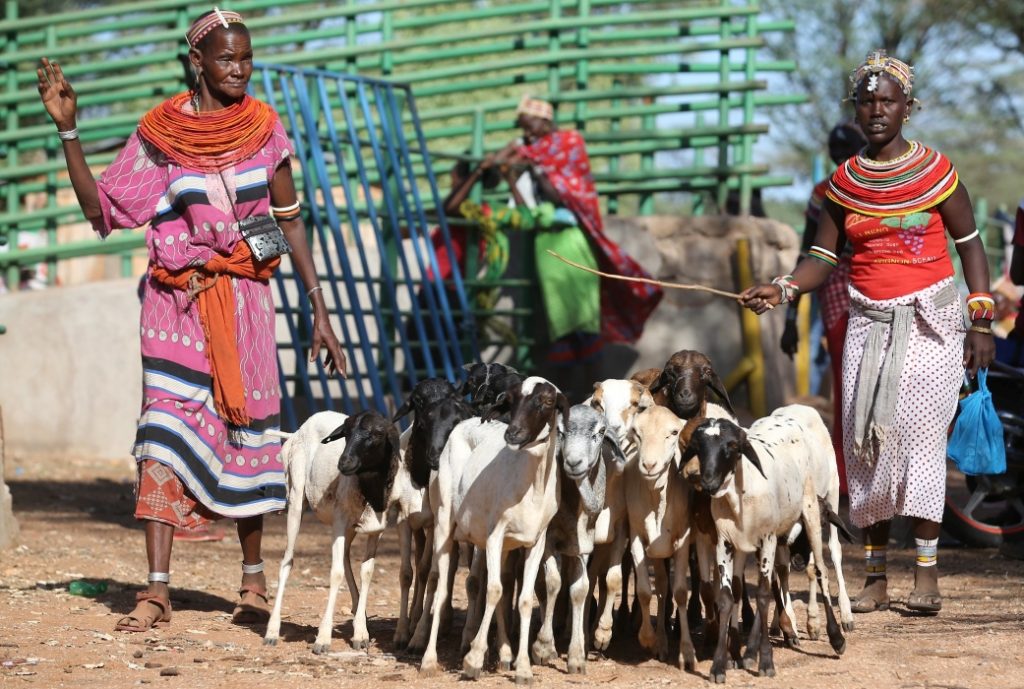
Common risks in livestock trade
Risks are common and highly unpredictable events that distinguish between success and failure in livestock trade. Risks occur at all stages of the marketing channel, from the purchase, collection stage through the transport to their final sale at a terminal market. Several attributes of livestock trade increase risks and the likelihood of losses, including live transportation, the high volume and value of animals moved, and the credit sales and possible payment default at the terminal markets. These risks applies to all, irrespective of the experience of a market actor, the scale and geographical scope of his/her trade activities or affiliation to a particular ethnic group.
In long-distance livestock trade, the risks increase towards the terminal markets. This include the risk of losing animal during the collection, the danger of the animal catching diseases while being hauled over long-distances, livestock thefts, loss from asphyxiation from poor and frequently overloaded conditions of livestock trucks. Weight loss or mortality is also more likely to occur when trucks are delayed for several hours at the multiple police roadblocks.
Although both pastoralists and local traders have adapted to mitigate common risks through strategies like collaboration on purchase and sales, pooling working capitals and sharing of information, the level of risks are aggravated with the emergence of COVID-19 pandemic, which is already disrupting food supply chains, including along pastoral value chains.
COVID-19 reinforces existing risks
The impacts of COVID-19 pandemic in pastoral areas of northern Kenya, due to transport restrictions and quarantine measures, are likely to impede the access of pastoralists to input and output markets, thereby decreasing their cash flow, profit margins and reinforced already precarious situation of pastoral and agro-pastoral households. Shortages of market labour due to COVID 19 travel restrictions have also widened, which could slow market activities, most notably for labour-intensive activity of collecting livestock prior to transportation to terminal markets. COVID 19 movement restrictions have also affected the itineraries of traders from outside pastoral areas to visit and purchase animals. This has led to external traders offering relatively better prices to pastoralist.
Similarly, the closure of international transport routes, particularly the sheep and goats export to Middle East countries may also result in reduced incomes for traders, livestock keepers and other actors along the meat export supply chains. So far, Saudi Arabia, Dubai, Oman, Qatar and Kuwait have all closed their doors to livestock imports from Kenya and other countries in the region.
The intermittent closure of live animal markets by the government have affected the operations of both formal markets as well as informal market in more remote areas and by extension contributed to liquidity challenges among pastoral households and disrupted their livelihoods. Meanwhile, the retention of some level of restrictions such as night curfews makes it difficult for pastoralists and buyers to travel to markets either for fear of being contaminated or because of the high cost of transport. This limits the number of external traders and buyers in local markets and overall affects price competitiveness, household incomes and household purchasing power. Together, these weaken households’ food security and preparedness to manage drought related stress.
Way forward
Strengthening resilience of pastoralists and agro-pastoralists facing the negative impacts of the coronavirus pandemic is a priority. The immediate intervention should aim to maintain productivity and strengthen livelihood and resilience of the vulnerable actors by supporting existing community safety nets. This could entail provision of targeted food support to vulnerable households, short-term credits, subsidies or financial support to assure business continuity for traders, agro-vets, butchers and other actors.
In the long term, strengthening of regional value chains should be a priority to diversify risks and increase resilience to future shocks. ASAL counties should increase investments to fast-track regionalisation of livestock trade, operationalise abattoirs and engage private sector players in bulk meat supply chains. This offers both the alternative trade avenue and ensure seamless connectivity.
Invest in value chain management information systems at national and county levels. The weak information system in livestock trade implied that the social restrictions of COVID-19, led to slump in market activities. As such, investing in appropriate ICT technologies and infrastructures can offer mechanisms to crowdsource market prices to make real-time price information available to buyers and sellers and offer a stronger platform for open purchase and sales orders. Success will result in improved coordination and tighter market linkages that ICT solutions can provide.
Cover photo: Herder drives his goats in Marsabit County. Credit: Credit: Fredrick Omondi
Please note: During this time of uncertainty caused by the COVID19 pandemic, as for many at this time, some of our APRA work may well be affected but we aim to continue to post regular blogs and news updates on agricultural policy and research.
Add this event to your calendar
Wednesday 16 December 11:00 until 12:00 on Zoom
Speaker: John Thompson and Imogen Bellwood-Howard
Part of the series: SSRP Webinar Series on the Pandemic and Sustainability
Register to attend this Sussex Sustainability Research Programme (SSRP) webinar: ‘The impact of COVID-19 on food systems and rural livelihoods in Africa’.
Even before the COVID-19 pandemic struck, the United Nations reported that more than 250 million people in Sub-Saharan Africa faced severe food insecurity. Incomes for farmers were lower in real terms than anywhere else in the world, and more than 30% of children were stunted, partly due to poverty and poor diets.
Since then, the World Food Programme and other agencies have warned that COVID-19 could cause one of the worst global food crises since World War II and predicted a doubling of the number of people going hungry over the next year – more than half of them in Africa.
The Agricultural Policy Research in Africa (APRA) Programme of the Future Agricultures Consortium (FAC), a partnership of over 100 African and UK researchers working on agricultural policy issues, has been conducting a number of comparative studies to assess how COVID-19 measures and restrictions are affecting local food systems, rural livelihoods and value chains.
This one hour webinar will feature two presentations by John Thompson (SSRP Deputy Director, IDS Fellow and CEO of the APRA Programme) and Imogen Bellwood-Howard (SSRP Member, IDS Fellow and APRA Researcher) discussing recent APRA work, providing policy-relevant insights into the differential impact of COVID-19 in Sub-Saharan Africa. The presentations will be followed by a question and answer session chaired by Joseph Alcamo, Director of SSRP.
Register now to attend this free webinar that will take place on Zoom.
For any enquiries about this event, please contact ssrp@sussex.ac.uk.
—
About SSRP
The Sussex Sustainability Research Programme (SSRP) is committed to delivering science for the Sustainable Development Goals (SDGs). Building on the University of Sussex’s tradition of interdisciplinarity, SSRP provides critical research focused on identifying possible trade-offs and synergies among the SDGs for achieving global goals for humanity and the environment. Read the blogs on SSRP’s forum for the pandemic and sustainability.
About APRA
Agricultural Policy Research in Africa (APRA) is a six-year research programme of the Future Agricultures Consortium (FAC). APRA aims to identify the most effective pathways to agricultural commercialisation that empower women, reduce rural poverty, and improve food and nutrition security in sub-Saharan Africa. Through in-depth interdisciplinary, comparative research across nine countries, APRA is generating high-quality evidence and policy-relevant insights on more inclusive pathways to agricultural commercialisation. Find out more and read blogs about APRA’s response to COVID-19.
Feature photo credit: World Bank.
In the first of a two part blog series, researchers from APRA Tanzania follow up on their earlier blog series on the COVID-19 coping strategies of rice value chain actors. In this blog, they use data from follow-up interviews with farmers, processors & input suppliers in Morogoro and Mbeya regions to determine what difference there has been since the easing of lockdown in late June.
Part two examines the effect on the raw rice traders and the hospitality industry, and a way forward. Read it, here.
This blog is linked to APRA Round One and Round Two country reports on the Impact of COVID-19 on Food Systems and Rural Livelihoods in Tanzania.
Read the full APRA synthesis report on the Rapid Assessment of the Impact of COVID-19 on Food Systems and Rural Livelihoods in Sub-Saharan Africa, here.
Written by Ntengua Mdoe, Gilead Mlay and Gideon Boniface
Part one: rice farmers, processors input suppliers and financial service providers
Previous COVID-19 blogs have indicated that the Tanzanian Government’s decision to close educational institutions and suspend big social and other gatherings on 17th March 2020 to prevent the spread of the pandemic negatively affected rice businesses. The effects include but not limited to:
- Complete loss in revenue from food services offered to educational institutions;
- Substantial decline in revenue from provision of food services to seminars and workshops as the measures to control the spread of COVID-19 pandemic limited services to offer to gatherings with a maximum of 15 people;
- Costs associated with provision of washing facilities to clients in accordance with the World Health Organization (WHO) health standards despite limited number of clients;
- Compensating laid-off workers in kind in the form of food items such as rice and beans and;
- Difficulties in meeting loan repayment obligations due to a decline in cash flow.
The decision to remove most of the control measures taken to prevent the spread of COVID-19, effective from 29th June 2020, except the enforcement of the WHO health standards was well received by the rice value chain actors, including those who stepped out of the value chain. This blog highlights experiences of the value chain actors on the effect of the government decision on their businesses through follow-up interviews with the same actors interviewed in June 2020 as presented below
Effects on rice farmers
Telephone interviews with some farmers in Morogoro and Mbeya regions show that they have been experiencing a slow recovery in paddy business since the government decision to remove most of the COVID-19 control measures. The number of traders buying paddy at the farm level has been increasing since July 2020, resulting into increase in farm-gate prices. In Morogoro region, paddy price declined by about 41% as a result of COVID-19 and then increased by 21% after the removal of the COVID-19 control measures while in Mbeya Region, paddy price declined by about 36% as a result of COVID-19 and then increased by 27% after the removal of the COVID-19 control measures as shown in the table below. However, the prevailing prices in both regions are still below the pre-COVID period prices by 29% in Morogoro and 19% in Mbeya. The interviewed farmers indicated that their purchasing power for rice production inputs has declined significantly as they have to sell more rice to purchase the same amount of inputs such as fertilisers they purchased before the COVID-pandemic.

Effect on input suppliers and financial service providers
The interviewed suppliers of rice seeds, fertilisers and pesticides in major rice producing regions of Morogoro and Mbeya indicated that the removal of the COVID-19 measures has had little impact on their business because the new rice season is just starting. However, they thought a decline in demand for rice production inputs, due to the prevailing low paddy prices, very likely. However, financial service providers indicated a positive effect from the removal of most COVID-19 control measures, as many actors (farmers, traders and processors) with outstanding loans are gradually meeting their credit obligations.
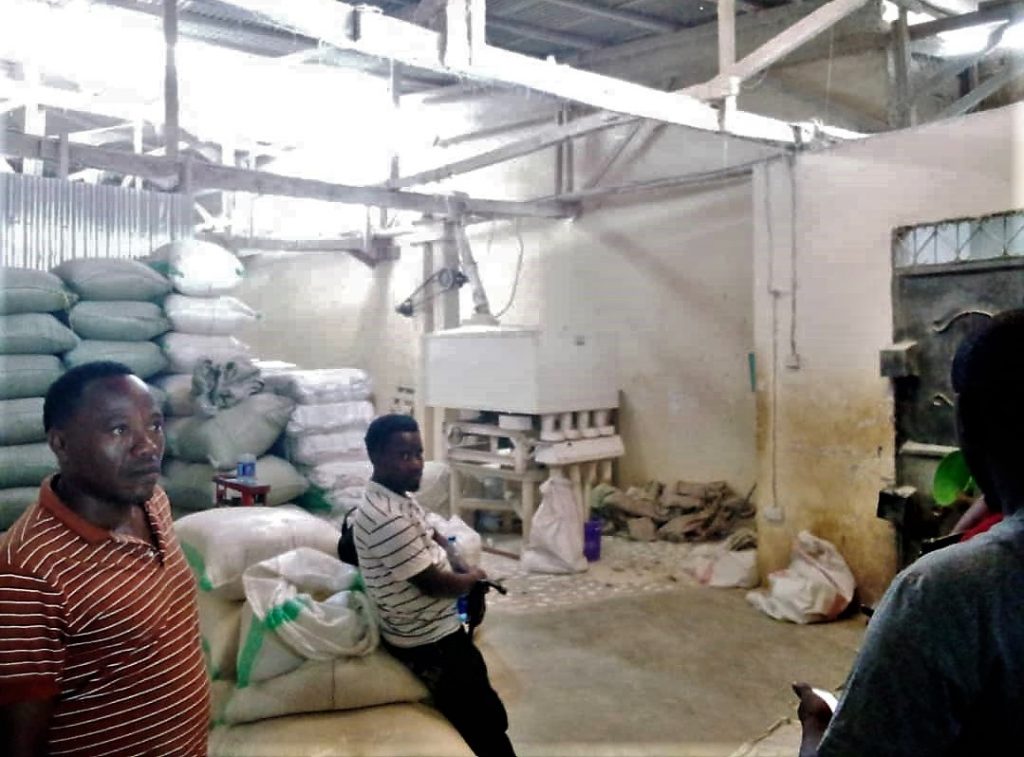
Effect on rice processors
Like rice farmers, rice processors have been experiencing a slow recovery of their businesses since the end of June 2020, when the government removed most COVID-19 control measures. All of the interviewed processors were operating under capacity, despite the increase in the quantity of processed rice compared to when the restrictions were active. However, the current operating capacity is still below the pre-COVID-19 period capacity (before March 2020). Most of the processors have large stocks of paddy in their warehouses awaiting processing when business returns to normal. They indicated that they were facing financial cash flow problems, thus failing to cover operational costs or to pay outstanding loans.
The second blog in this series looks at the effect of the lifting of COVID-19 restrictions on the raw rice traders and the hospitality industry.
Cover photo credit: Malingerist on Flickr
Please note: During this time of uncertainty caused by the COVID19 pandemic, as for many at this time, some of our APRA work may well be affected but we aim to continue to post regular blogs and news updates on agricultural policy and research.
This post was written by Ian Scoones and first appeared on Zimbabweland.
I had another catch-up with colleagues in Zimbabwe recently, reflecting on the COVID-19 situation and its consequences across our sites in Masvingo, Gutu, Mwenezi, Matobo and Mvurwi. This is now the fifth update since March/April (see summary so far here).
The pandemic has not proceeded as some feared in Zimbabwe, and recorded case numbers (at 8471 on November 6) and deaths (at 250) are still low. There is much speculation about how and why the pandemic took a different course across Africa, and in future blogs we will explore some of these hypotheses in relation to the Zimbabwe setting.
As colleagues mentioned during the call, “We really don’t know any cases where we live, even in the hospitals and clinics. We don’t see people sick with the virus so far”. What is feared is the return of migrants from South Africa plus visitors from Europe and the UK during the holiday season. “We hope the government will be strict. There are requirements for test certificates, but you know they can always be cheated.” The importance of flows of people from outside the country is certainly central to the COVID-19 story in Zimbabwe, as we have discussed in previous blogs.
Zimbabwe is still under partial lockdown, with road blocks and movement restrictions in place, even though curfews and business opening hour regulations have been relaxed. The police are very present, and particularly engaged in checking permits especially of cross-border traffic in towns like Masvingo. With the weather being very hot last week before the rains, it was commented that “many had given up wearing masks, and relied on the heat as a ‘natural sanitiser’”. As one colleague observed, “It’s difficult to continue protecting ourselves when we don’t see the impacts of the virus”.
Diversified livelihoods
This blog focuses on the situation in the period since the last update on September 27, with a particular focus on the livelihood impacts of lockdown on women and young people. The standard approaches to raising funds to support families by women and young people have been insufficient, as COVID-19 restrictions have hit hard. Diversification beyond agriculture is key, offering new livelihood options. Below are some examples of occupations taken up during the pandemic in our sites, especially by women and young people, to support their livelihoods.
Fruit and veg. Diversification of livelihoods has been vital, since traditional occupations for women and young people have been constrained during lockdown. For example, while vending remains important for women, cross-border trade that used to be a mainstay in the border areas such as Mwenezi and Matobo is no longer feasible. Some have diversified, so for example dry season sales of wild fruits has expanded along the roads near Gutu, as women and children harvest matamba and mushuku, both selling for a US dollar for a handful of fruit.
Similarly, gardening continues as a vital source of self-provisioning with major nutritional benefits. As we have reported before, nearly everyone is a gardener now, whether in town or the rural areas, although women and youth are the dominant gardeners it seems. However, the expansion of gardening, combined with restrictions on market (again discussed in earlier blogs) has resulted in local gluts, particularly during the recent dry season – which is the traditional focus for gardening activities. The result is that women in particular have had to innovate, and develop new ways of processing and storing vegetables and fruits to sustain income over a longer period across seasons, and through variable market conditions.
Gold and amethyst. Small-scale mining is an essential activity for young people, mostly men. However, over the past few months a surprising development has been the movement of women into mining activities. Our colleague in Matobo reckons perhaps a fifth of miners are now women. While the mining claim owners of course are by-and-large well-connected older men, who manage the claim through a system of sharing with a group of contractors, women and young people join syndicates and provide labour. Most mining is of gold and in these cases half is shared with the owner, while the rest is divided amongst the group who did the mining.
Gold mining has expanded massively in all sites, including a recent huge expansion around Masvingo town. One young man, RB, relayed his story:
“I had been a driver for three years, but I lost my job because of lockdown. The transport businesses just collapsed. My wife and kids went back to the rural home as I could not support them in town. But in the last six months I have started mining outside town. I work with a group of five and we share the ore, milling it locally. If you work hard you can earn US$1400 per month, even when giving half to the claim owner. I have bought a car and I have plans to buy a stand. My family came back two weeks ago and are with me now. Life is now good!”
In Chikombedzi area in Mwenezi there has been a massive rush to mining sites where purple amethyst deposits have been found. Around a thousand people are living there, with markets developing for food, as well as services including transport, machinery hire and sex work. With amethyst quartz rocks being sold for about R1800 per kg, it has become a lucrative business.
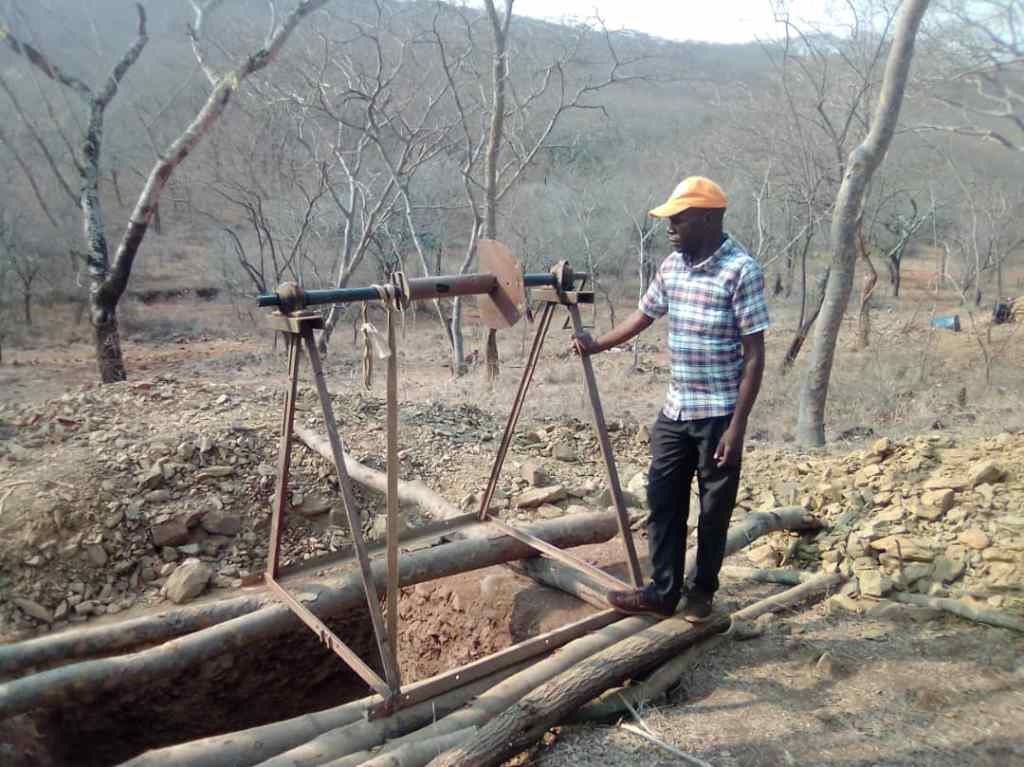
Brick-making and building. With the flood of migrants coming back from South Africa and neighbouring countries, as well as from urban areas across Zimbabwe, during the pandemic due to the loss of jobs, the demand for building in the rural areas has sky-rocketed. These dispersed COVID-19 ‘refugees’ have returned home, but need somewhere to live. This, in turn, has generated a big demand for local ‘farm bricks’, which are cured and sold on to builders. In Wondedzo, a thousand bricks were being sold for around US$25. Brick-making has become an important source of income during this past dry season for both women and youth, who take on different roles between digging, moulding and firing in kilns, with each kiln producing 5-10,000 bricks each time.
Chickens and pigs. Poultry is another area where women and youth have invested considerably in recent months as there has been a growth in demand for local supplies of poultry. In part this is because of the closure of butcheries and the difficulty of getting to town, and in part because local sources of meat have been hit hard by the mass mortalities of cattle due to ‘January disease’ during the past wet season. The abbatoirs are also closed too; indeed one near Masvingo has been converted into a gold milling plant reflecting the switch in livelihood activities.

Mrs C. based in Masvingo explains how she moved from having under 30 chickens to over 300:
“I am a teacher, but my salary doesn’t pay. My husband who used to work on cross-border buses also lost his job due to COVID. I decided to expand my flock, buying up ‘road-runner’ indigenous chickens. I now have three breeds, two from a supplier of day-old chicks in Bulawayo and one from Mr M who supplies from a nearby growth point. I buy these for between 55 and 80 US cents per chick, along with some feed. These breeds though don’t need expensive feed and medicine, so I don’t have to go to town. I now make US$200 per month and am planning to expand further. I have already started a small piggery project to complement. I am thinking of quitting teaching, as this really pays”.

Bread and buns. With access to town restricted and movement difficult, baking has become another big cottage industry in rural areas and urban locations, and an important income source for women. In Chatsworth in Gutu for example a government training course encouraged women to take this up, and baking at home of bread and buns has expanded massively since. Across our sites you can buy bread, buns and cakes from people’s homes, as local people have taken on the supply.
Piece-work employment. While conventional jobs are scarce, there have been other sources of employment emerging, even in the dry season when agricultural piece-work options are generally limited. In particular, hiring of labour for digging holes for the Pfumvudza programme (a major government-led initiative with donor support on conservation agriculture – watch out for blogs on the experience of this in the coming weeks) has become important in all our sites.
Young people in particular have been able to benefit, with digging pits in one plot (39m x 16m) being charged at between US$5 at US$20 depending on the soil type and location, with payment in cash or kind (mostly soap and sugar). It is young men in particular who are benefiting from this, as older people often prefer to pay for the labour in order to get the free seeds and fertilisers.
Money matters
Saving and circulating money is a big challenges, as access to towns has reduced. There has therefore been a big growth in various forms of ‘savings clubs’ in the past months across all sites, which particularly involve women. For example in Wondedzo area near Masvingo, 20 women pooled cash and members draw funds to finance projects, paying interest on the amount of around 20%. In Masvingo town meanwhile there are lots of such clubs, some church-based, some just amongst a group of individuals. One group involves six female civil servants, mostly teachers, who save 150 Rand every two weeks, and one member takes out the full amount each fortnight to fund activities.
Money for new activities is crucial; without employment and with banks closed or difficult to get to from rural areas or townships, then new forms of managing money becomes important. New regulations that restrict the amount of phone lines for mobile ecocash money transactions and the electronic transfer tax also dissuades people from using electronic means. Instead very localised systems for saving and circulating cash – all in foreign exchange, either Rands or US dollars depending on the location – is the alternative.
And it’s women in particular who are the key players in this new savings and credit economy, as they in particular need funds for new projects to enhance their livelihoods.
Lockdown challenges
As we have discussed in earlier blogs, lockdown has not all been plain-sailing. Not everyone is able to innovate, earn money and do better than before, as with RM the young miner and Mrs C the poultry producer introduced above.
Our colleagues report in particular the many tensions that have arisen within families. With relatives coming back from South Africa and elsewhere they have to be accommodated and supported. Extra mouths to feed and people to house in a time a crisis. While the COVID-19 migrant-return situation has not been widely reported, as people have dispersed to multiple homes across many locations, the absorption of many thousands of people into a poor, local, mostly rural economy has had a big impact economically and socially.
Those returning, used to working in big cities south of the Limpopo may not be happy with a new rural existence, something they escaped before. Among (mostly male) youth, both returnees and local residents, our colleagues reported a rise in drug taking, drinking and general depression. This has led to arguments and sometimes violence. A rise in pregnancies among young women and teenage marriages have also been reported. Boredom and lack of opportunity, along with an inability to travel, even move to the local town, play into a negative, potentially destructive, social dynamic affecting many young people.
Not all migrants have been able to return, however, and some have been trapped in South Africa, unable to move. In our study areas near the borders – Matobo and Mwenezi – in the past men would move back and forth between often temporary jobs in farms and mines in South Africa, or to Mozambique or Botswana. Today this flexible movement is no longer feasible. Men are locked in South Africa in particular, while women are locked down at home. Adulterous affairs among both men and women have expanded, resulting in arguments, occasional violence and many reported divorces.
Unlocking opportunities during lockdown
Despite the very clear lockdown challenges, the pattern seen across sites is one of innovative survival, and sometimes more. As one informant from Masvingo explained: “Lockdown has unlocked the entrepreneurial spirit! We can now earn good cash. I am not looking back!”
The transformations precipitated by COVID-19 lockdown have therefore not all been negative. As people have innovated to survive, new options have emerged, focused on new markets – whether building for returning migrants, supplying chickens or vegetables in the rural areas. With a shift to local production, short market/value chains and extending the range of activities – from mining to baking – the rural economy, and its connections to urban areas, has shifted significantly over the past seven months.
There is therefore a new COVID economy – and with this new social relations, with both opportunities and challenges. We will keep an eye on these developments over the coming months as the dry season moves (hopefully) into a rainy agricultural season, exploring whether these changes are temporary – a response to a crisis – or more long-term, shifting the terms, roles and incentives in economic activities over time, with new opportunities, especially for women and young people.
Thanks to the team in Matobo, Mwenezi, Mvurwi, Gutu, Wondedzo and Masvingo for contributing insights to the blog.
Credit for all photos: Ian Scoones.
Three weeks since the Malawian government was brought to task by the national press following an APRA brief on agricultural policy, the APRA Malawi team has featured in The Nation Paper once again.
Appearing under the headline “Covid-19 chokes food Systems, livelihoods” both in the newspaper edition and on their website, the news article highlighted a new APRA report on Impact of COVID-19 on Food Systems and Rural Livelihoods in Malawi. Written by APRA Malawi researchers Mirriam Matita and Masautso Chimombo, the report estimates the likely impact of the pandemic on food systems and livelihoods in Malawi.
The two-page report, is based on a random selection of 114 household heads involved in groundnut production in Mchinji and Ntchisi districts and other key informant interviews. The authors indicate that about 60 percent of farmers reported a decline in business activities, which means they could not raise enough income for their livelihoods.
The newspaper article, published on 20 October 2020, highlights from the report that there has been an increase in transport costs as well as decline in number of traders coming to villages for farm produce purchases affecting incomes.
The article also emphasised that the significant decline in the availability of extension services that was show in the report, with 70 percent of respondents mentioning a lack of credit facilities, which could affect the outcome of the upcoming 2020/21 farming season.
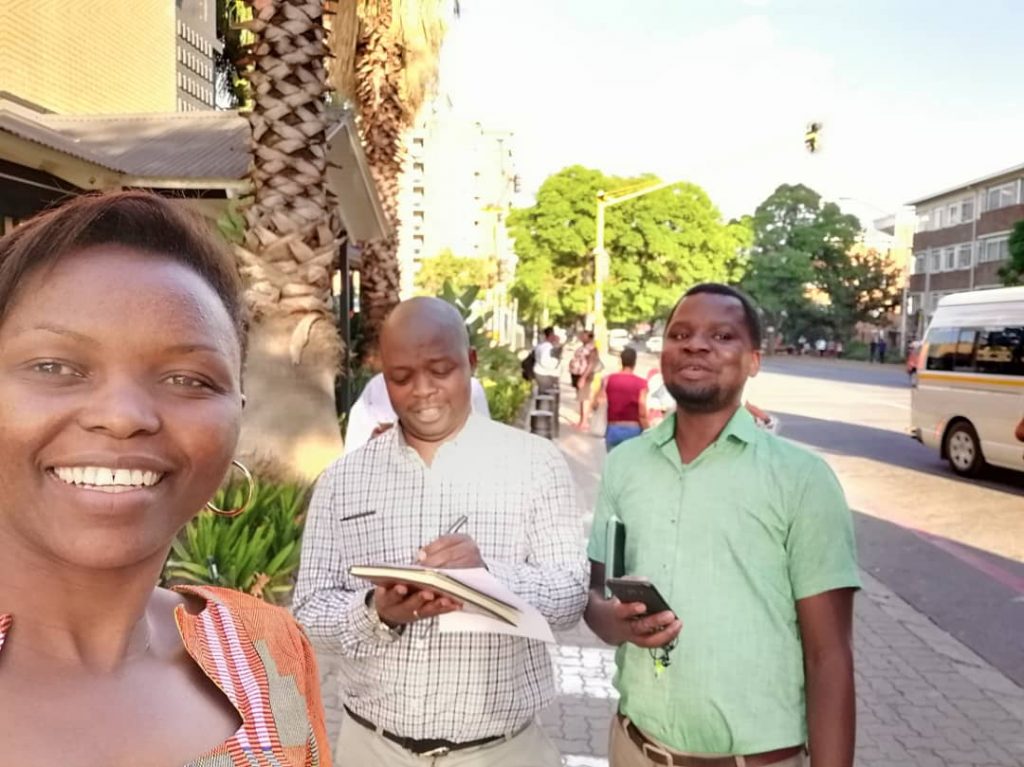
Both researchers responded to the media attention:
“… the Nation newspaper has for 5 consecutive years been winning print media house of the year in Malawi. It enjoys massive readership by both ordinary people, policy makers and politicians. It feels good to have our research product covered by them. This means we are building our name as emerging researchers, and this will open up more opportunities for us …”
Masautso Chimombo
‘… I am excited our work is finding space in local media and I hope it reaches those that need to make decisions to ease COVID impacts on small farmers…’
Mirriam Matita
The report was released alongside several other short APRA studies on how COVID19 is affecting food systems in different APRA countries. To access these reports, click here.
Access the new APRA COVID Malawi report, here
Cover photo credit: IFPRI
Written by, Vine Mutyasira.
COVID-19 has undoubtedly affected lives and livelihoods across the globe. In Zimbabwe, preliminary indications point to a worsening economic situation in a country already facing macroeconomic challenges, particularly in rural communities where most households depend on agriculture. National lockdown and movement restrictions have affected agricultural activities as well as access to markets and farming inputs.
Written by, Gideon Boniface and C.G. Magomba.
The first case of COVID-19 in Tanzania was confirmed in March 2020. The government immediately imposed restrictions on mass gatherings, suspended international flights and established special medical camps for COVID-19 patients. They also published guidelines and health measures to be followed by citizens and emphasised these through media and physically through local government officials located across the country.
Written by, Mirriam Matita and Masautso Chimombo.
Given the ravaging effects of the COVID-19 pandemic worldwide, this study seeks to estimate its likely impact on food systems and livelihoods in Malawi. This briefing note is based on our stratified random sample of 114 household heads (32 female and 82 male) drawn from an APRA household survey of groundnut producers in Mchinji and Ntchisi districts, Central Region, as well as seven key informant interviews from those areas. The APRA COVID-19 data collection will be carried out over three rounds. This report presents insights obtained from the first round of research conducted during June/July 2020.
Written by, John Olwande.
Kenya confirmed its first case of COVID-19 on 12 March 2020. Since then, the government has been providing daily updates on the number of new COVID-19 infections, recoveries and deaths in the country, as well as implementing several interventions to manage the disease. The cumulative numbers as of 12 August 2020 were 27,425 new infections, 13,867 recoveries and 438 deaths, and rising. The objective of this assessment was to understand the effects of COVID-19 on the food system and the sub-set of the population largely dependent on agriculture. The findings were intended to inform actions to assure protection of rural livelihoods and
the continued supply of adequate and affordable food of acceptable quality to the population.
Written by, Louis Hodey and Fred Dzanku.
Given the ravaging effects of the COVID-19 pandemic worldwide, this study seeks to estimate its likely impact on food systems and livelihoods in south-western Ghana. Our sample consisted of 110 female and male respondents drawn randomly from an APRA household survey of oil palm producers in the Mpohor and Ahanta West Districts in the Western region, as well as a set of five key informant interviews. Data collection for this study will be carried out over three rounds. This report presents insights obtained from the first round conducted during June/July 2020.
Written by, Abebaw Assaye and Dawit Alemu
This report presents an early assessment of the impacts of the COVID-19 pandemic on agricultural commercialisation, food and nutrition security, labour and employment, and poverty and well-being in rural Ethiopia. Data was collected from a stratified random sample of 107 households (23 female- and 84 male-headed). Respondents were drawn from a subset of households interviewed in a 2018 APRA survey of smallholder rice farmers in five kebeles (villages) in the Fogera Plain area of Amhara Region. The COVID-19 household survey data is complemented by data from 23 key informant interviews conducted in the kebeles. The data collection for this COVID-19 study will be carried out over three rounds. This report presents insights obtained from the first round conducted during late June/early July 2020.
Written by, Adebayo B. Aromolaran and Milu Muyanga.
This report presents an early assessment of the impacts of the COVID-19 pandemic on agricultural commercialisation, food and nutrition security, labour and employment, and poverty and well-being in rural Nigeria. Data was collected from a stratified random sample of 110 respondent households drawn from five Local Government Areas (LGAs) in Ogun (Ijebu East, Obafemi Owode, and Imeko Afon) and Kaduna (Chikun and Soba) States. At the time of the survey, these LGAs had reported a small number of COVID-19 cases. The survey data is complemented by insights from five in-depth key informant interviews conducted in the LGAs. The APRA COVID-19 data collection will be carried out over three rounds. This report presents insights obtained from the first round implemented during mid-July 2020.
Written by, Marco Carreras, Amrita Saha and John Thompson
To gain a better understanding of the impact that COVID-19 is having on food systems and rural livelihoods in the region, researchers in the Agricultural Policy Research in Africa (APRA) Programme of the Future Agricultures Consortium (FAC) are conducting a rolling series of telephone-based household surveys and key informant interviews in selected study locations across multiple countries. This report presents results from the first round of that research in seven countries – Ethiopia, Ghana, Kenya, Malawi, Nigeria, Tanzania and Zimbabwe – from interviews conducted in June-July 2020.1 APRA will monitor the situation as the pandemic unfolds through further rounds of data collection and analysis in late 2020 and early 2021.
In the second of a two-part blog series, APRA researchers Louis Hodey, Kofi Asante & Fred Dzanku look at the responses of agribusinesses and farm households to the pandemic, how the Ghanaian government has responded, and offer policy recommendations for the way forward.
For part one on the impact on food prices, agribusinesses and household incomes, and food and nutrition security, click here.
This blog is linked to APRA Round One and Round Two country reports on the Impact of COVID-19 on Food Systems and Rural Livelihoods in Ghana.
Read the full APRA synthesis report on the Rapid Assessment of the Impact of COVID-19 on Food Systems and Rural Livelihoods in Sub-Saharan Africa, here.
Written by Louis Hodey, Kofi Asante & Fred Dzanku
What has been the response of agribusinesses and farm households?
As expected, decline in sales and general agribusiness activities have had huge implications for employment and the mode of operation of these businesses. According to the Ghana Statistical Service (GSS), wage cuts, laying off workers, adoption of digital solutions for sales, and the use of mobile money services have been some survival strategies adopted by firms (including agribusinesses) in response to the threats from the COVID-19 pandemic. An APRA-CASA (Commercial Agriculture for Smallholders and Agribusiness) rapid market survey conducted in May also found that a few agribusinesses took advantage of the pandemic to boost their incomes by diversifying production. For instance, some artisanal oil palm processors started producing soap to tap into demand which had remained unmet because of the disruption in supply of consumer necessities. However, such opportunities were only available to agribusinesses with sufficient ready capital for a new production line or the technological capabilities for online marketing or sales. These differences in the ability of farmers and agribusinesses to quickly respond to the impact of the pandemic is like to widen inequality in the short to medium term.
According to the Chamber of Agribusiness Ghana (CAG), critical coping strategies adopted by agribusinesses include direct delivery of products and services to customers via courier services, e-commerce platforms, as well as price reductions and discount sales in some cases. For farm households, a key response strategy to the livelihood challenges imposed by the COVID-19 crises has been a reduction in food consumption. According to the GSS, more than a half (52.1%) of households reduced their consumption in order to cope with the effects of COVID-19. Other key coping mechanisms adopted by households (according to the GSS) include reduced non-food consumption, reliance on savings, assistance from family / friends, borrowing from family / friends, credit purchases, engagement in additional income generating activities, delayed payment obligations and sale of assets.
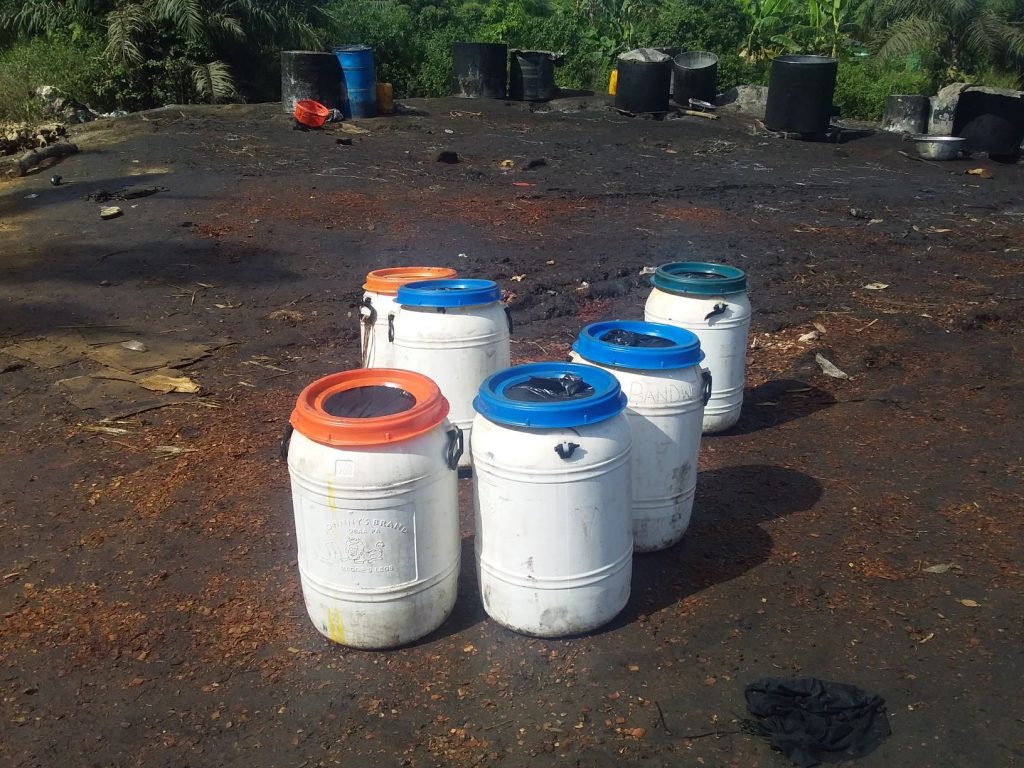
What has been government’s response so far?
Government policy is critical to tackle the threats to livelihood caused by the pandemic. In addition to substantial health spending to contain the coronavirus in Ghana, the government has so far implemented key relief programmes to mitigate the severe impact on everyday living. These include electricity subsidies, free water, soft loans for small and medium scale businesses through the Coronavirus Alleviation Programme (CAP), free hot meals for the most vulnerable during the partial lockdown, free hot meals for final year basic school students and their teachers, tax holidays for frontline health workers, among others. It is expected that these policy interventions will cushion households and businesses to mitigate the economic hardships imposed by the COVID-19 crisis. But how much of this is enough and how many citizens can it cover? In fact, according to the GSS, only 3.5%[1] of firms surveyed reported receiving some support from government.
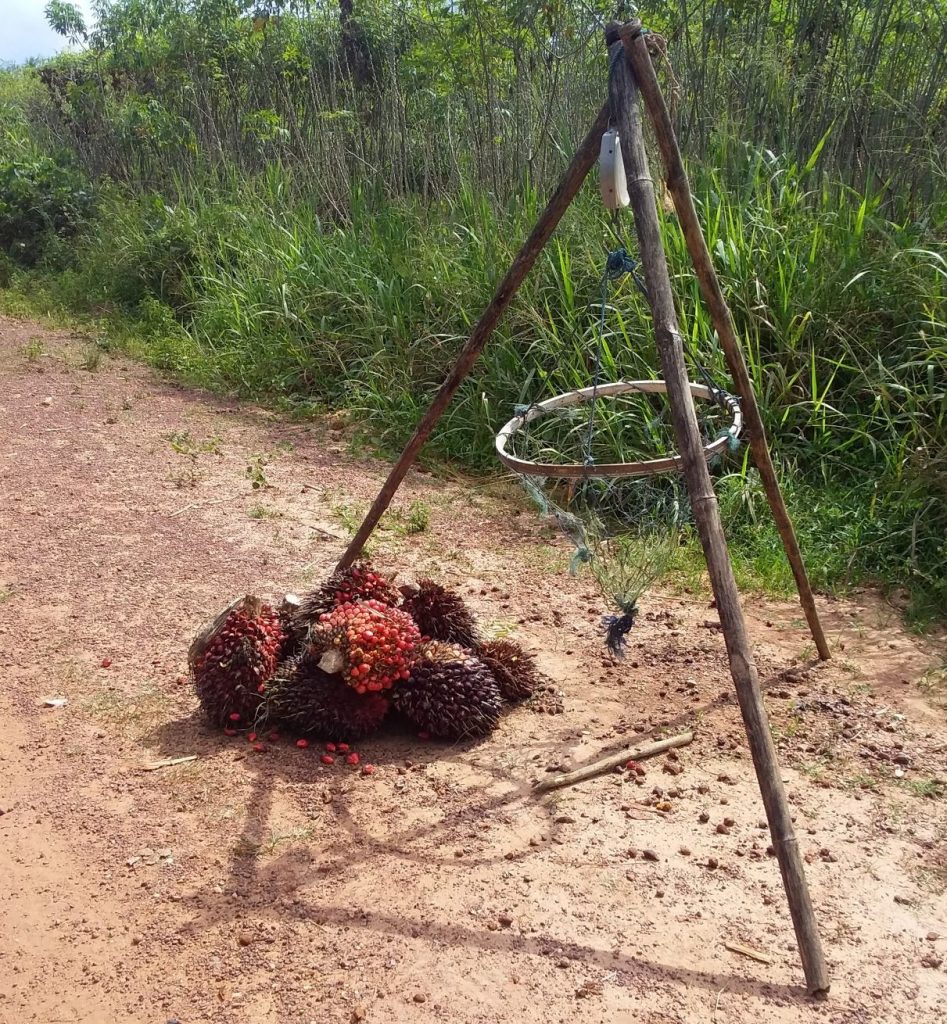
What is the way forward?
Given that almost a half (45.6%) of Ghana’s population are multidimensionally poor, the severe economic hardship imposed by the COVID-19 is expected to further worsen this already dire situation. The World Bank estimates that worldwide, about 100 million people are expected to fall into poverty as a direct impact of the COVID-19 crisis. This suggests that the estimated global poverty would jump from 8.23% in 2019 to 9.18% in 2020. Further, according to the World Bank, though the SSA appears to have weathered the health impact of the pandemic fairly well, it is projected to be the region hit hardest in terms of increase in extreme poverty. In Ghana, the nationwide COVID-19 business tracker survey report by the GSS suggests that some firms (including agribusinesses) are laying-off workers while others are offering pay cuts in order to survive the consequences of the pandemic. With a generally weak social protection system in Ghana, this may lead to increasing poverty levels and worse living conditions for the affected households. In addition, the falling income levels and worsening food and nutrition insecurity situation widely associated with the COVID-19 crises is worrying.
It is rather unfortunate that though farm households toil to feed the country’s population, their living incomes are unable to push them out of poverty. It is important that as the pandemic spreads, institutions of state work to ensure a continued functioning of the country’s food supply chains to avert a possible food crisis in the future. This requires sustained coordinated policy responses to support agribusinesses and livelihoods of farm households. To ensure effective and efficient livelihood supports, government’s relief policies should be inclusive and aim at boosting both demand (consumption) and supply (production) sectors of the economy. Though the government have made efforts to alleviate the adverse livelihood impacts of the pandemic, there are concerns about the ability of these interventions to truly assist the most vulnerable. Critically, policies targeted at improving the capacity of agribusinesses and farm households to boost productivity should be core to the government’s policy agenda.
[1] The Government of Ghana later implemented the Coronavirus Alleviation Programme (CAP) which was still in its initial launching stage at the time of the GSS survey, so this figure might have improved after the CAP implementation.
Feature image credit: Louis Hodey
Please note: During this time of uncertainty caused by the COVID19 pandemic, as for many at this time, some of our APRA work may well be affected but we aim to continue to post regular blogs and news updates on agricultural policy and research.
In the latest of a series of COVID19-related blogs, APRA Ghana researchers Louis Hodey, Kofi Asante & Fred Dzanku examine the implications of the pandemic on agriculture-based livelihoods in the first of a two-part blog series, including the impact on food prices, the impact on agribusinesses, household incomes, and food and nutrition security.
For part two on the responses of agribusinesses and farm households to the pandemic, how the Ghanaian government has responded, and policy recommendations, click here
This blog is linked to APRA Round One and Round Two country reports on the Impact of COVID-19 on Food Systems and Rural Livelihoods in Ghana.
Read the full APRA synthesis report on the Rapid Assessment of the Impact of COVID-19 on Food Systems and Rural Livelihoods in Sub-Saharan Africa, here.
Written by Louis Hodey, Kofi Asante & Fred Dzanku
Background and overview
The devastating impact of the COVID-19 pandemic has affected all aspects of life in Ghana as in other countries. After confirming its first two positive cases in March 2020, the government quickly introduced measures to contain the virus, including a three-week partial lockdown of Accra and Kumasi (the country’s two major cities which emerged as epicentres for the virus), including:
- Restrictions on movement;
- ban on all public gatherings (e.g. political rallies, funerals, schools and religious meetings);
- closure of schools;
- closure of borders / travel bans;
- strict social distancing, contact tracing and mandatory quarantine of all travellers into Ghana and infected persons;
- compulsory wearing of face masks in public places, and;
- enforcement of strict hygiene protocols such as regular washing of hands and the use of hand sanitisers.
The economic impact of these restrictions has been devastating. On 27th August 2020, Ghana’s case count stood at 43,841. In spite of these numbers, the government has already eased a lot of restrictions (for instance, partial reopening of schools for final year students, permission of public gatherings under restricted conditions etc.) and is in consultation with stakeholders to ease the restrictions further down the line.
Impact of the COVID-19 on agricultural-based livelihoods in Ghana
Household Incomes
Household incomes in Ghana have been severely hit by the COVID-19 pandemic. Evidence from the Ghana Statistical Service[1] (GSS) suggests that 77.4% of households (approximately 22 million people) in Ghana have experienced declines in income since the COVID-19 restrictions were introduced in March 2020. Given existing high levels of income poverty in Ghana, especially among rural populations dependent on agriculture, these declines in household incomes will further deepen the prevailing precarious living conditions of poor rural farm households. With increasing costs of living associated with the COVID-19, livelihoods of poor households are severely threatened.
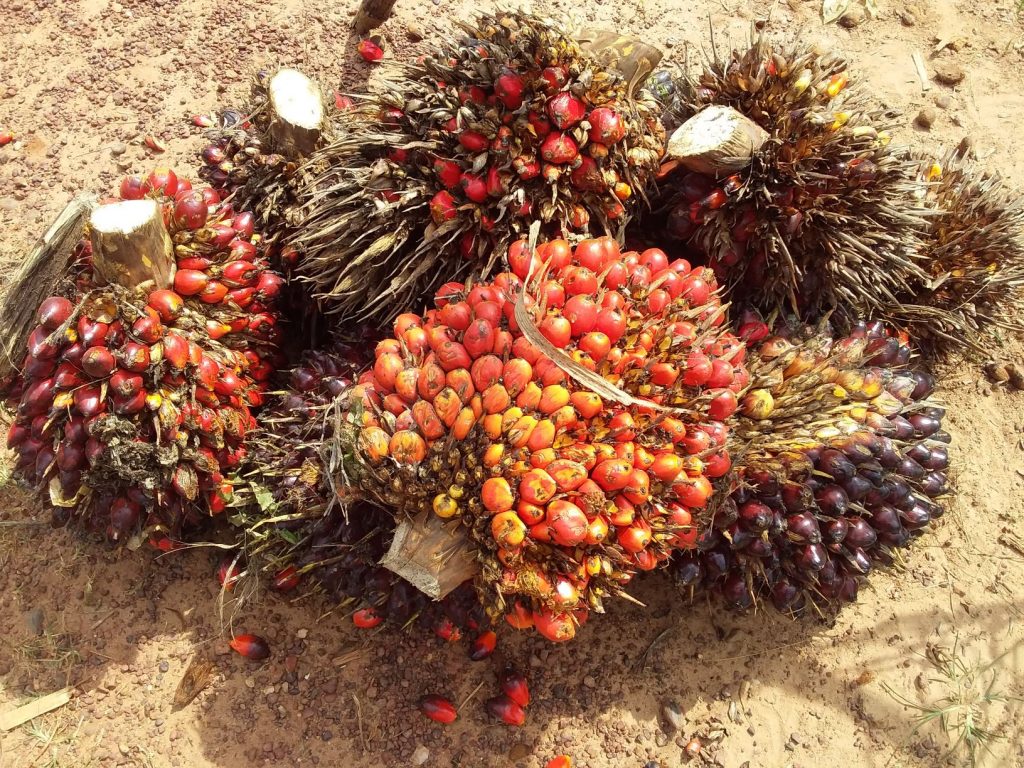
Food and nutrition security
In Ghana, there are fears of worsening food and nutrition insecurity situation due to rising food prices and declines in household incomes. For instance, a study conducted by the Agriculture Policy Research in Africa (APRA) in south-western Ghana, an area with comparatively better food and nutrition situation, revealed worsening food and nutrition insecurity concerns. More than a half (58.2%) of respondents in the APRA study indicated that cost of living in the area has increased as a result of the COVID-19 crises, thereby imposing substantial food and nutrition insecurity threats. Further evidence provided by the GSS Household and Jobs Tracker survey points to an impending moderate-to-severe food and nutrition insecurities in Ghana as a result of the pandemic. For instance, the household food insecurity experiences reported by the GSS indicates that almost a half (45.4%) of households ate a few kinds of food, 44.6% were worried about not having enough food to eat, 42.8% ate less than they thought they should, 41.4% were unable to eat healthy and nutritious/preferred foods, 39.1 had to skip a meal, 31.3 ran out of food, 26.8% were hungry but did not eat, and 8.9% went without food for a whole day.
Impact on food prices
Food price spikes followed the announcement of a partial lockdown of Accra and Kumasi, Ghana’s two major cities in March 2020. These increased food prices have been sustained over the past six (6) months. Indeed, the country’s average monthly food inflation experienced a sustained increase from 8.4% in March 2020 to 13.7% in July 2020. Evidence form the GSS Household and Jobs Tracker survey suggests that 77.4% of households were severely affected by increases in food prices.
Impact on agribusinesses
Four out of five agribusinesses surveyed by the Chamber of Agribusiness Ghana[2] (CAG) reported having their usual business operations affected by the pandemic. Why? Though Ghana’s COVID-19 movement restrictions exempted food supply, operations of non-food agribusinesses were severely affected. This potentially had a substantial knock-on effect on food supply system. Further, restrictions on key food demand sectors such as restaurants, hotels, public events and educational institutions had significant impacts on the country’s food supply network. Initially, these disruptions resulted in price hikes due to panic buying and food hoarding fuelled uncertainties regarding food availability (as was the case in Accra and Kumasi following the announcement of a partial lockdown.)
The disruptions to the food supply chains is expected to cause increases in business operating costs (due to compliance with COVID-19 protocols), revenue shortfalls, wage cuts, lay-offs, among others. According to the CAG, the average monthly revenue of agribusiness firms decreased by 61.2%, with small scale agribusinesses reporting average monthly revenue shortfalls amounting to 77.4%. These revenue losses may be due to restrictions on food demand sectors (such as restaurants, hotels and educational institutions) and disruptions in general agribusiness operations due to the COVID-19 crises.
[1] With support from the United Nations Development Program (UNDP) and the World Bank, the COVID-19 Households and Jobs Tracker Survey by the Ghana Statistical Service (GSS) involves 3,265 households and was conducted over the period June 10–25, 2020. This survey was nationally representative, covering all 16 regions of the country.
[2] The Chamber of Agribusiness Ghana (CAG) conducted a nationwide survey of 110 agribusinesses in Ghana following the outbreak of the COVID-19 pandemic.
Part two of this blog looks at the response of agribusinesses and farm households, the response of government and the way forward.
Feature image credit: Louis Hodey
Please note: During this time of uncertainty caused by the COVID19 pandemic, as for many at this time, some of our APRA work may well be affected but we aim to continue to post regular blogs and news updates on agricultural policy and research.
In this blog, APRA researcher Vine Mutyasira examines the impact of lockdown measures on smallholder farmers in Mvurwi and Concession, Zimbabwe. He examines how these restrictions have hit agricultural production and commodity marketing, and gives recommendations on how to combat problems, such as the decline in extension services to farmers.
This blog is linked to APRA Round One and Round Two country reports on the Impact of COVID-19 on Food Systems and Rural Livelihoods in Zimbabwe.
Read the full APRA synthesis report on the Rapid Assessment of the Impact of COVID-19 on Food Systems and Rural Livelihoods in Sub-Saharan Africa, here.
Written by Vine Mutyasira
Several articles have been written about the impacts of the COVID-19 pandemic on global economic systems and the agricultural sector in particular. Clearly, it has caused disruptions in global food supply chains and has taken a significant toll on local food systems and rural livelihoods, especially among rural farming communities where livelihoods are anchored on agricultural production. Agricultural activities in Zimbabwe have been affected by the national lockdown. The policy was first implemented on the 30th of March, slightly eased and then extended indefinitely on the 16th of May. The government has, however, been gradually eased the lockdown restrictions, announcing that supermarkets, restaurants and vegetables markets, among other essential services, were allowed to reopen but only operate from 8am to 3pm daily starting 21st of July.
The lockdown measures generally restricted movement of people across communities and hence access to markets for produce such as vegetables and auction floors for tobacco sales, as well as access to farming inputs. APRA interviewed over 100 households in Mvurwi and Concession, as well as key informants representing community leaders, farmer representatives and extension officers, to get a picture of the effects of the pandemic food systems and livelihoods in rural communities.
Agricultural production and food supply chains have felt the negative impacts of the coronavirus, particularly as a result of the restrictions imposed by the national lockdown. The lockdown restrictions accentuated the availability of labour for farming activities. About 45% of the farmers interviewed reported that they were unable to hire labour services for their farming activities, while 48% said that the cost of hiring day or casual labour had gone up during the COVID-19 crisis. An extension officer reported a situation unfolding at Montgomery Farm in Ward 24 of Concession. The farm produces horticultural crops such as cherry pepper and peas on over 30 hectares of land all year round. However, due to restrictions on the movement of people, they have been having challenges securing the required labour for the farm activities. As a result, they were forced to downsize their operation.
Impact on agricultural markets
Marketing of agricultural produce has also been affected in many ways. First, the lockdown restrictions made it difficult for farmers to access distant and often lucrative markets such as the Mbare Musika in Harare. There are incidences where farmers with a truckload of cabbages would be turned back at police roadblocks while on their way to the market. About 81% of interviewed farmers reported a significant drop in sales through district and regional markets. This was further compounded by the rising cost of transportation, as service providers demanded payment in US dollars. Secondly, lockdown restrictions severely affected the ability of buyers and brokers to visit communities and purchase produce directly from farmers. As a result, farmers reported a significant drop in farmgate sales for agricultural produce. Thirdly, closures of restaurants and other local informal food outlets decimated the local market for agricultural produce, especially horticulture, poultry and dairy products. An extension officer in Mvurwi reported of cases where farmers were forced to slaughter their flocks of layers chickens because of failure to access poultry feeds and also being unable to sell the eggs on the local markets.
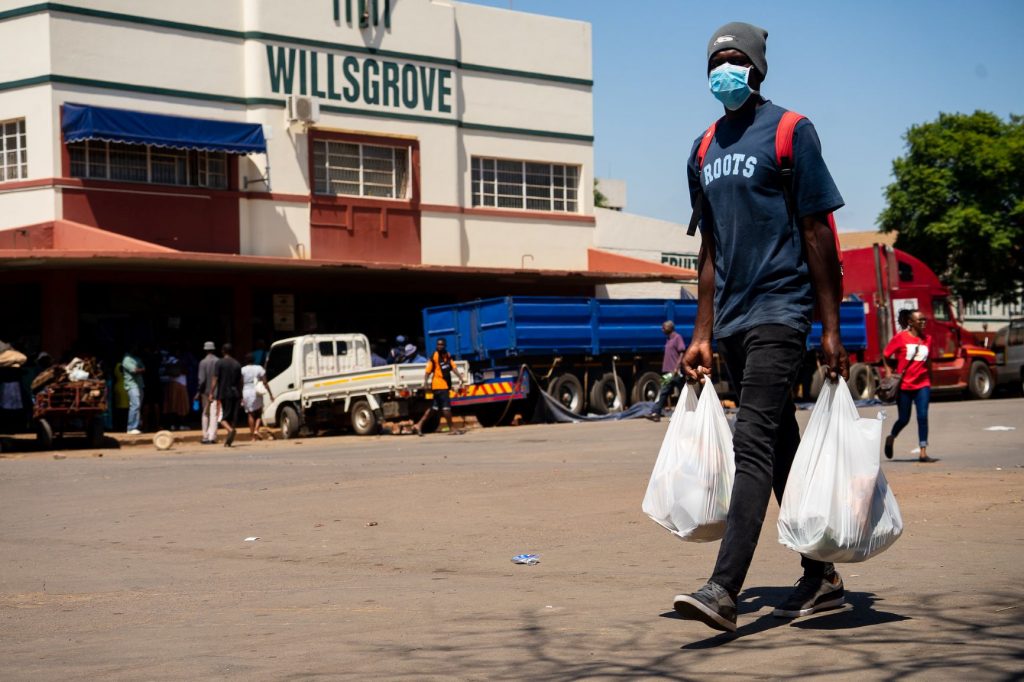
Impact on inputs and support services
Detrimental impacts to agriculture have also been felt through disruptions in the supply and availability of critical farm inputs and support services, which potentially affects households’ ability to produce for themselves. Due to general restrictions on inter-city and international travelling, local input suppliers have not been able to restock their inputs and agrochemicals. As a result, local Agro-dealership shops have been running low and some of them have closed shop due to lack of business. As a result, 88% of the farmers we interviewed reported that prices of farm inputs such as seeds, fertilisers, agrochemicals and veterinary drugs had gone up following the COVID-19 crisis. The cost of tillage services has also increased as fewer people were offering the service due to the shortage of fuel. Another crippling factor is the unavailability of extension services. About 70% of the farmers reported that access to essential extension services was reduced during the pandemic, probably as extension officers were reluctant to offer face to face trainings without the necessary personal protective equipment.
Way forward
Overall, the COVID-19 pandemic has created massive disruptions in agricultural production and marketing activities. Across agriculture, impacts have ranged from the disruption in the marketing activities, limited access to hired labour services and production inputs, increasing cost of transportation, as well as availability and cost of tillage services. As a result, the livelihoods and general food security situation of the rural communities have been negatively affected. Measures to strengthen food systems, through increasing the availability farm inputs and technical services, will be crucial especially as the farming season is fast approaching. Interventions such as supporting agro-dealership programs should enable farmers to readily access critical inputs, while adopting innovative extension approaches such as mobile agri-advisory service extension model should help provide timely and relevant advice to farmers.
Feature photo credit: International Labour Organization
Please note: During this time of uncertainty caused by the COVID19 pandemic, as for many at this time, some of our APRA work may well be affected but we aim to continue to post regular blogs and news updates on agricultural policy and research.
Although the COVID19 pandemic has not yet affected Nigeria to the same extent as some countries, the Nigerian Government introduced strict lockdown measures across the country to restrict the spread of the virus. In our latest blog, APRA researchers Adebayo B Aromolaran, Fadlulah O Issa and Milu Muyanga examine what the impact has been the food-value chain, and on the general attitude of Nigerians towards the pandemic.
Read more on the Impact of COVID-19 on Food Systems and Rural Livelihoods in Nigeria in the Round One and Round Two APRA country reports.
Read the full APRA synthesis report on the Rapid Assessment of the Impact of COVID-19 on Food Systems and Rural Livelihoods in Sub-Saharan Africa, here.
By Adebayo B Aromolaran, Fadlulah O Issa and Milu Muyanga
Introduction
The first case of COVID19 in Nigeria was reported on February 28, 2020. Six months after, only 53477 cases and 1011 deaths related to COVID 19 have been reported, compared to countries such as USA (6,096,235 cases), Brazil (3,812,605 cases), India (3,461,240 cases) and South Africa (620,132 cases). The Nigerian Government implemented several measures to contain the spread of the disease, some of which negatively impacted the livelihoods of many low-income households. This blog makes an early assessment of the impacts of lockdown on the agri-food system and livelihoods in rural and low-income urban Nigeria.
Government response to COVID19
To control the spread of the COVID19 pandemic, the government imposed total or partial lockdowns on human activities from March 25. The nature and intensity of these lockdowns varied by state and over the first three months. Many states had lockdowns for three-four days a week. In some others, the lockdowns restricted of movements at night. Most states also complied with Federal Government directives which included:
- Imposition of curfew from 8pm (later from 10pm) to 4am;
- Closure of schools at all levels from primary to tertiary;
- Suspension of all religious gatherings and meetings;
- Closure of international and domestic airports;
- Limitation of any form of gathering including burials, birthday parties and weddings to a maximum of 20 persons;
- Reduction of market days to a few days in a week;
- Reduction in public transportation carrying capacity to a maximum of 70%;
- Closure of state borders to reduce inter-state transmission and;
- Reduction in weekly working hours in the public service.
Impact of COVID19 lockdowns on farm labour availability
The restrictions on movement of people reduced availability of hired labour on farms. For example, many hired workers during the planting season in Ogun State (located in southern Nigeria) often came from other states, and the lockdowns were implemented at the start of the planting season in southern Nigeria. Consequently, land preparation activities were severely affected by a shortage of hired labour. This disruption also resulted in drastic reduction in area cultivated to crops in southern Nigeria.
Impact of COVID19 lockdowns on agro-input availability
The lockdowns have also negatively impacted agro-input and credit accessibility. For example, poultry feed millers in southern Nigeria experienced reduced access to maize, a very important input to poultry feeds, that is sourced from the northern part of the country. In addition, a smaller area cultivated to maize in southern Nigeria due to labour shortage further reduced the availability of maize for poultry feed production. This led to a spike in the price of maize from ₦90/kg in March to ₦172/kg in the middle of August 2020. Consequently, many feed millers had to either shut down their operations or are operating below capacity. Furthermore, reduced working hours, number of customers attended to per day, and selective branch closures by banks negatively impacted credit accessibility. Exceptionally long queues were noticed at bank entrances.
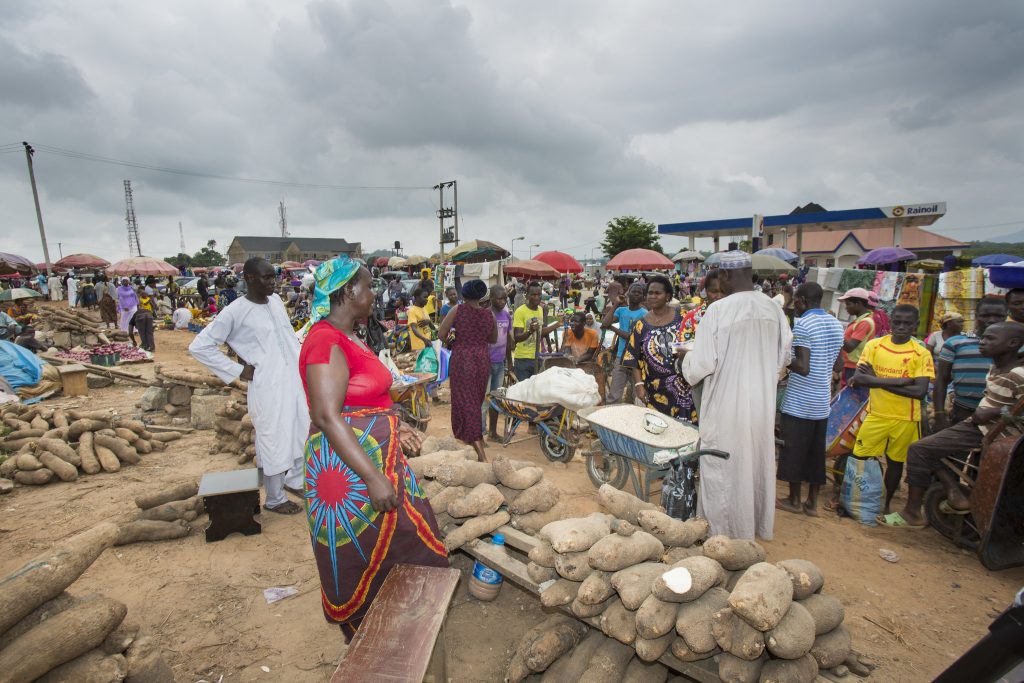
Impact of COVID19 lockdowns on marketing of farm produce
Farm gate prices of produce went down because of the market shutdowns, and reduced movements, especially interstate, by traders. For the same reasons, prices of food items in regional markets increased substantially. So, farmers were making reduced profits by selling in local markets while urban consumers were paying higher prices because of low supplies in the regional markets. In Ogun State, a ton of cassava which was ₦10,000 ($26) before the lockdown rose to ₦38,000 ($99) within 3 months. The price hike in regional markets was partly due to hoarding by traders since new supplies were not coming in as expected. This behaviour might require some form of Government intervention if the COVID 19 crisis continues.
Impact of COVID19 lockdowns on food and nutrition
In the short term, reduced income from both farm and off farm activities could negatively impact food intake and nutrition through reduced households’ disposable incomes. In the longer term, this may lead to poorer household food and nutrition by reducing farm input purchasing power and land area cultivated.
Among low income urban households, food and nutrition is negatively impacted by the substantial reduction in income flow due to reduced economic activity levels, resulting from the lockdowns and restrictions. In addition, high prices in urban markets caused by restrictions to the movement of traders to and from the farm gate has further compounded food security concerns among low income urban households.
Attitude of Nigerians to Government response to COVID19
The general feeling among low resource rural and urban Nigerians is that the intensity and duration of the lockdown is unnecessary and has brought about severe hardship in terms of decreased food availability, reduced incomes, as well as increased disease and mortality rates.
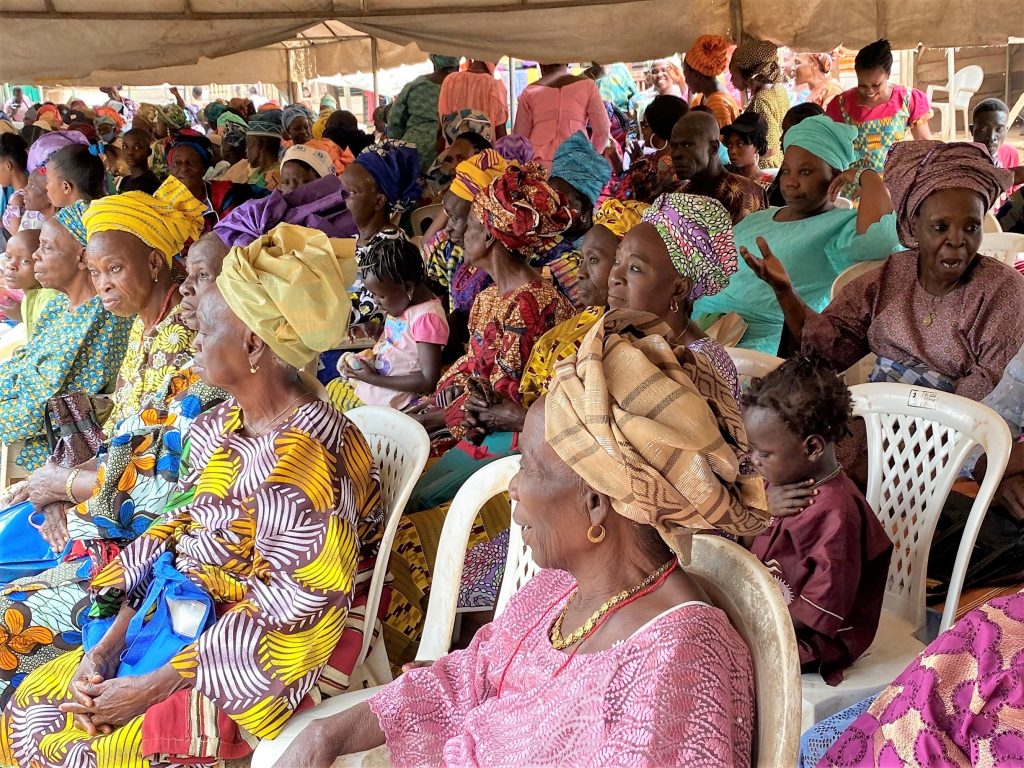
The ordinary Nigerian would choose to go to earn his/her daily living over the fear of getting infected with COVID 19. Many believe that COVID 19 is a disease of the wealthy and privileged class, and that most of the actions by government agencies are efforts by politicians to amass personal wealth. These partly account for why regulations such as social distancing, wearing a mask, and hand sanitising are not taken very seriously by many people. Even though Nigerians do not expect a future increase in COVID 19 cases, this attitude could put the larger population at risk from future outbreaks.
Government sources attribute the low COVID 19 infection and death rates in Nigeria to its proactive lockdown actions, but many Nigerians view their own resilience in terms of natural immunity, God’s protection and the intake of juices form local herbs and medicinal plants as key. Anecdotal evidence shows that many Nigerians who had symptoms like COVID 19 hardly call government agencies to request a test or even go to the hospital to be treated. Rather, they resort to self-medication or visit local chemists.
Feature image: Queue at a bank entrance in Ogun State, Nigeria. Credit: Omotola Ilemobayo.
Please note: During this time of uncertainty caused by the COVID19 pandemic, as for many at this time, some of our APRA work may well be affected but we aim to continue to post regular blogs and news updates on agricultural policy and research.
In our latest blog, APRA researchers Ntengua Mdoe, Gilead Mlay and Gideon Boniface examine the negative effect of the pandemic on Liliyan’s Catering Services Enterprise, and how it is bouncing back and coping with the financial hit. The researchers then provide recommendations to policy makers on how they can ensure that small businesses like this can survive the crisis.
Read more on the Impact of COVID-19 on Food Systems and Rural Livelihoods in Tanzania in the Round One and Round Two APRA country reports.
Read the full APRA synthesis report on the Rapid Assessment of the Impact of COVID-19 on Food Systems and Rural Livelihoods in Sub-Saharan Africa, here.
Written by Ntengua Mdoe, Gilead Mlay and Gideon Boniface
Hotels, restaurants and other eateries account for a significant proportion of rice consumption in Tanzania. These businesses have experienced a decline in clients from fear of the COVID-19 pandemic, suspension of international flights, suspension of social and other gatherings in mid-March 2020 when the government announced measures to prevent the spread of the pandemic. This blog highlights the effect of the pandemic on Liliyan’s Catering Services enterprise (LCSE) as one of the providers of food service away from home in Morogoro municipality.
Background of Liliyan’s catering services enterprise (LCSE)
LCSE is owned by Ms. Liliyan Munisi, a very experienced small businesses operator with many years of experience:
- 2002 – started a small business buying ladies’ clothes from Dar-es salaam for sale in Morogoro municipality;
- 2006 – given a tender of supplying workers uniforms by a tobacco company in Morogoro municipality until 2008;
- 2009 – opened a small restaurant;
- 2011 – LCSE was established;
- 2012 – LCSE was officially registered.

Size of LCSE
According to International Labour Organization’s definition of SME, LCSE is a small-sized enterprise as it has 16 permanent employees, the majority being young women and men. It is an important outlet of raw rice in Morogoro municipality, purchasing approximately 4.0 tonnes of raw rice per month under normal business environment
Services provided by LCSE
LCSE provides catering services to educational institutions, social gatherings (weddings, funerals) and other events such as workshops and seminars in Morogoro municipality. Rice is a major component of the foods served by LCSE, and often comprises of plain rice served with meat or beans and/or vegetables or cooked with meat and spices and served with vegetables (Pilau in Swahili).

Effect of COVID-19 on LCSE’s business services
COVID-19 has negatively affected LCSE after the government announcement to close educational institutions and suspend big social and other gatherings on 17th March 2020, including:
- Complete loss in revenue from food services to educational institutions;
- Substantial decline in revenue from provision of food services to seminars and workshops as the measures to control the spread of COVID-19 pandemic limited services to offer to gatherings with a maximum of 15 people;
- Incurred costs associated with provision and washing facilities for clients in accordance with the WHO health standards despite limited number of clients;
- Compensating laid-off workers in kind with food items such as rice and beans and;
- Experiencing difficulties in loan repayment as a result of a decline in cash flow.
Overall LCSE’s estimate of loss in gross revenue over the period of 3.5 months before resumption of the catering services was about TZS 94.5 million ($40,767.9).
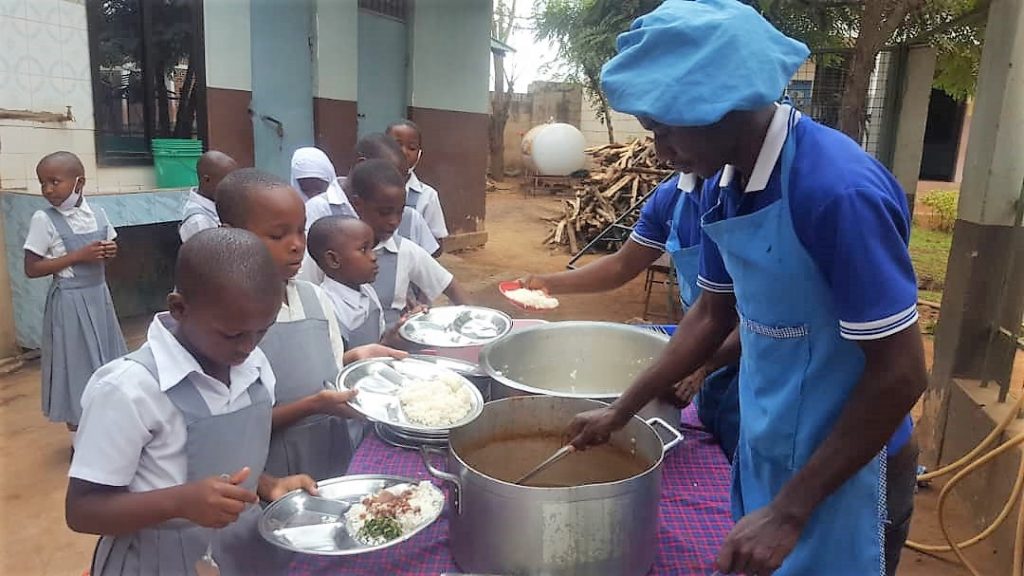
Back to business
Most actors in the rice value chain have continued business after the government’s decision to remove most of the restrictive measures taken to prevent the spread of COVID-19, effective from 29th June 2020, except the enforcement of the WHO health standards. Two weeks after the government decision, Ms. Liliyan Munisi said that she has been experiencing a slow recovery of catering services to social gatherings such as weddings and funerals because some people still fear that the pandemic is dangerous. Nevertheless, catering services to educational institutions and gatherings such as seminars and workshops have returned to normal. Consequently, the company is gradually recovering the revenue lost during the 3.5 months of business decline and has reinstated all of the employees laid off in March 2020. In addition, the company has resumed orders of raw rice from its suppliers, benefiting various actors higher up the rice value chain such as processors, traders of paddy and rice farmers.
Coping with the negative impact of COVID-19
The decline in catering business activities and the uncertainty of when catering services would return to normal compelled LCSE to do the following:
- Lay off some employees: 12 out of the 16 permanent employees were laid off (as mentioned above, these were later re-hired when the situation normalised);
- Re-investing in livestock production, specifically poultry, dairy and pig production as a long-term coping strategy.
Way forward
Evidence from this case study shows that food outlets have experienced significant loss in revenue as a result of decline in the number of clients since 17 March 2020 following measures announced by the government to control the spread of COVID-19. Although businesses are gradually returning back to normal after the decision to remove most of the control measures from 29th June 2020, it is difficult to predict how long the consumption of food away from home will return to normal, as some consumers believe that the pandemic is still prevailing in urban areas.
To survive the crisis, these business entities need urgent liquidity support in terms of accessing and making good use of any government established survival fund for small businesses. The International Monetary Fund (IMF) approved debt service relief of US $14.3 million to help Tanzania address social-economic effects of COVID-19. Among other support to COVID-19 affected businesses, the fund can partly be used to support these small businesses. This should be complemented by revision of the repayment terms of the funds borrowed by the businesses before the COVID-19 pandemic as directed by the Bank of Tanzania.
Owner of LCSE, Ms. Liliyan Munisi, standing close to her business truck. Credit: LCSE
Please note: During this time of uncertainty caused by the #COVID19 pandemic, as for many at this time, some of our APRA work may well be affected in coming weeks but we aim to continue to post regular blogs and news updates on agricultural policy and research.
In the final blog of a three-part series, Ethiopian Institute of Agricultural Research researcher Agajie Tesfaye looks ahead and provides seven key recommendations on how the Ethiopian government can lessen the negative impacts of COVID-19 restrictions on day labourers, farmers and rice commercialisation. Look below for the previous blogs:
Part one: Presents preliminary findings and statistical analysis of research assessments.
Part two: Examines the effects of COVID-19 on labour wages, service providers to labourers and rice production.
Read more on the Impact of COVID-19 on Food Systems and Rural Livelihoods in Ethiopia in the Round One and Round Two APRA country reports.
Read the full APRA synthesis report on the Rapid Assessment of the Impact of COVID-19 on Food Systems and Rural Livelihoods in Sub-Saharan Africa, here.
Written by Agajie Tesfaye
Looking Ahead
COVID-19 has started impacting the labour markets in the rice plain of Amhara Region. Labour markets have been deserted because of government restrictions to keep physical distancing and prohibition to stop in groups at a specific point. Rice farmers can’t obtain an adequate number of daily labourers for rice weeding and other operations. Some farmers are adopting the following temporary solutions:
- Mobilising all their working age family members;
- Using chemical sprays to control weeds, despite its limited effect;
- Using hired labour from nearby areas.
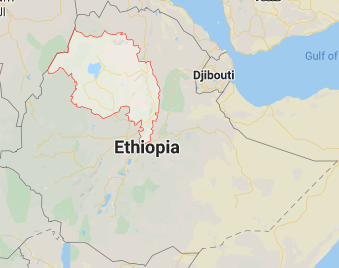
These temporary solutions may not be helpful when the acute labour demand season commences – and in response to high demand and limited supply – the labour wage has also increased by about 30%. Almost all the rice farmers will be looking for hired labour towards mid-August for second rice weeding and also for harvesting in later season.
Family labour will not meet the demand for weeding and harvesting within critically labour demand periods. Rice production and productivity could be negatively affected if this work is not done on time, indicating the extent to which rice farming was dependent on hired labour.
In response to the surge in COVID-19 and the rise in fatality rates in Ethiopia and government restrictions on movements, the availability of hired labour will continue to be scarce in the coming high labour demand months. Labour dependent economic sectors and farms will be largely hit by the sweeping of the virus. Without the use of supplementary hired labour, rice production and productivity will be compromised substantially. Production decline will in turn affect annual incomes of farmers reducing further investments on rice. Rice processing sector will also be affected because of limited production supplies. If the pandemic continues to persist in the coming seasons, rice farmers have indicated that they will reduce the area allocated to rice by 40 – 50% to the extent it is manageable only by family labour. This all implies that rice commercialisation will be affected in response to prolonged spread of COVID-19 in the country. It is likely to happen unless effective vaccination is discovered and accessible to all the population.
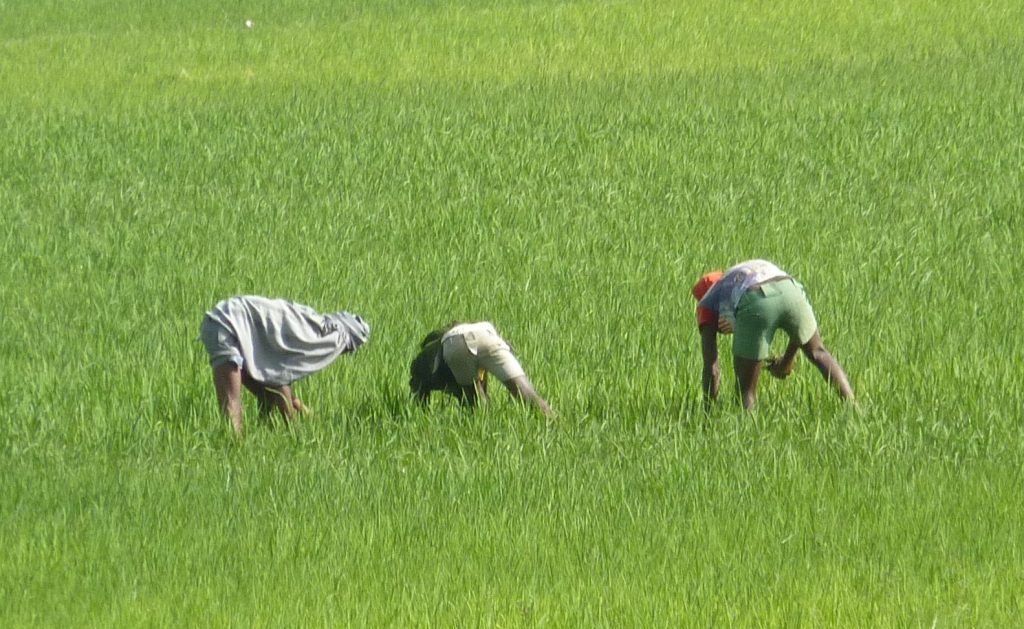
Policy considerations
- Easing Restrictions: With no social insurance policy (paid unemployment) in Ethiopia and social assistance (cash or in-kind transfers) unavailable in many locations, the government will have to ease restrictions imposed during the state of emergency. Even though lockdowns could help to reduce the spread of the pandemic, it is also negatively impacting on the economy and exacerbating poverty. While easing restrictions, strict measures should be imposed to use PPE while away from home.
- Providing adequate information about the pandemic: Awareness creation on the severity of COVID-19 disease and its complicated features need to be promoted for daily labourers and other community members on sustainable basis. Simple approaches such as microphones at market places and across main roads in towns could work. The mass media could also make use of easily understandable people centred approaches, such as local television dramas. The approaches should be renewed and replaced with new ones every time to avoid negligence from the audience.
- Mandatory rules and enforcement by local administration: Local government officials should also impose mandatory rules and enforce daily labourers to use face masks and socially distance at labour markets. Employers could be told not to hire any labourer without a mask, and enforce distancing at their workplace.
Local officials should also impose mandatory regulations on local service providers, such as room rental service providers and restaurants. While offering their services, they must enforce physical distancing, and should be forbidden from providing accommodation to groups of labourers. Officials should randomly inspect these premises and inform them that they are accountable for any violation of the rules.
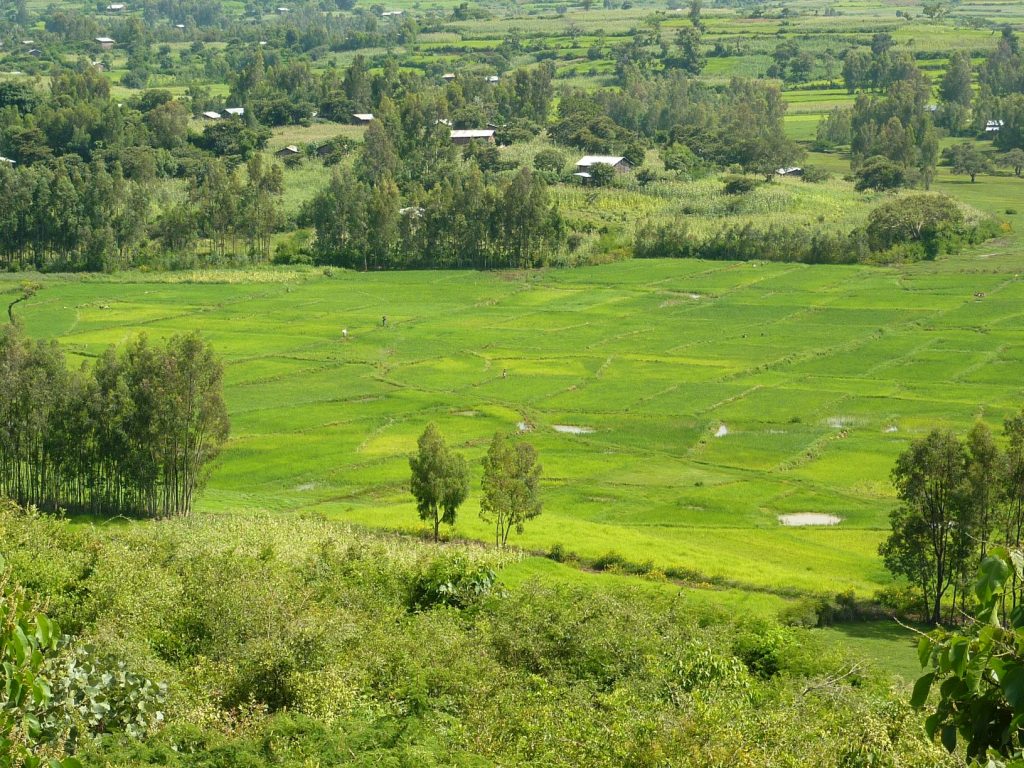
- Self-equipped Labourers: Employers should only be allowed to hire labourers who bring their own hand tools, such as sickles, to minimise transmission of the virus.
- Imposing and exercising strict accountability measures: Strict accountability measures, such as fines or temporary detainment, should be enforced for repeated violations of regulations to ensure everyone’s wellbeing, as many informal workers may be at risk of contracting COVID-19. Therefore, protective measures should be strictly implemented and used as per the advice of Ministry of Health and other institutes.
- Widespread provision of masks, hand washing stations and sanitisers: Many members of the community cannot afford PPEs, especially in district towns. Efforts should be made to install hand washing stations along with detergents and sanitisers on the road sides and entry points. Masks should be given out for free or with very little cost for poorer members of the community.
- Switching to agricultural mechanisation: Improvements to weeding, harvesting and others technologies should be demonstrated and promoted to farmers.
It may be too late in the short term as the season has already started, but it should be promoted when the harvesting season begins in four months. Ministry of Agriculture, agricultural research institutes, high learning institutes and other development partners need to provide similar training for farmers on how to operate and access the rice harvester machines.
In the long run, agricultural research institutes and other organisations need to strengthen and provide due focus in developing small-scale agricultural machines for various operations, such as rice planters, weeders, harvesters and threshers. The government should also strengthen its supports for mechanisation of agriculture sector, such as duty free importation, credit, hard currency and other services.
References (all three blogs)
Agajie Tesfaye, Abebaw Assaye, Degu Addis, Tilahun Tadesse, Dawit Alemu and John Thompson. 2019. Rice Commercialization and Labour Market Dynamism in Fogera Plain: Trends and Prospects (Unpublished).
Degye Goshu, Tadele Ferede, Getachew Diriba, and Mengistu Ketema. 2020. Economic and Welfare Effects of COVID-19 and Responses in Ethiopia: Initial insight. Policy Working Paper 02/2020. ISBN 978-99944-54-74-7.
Karmen Naidoo. 2020. The Labour Market Challenges of COVID-19 in Sub-Saharan Africa. https://www.africaportal.org/features/labour-market-challenges-covid-19-pandemic-sub-saharan-africa/
Cover photo: Labour market during pandemic. Credit: APRA Ethiopia
Map: Showing Amhara region. Fogera is located on the east side of Lake Tana. Source: Map data @2020 ORIEN-ME, Google.
Please note: During this time of uncertainty caused by the #COVID19 pandemic, as for many at this time, some of our APRA work may well be affected in coming weeks but we aim to continue to post regular blogs and news updates on agricultural policy and research.
In the second of a three-part blog series, Ethiopian Institute of Agricultural Research researcher Agajie Tesfaye examines effects of COVID-19 on labour wages, service providers to labourers, rice production and the future implications on rice commercialisation. Check below for the other two blogs of this series:
Part one: Preliminary findings and statistical analysis of research assessments on this topic.
Part three: Seven key recommendations on how the Ethiopian government can lessen the negative impacts of COVID-19 restrictions on day labourers, and rice farmers.
Read more on the Impact of COVID-19 on Food Systems and Rural Livelihoods in Ethiopia in the Round One and Round Two APRA country reports.
Read the full APRA synthesis report on the Rapid Assessment of the Impact of COVID-19 on Food Systems and Rural Livelihoods in Sub-Saharan Africa, here.
Written by Agajie Tesfaye
Effect of COVID-19 on labour wages
Some farmers without working age family members depend on hired labourers coming from surrounding areas. These labourers have their own accommodation, and tend not to go to labour markets in towns. Employers look for them in villages, and also source them through networking.
Labourers from nearby villages are not available in adequate numbers and cover no more than 10% of demand. The supply shortage in the face of high demand has pushed their wage rates up. In the last seasons, their daily wage used to be in the range of 80 – 120 Birr ($2.25-3.38) per person per day (Agajie et al, 2019). However, this wage has now increased to 120 – 150 Birr ($3.38-4.23) per day, a rise of 25 – 50%.
In Fogera rice plain, it appears that wage rate was not as such an issue at this critical time of season, but it was the availability which is a serious issue. This was because, farmers could incur massive losses compared to the costs of labour. Even the wages of women labourers – lower in past seasons – has now became equal with their male counterparts.
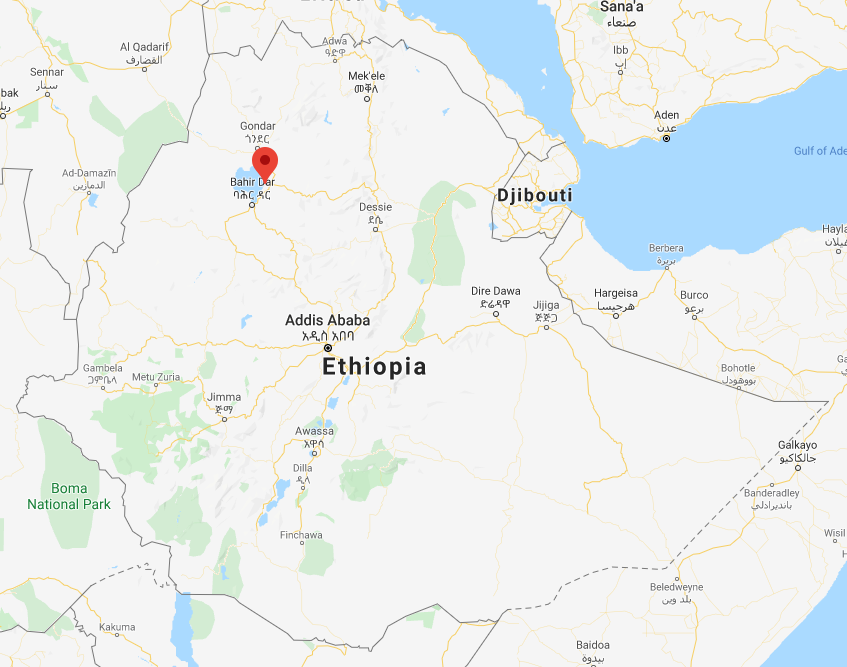
Effects of COVID-19 on service providers to labourers
COVID-19 has impacted not only incomes of daily labourers, but also on livelihoods of service providers. Room rent service providers, brewers, local restaurants, bars, pubs and others were largely dependent on daily labourers. They were also established to service the needs daily labourers who came from a distance.
These services centres were identified as hotspots for the transmission and spread of COVID-19 due to their small spaces. Consequently, District Police Officers have passed orders to suspend service provision until the situation improves. This has caused substantial decline in their incomes and seriously threatens their livelihoods.
Accommodation was a major problem faced by labourers. Before the pandemic, many labourers had been renting rooms in groups with small payments on daily basis. However, the District Police prohibited such rent providers to suspend their services. One of the Police Officers said to these service providers:
“You are only chasing your benefits at the expense of the life of these poor people…you are packing tens of labourers in one room, which is dangerous in spreading Corona. If you have economic problem, the government will support you…Therefore, stop…until the virus recedes”.
Police officer, in discussion with service providers
In addition to the above restrictions at labour markets, the inability to get accommodation was another key reason why labourers went back to their home villages, an issue present during the early months of COVID-19 in Ethiopia. Households who depend on daily incomes have therefore been largely affected by the pandemic.
Effects of COVID-19 on rice production
COVID-19 has not yet substantially impacted the rice sector. This is because acute labour demand season is yet to come until mid-August. In response to difficulty obtaining daily labourers, the farmers have taken two corrective measures: Firstly, farmers who previously relied on hired labour are using family labour for the first planting and weeding of rice. This included well-to-do households.
The second measure was the use of weed sprayers on rice fields. However, chemicals killed rice as well as weeds on up-lands with no flooding. Farms in flood plains were less affected due to the chemical mixing with floodwater.
Farmers are still optimistic that labourers will arrive for the second weeding in mid-August – a critical period rice production. One of the farmers described as follows:
“If we are not still able to get daily labourers at the time of critical needs, there is nothing we can do other than trying all our best using our family labour and leave the rest for weeds to invade the field or shatter out there. You see, we normally used to spend 12,000 – 13,000 Birr ($338-366) per annum to hire daily labourers. You can imagine the extent to which we have been dependent on hired labour”.
Farmer in Fogera Plain
Farmers planted many rice plots, fully expecting to acquire labour when the demand is high. Rice production and productivity will be heavily compromised if farmers cannot secure labour in time for the second weeding.
A study in India in the rice-wheat farming systems indicated that reverse migration of agricultural workforce (back home) and social distancing due to COVID-19 revealed that a delay in the transplanting of rice seedlings by two weeks is likely, which will also delay rice harvesting and consequently delay in planting wheat. It was estimated that this will potentially to rice and wheat production loses of 10 – 15%, worth up to USD 1.5 Billion (Emma, 2020). Even though the extent of loss might vary, Fogera farmers will also lose a substantial quantity of rice if labour shortages continue to be a problem in fear of COVID-19 spread.
Future implications of COVID-19 on rice commercialisation
Ethiopia is still in a state of emergency until August and it is hard to predict how the situation will change. As COVID-19 positive cases and death toll rises, it will continue to impact labour markets and other economic sectors. If farmers do not get labour for critical weeding and harvesting, rice production and marketable supplies will be largely reduced. This in turn will affect the rice processing sector in later months. Discussions with rice processors indicated that the pandemic has not yet impacted the processing sector, but that there will be impacts after the harvesting season.
It was estimated that farmers will reduce the area allocated to rice by 40 – 50% in the coming seasons if labour markets continue to be deserted as a result of COVID-19. This also means that rice production could decrease by a similar amount. The incomes of farmers and further investments on rice will also drop. This all will lead to decline of rice commercialisation in response to prolonged persistence of COVID-19 in the country.
Cover photo credit: Elias Damtew / ILRI.
Please note: During this time of uncertainty caused by the #COVID19 pandemic, as for many at this time, some of our APRA work may well be affected in coming weeks but we aim to continue to post regular blogs and news updates on agricultural policy and research.
In the first blog of a three-part series, Ethiopian Institute of Agricultural Research researcher Agajie Tesfaye presents the preliminary findings and statistical analysis of research assessments that were conducted to examine the impact of COVID-19 on the labour supply of rice farm workers and rice commercialisation in Fogera plain, Ethiopia. Check out the other two blogs of this series:
Part two: Examines the effects of COVID-19 on labour wages, service providers to labourers and rice production.
Part three: Gives seven key recommendations on how the Ethiopian government can lessen the negative impacts of COVID-19 restrictions on day labourers, and rice farmers.
Read more on the Impact of COVID-19 on Food Systems and Rural Livelihoods in Ethiopia in the Round One and Round Two APRA country reports.
Read the full APRA synthesis report on the Rapid Assessment of the Impact of COVID-19 on Food Systems and Rural Livelihoods in Sub-Saharan Africa, here.
Written by Agajie Tesfaye
Since COVID-19 was first diagnosed in Ethiopia in Mid-March 2020, the government has taken various preventive, control and mitigation measures, including state of emergency which will last for nearly half a year. These measures have negatively impacted economic gains, livelihoods and social values. As the surge continues, it will largely drain the already limited government resources and exacerbate food insecurity of poor households.
A report released by Degye et al. (2020) outlines that prolonged existence of the COVID-19 pandemic could lead to “disease driven poverty-trap” in Ethiopia. It emphasises that it is not the number of COVID-19 positive cases that matters, but the level of disruptions to economic activities which in turn aggravates the level of health risks.
Many farms are affected by a shortage of hired labour because of the COVID-19 pandemic. A preliminary APRA assessment in Fogera District of Amhara Region highlighted most of the farming families depend on hired labour for rice production because of the labour intensive nature of the crop.
Our first assessment was conducted during the outbreak of the pandemic in mid-March, while the second was during first weeding of rice (mid-July). The third will be made towards mid-August, the critical labour demand season for second rice weeding. These assessments will illustrate the changes on extents of COVID-19 effects on labour market and rice commercialisation.
Effects of COVID-19 on Labour Supply
Following the national state of emergency, regional governments (including Amhara Region), declared restrictions on some locations where the pandemic had been reported, such as a ban on public transport, grain, and labour markets for two weeks.
In Fogera rice plain, more than 90% of the daily labourers travel to look for work. During lockdown measures, Fogera District Police has been forcing daily labourers to spread-apart at labour markets, making finding jobs very difficult. Employers were even asked not to hire labourers. Employers described what the Police Commander said to them:
“Why do you hire a labourer whose address is not known and you don’t know even with whom he has been in contact. He could have contracted the virus and you are putting your family at risk”.
Commander of District Police – as told by employers
This caused employers to go home and work on their farms using members of their family. In spite of demand, many labourers were forced to go back to their villages.
The police confirmed that they are creating awareness for public in different ways including daily labourers. According to the police, they are facing challenges from the public while taking actions to minimise the spread of the pandemic as per the regulations of the government:
“Even though we are chasing daily labourers from labour markets to spread apart, they do not have other options for daily food. The same is true with service providers who rent their rooms to groups of labourers on daily basis. These…are the poorest-of-the poor and their livelihood is based on daily earning. Labourers and service providers often express ‘it is better we die of Corona after working and getting food than die of hunger’.”
Commander of District Police
Some respondents noted that many are not using PPE or social distancing:
“We are aware that using a mask is helpful, but it is almost not practiced in our villages. We depend on prayers and God’s blessings… we have stopped hugging newcomers.”
Employer
Farmers have planted rice as usual, expecting the situation to improve and the daily labourers, who are often very flexible, to be available. They don’t know what will happen when the demand for daily labourers is acute, but are prepared to do as much as they can do.
Analysing the statistics
53% of the labour force in Sub-Saharan Africa (SSA) is employed in agriculture (Karmen, 2020) and that labour in the agriculture sector will still be in demand during lockdown. The same is also happening in Fogera plain. The agriculture sector has been encouraged by the government to operate as usual even in the lockdown period, therefore should not be too badly affected. Degye et al. (2020) have also reported that agriculture is the least affected sector from job loss because of COVID-19. The agriculture sector (see table 1) will only lose a maximum of 10% of labour under a severe scenario if COVID-19 lasts for three months, compared to 57% for service and 37% for manufacturing and construction sectors. If it continues for six months, the magnitude of job loss in agriculture sector is still the least (12%) compared to other sectors.
The case for rice sector might be different because of the fact that rice farming is largely dependent on hired labour. According to Agajie et al (2019), hired labour is highly demanded for rice mainly for weeding and harvesting operations. As illustrated in Table 2, weeding and harvesting are critical operations which require services of hired labour as reported by 87 and 65% of respondents, respectively. However, hired labour is not widely available because of of COVID-19 measures taken by local governments.
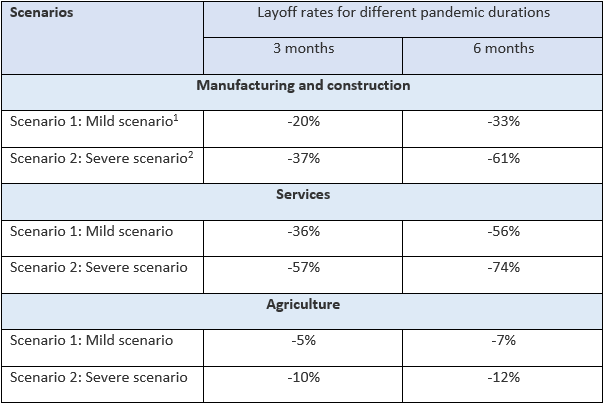
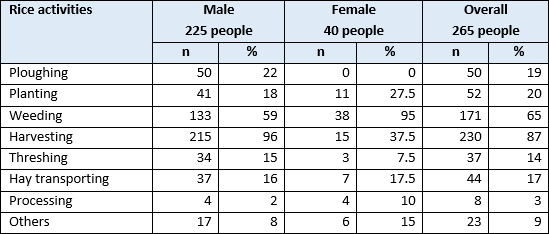
In the rice sector, the demand for daily labour is highly increasing over time. The proportion of labourers (see fig. 1) joining labour market shows an increasing trend in the last two decades. According to the respondents, 17% joined labour markets before the last ten years while 83% joined in the last decade. The proportion of labourers who jointed labour markets was only 5% before 15 years. A recent increase in the unemployment rate is thought to be a driving factor why evicted youths and those from lower income households find work in labour markets. This means that incidence of COVID-19 will largely affect these categories of the community. Rice farmers will also be affected from a lack of daily labourers, and their incomes will decline substantially.
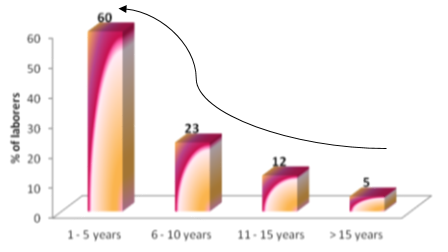
The study conducted on labour profiles in Fogera rice plain indicated that daily labourers were drawn from the poorest economic groups. 65% of the labourers (table 3) were landless and even 32% owned small plots of land, either one ha or less, which is not adequate to support themselves and their families. Moreover, 53% of the labourers did not own any of the domestic animals (Agajie et al, 2019). The pandemic has exacerbated their poverty and worsened the livelihoods of these categories of the community.

Table 1:
1 Mild scenario assumes that the adverse effects of the virus will be mitigated through rapid response mechanisms with minimal loses and mild economic problems.
2 Severe scenario assumes that COVID-19 situation will get worse adversely impacting on the economic and social sectors.
Cover photo: Labour market in Fogera prior to COVID19 lockdown mesures. Credit: Agajie Tesfaye/APRA Ethiopia
Please note: During this time of uncertainty caused by the #COVID19 pandemic, as for many at this time, some of our APRA work may well be affected in coming weeks but we aim to continue to post regular blogs and news updates on agricultural policy and research.
This blog was written by Amrita Saha and Opeyemi Abebe. It was first published by the Commonwealth Secretariat.
In Africa, micro, small and medium-size enterprises (MSMEs) in the informal economy are particularly vulnerable to economic impacts of the Covid-19 pandemic. Consumers are demanding and spending less, leading to decreasing revenues, liquidity problems, reduced output and layoffs.
These small businesses are usually engaged in agriculture, retail trade, transportation or construction. An average of 86 per cent of Africans employed are in the informal economy, with women constituting a large part of these numbers. Safeguarding firms and workers in the informal sector will require a mix of swift context-specific short-term and more medium to longer-term measures that focus on building resilience and capabilities.
A new report commissioned by the Commonwealth Secretariat proposes five recommendations on how governments can help ensure their survival:
1. Health and safety guidelines and support schemes for informal workers
Informal sector workers are highly vulnerable to getting infected as they mostly live and work in congested spaces and lack adequate access to water and clean sanitation. Hygiene and sanitation are critical.
As a short-term strategy, African governments can immediately put in place health guidelines for informal traders, as has been done in South Africa. In the medium to long-term, health insurance schemes that afford significant protection for workers in the informal sector, such as Ghana’s National Health Insurance Scheme, can provide better prenatal care, preventive health check-ups and attention from trained health professionals.
2. Adequate short-term welfare support with coverage from public works programs
To reduce the risk of extreme poverty and food insecurity, governments are announcing online payments, in-kind transfers (food distribution) and social grants. However, access to these measures can be complex and more effective and targeted social safety nets for the informal sector are needed.
Cash transfers can be particularly effective as macro-economic stabilizers, since they can take effect with less delay than other discretionary fiscal measures. However, in the medium to long-term, generating employment through paid work opportunities and public works programmes will be important.
3. Maintaining liquidity for firms and re-thinking operating models
To survive the crisis, small businesses in the informal sector need urgent liquidity support. As of May 2020, fiscal policy stimulus vary greatly across countries, ranging from 0.1 to 4 per cent of GDP.
Such short-term increase in the liquidity of MSMEs and should go through the channels that entrepreneurs already know and trust. This means community-based financial and microfinance institutions should be considered essential services during the crisis, and provided emergency liquidity, if within regulation.
The crisis will force a fundamental rethinking of business and operating models that will transform the small business sector for years to come. Short-term measures may provide immediate support, but do little to build long-term sustainability. This requires a structural reduction the finance gap for MSMEs by extending microfinance systems and including other services such insurance, technical assistance in accessing loans and business trainings.
4. Adjusting to supply chain disruptions plus private sector development interventions
Value chain disruptions have huge impacts, as MSMEs in the informal sector rely on day-to-day sales for survival. To avoid insolvencies in the short-term, these businesses will increasingly rely on stimulus measures that lower operational costs and waive existing debts.
Expanding business links is also possible, whereby large, formal businesses can work with small, informal businesses as their outlets or distributors of essential goods to people’s doorsteps. Stimulus packages should improve working spaces and infrastructure of the informal economy, such as communal markets, in a way that promotes social distancing. This would allow them to become operational in the short-term.
In the long-term, business performance and competitiveness could be enhanced through more comprehensive private sector development interventions. These should combine access to finance, consulting and business training with industry-specific networking, regulations, standards, innovation and linkage programmes.
5. Structural policies for resilience
Resilience will depend on structural policies that support training and resources, provide information and invest in building capabilities. In the short-term, these should help MSMEs adopt new working modes and digital technologies that respond to the new reality of Covid-19, such as teleworking, online retail or home delivery.
However, this requires some basic infrastructure in place (such as internet connection) and familiarity with digital platforms, along with consumer demand for such services. Less than 30 per cent of the African population has access to the internet, compared to 90 per cent in advanced countries and 60 per cent in other developing countries. At the same time, mobile money services are on the rise amongst African small businesses, increasing productivity, turnover and revenues, and credibility.
Medium to long-term digital transformation can help ensure MSMEs can bounce back strongly. Simple digital solutions and training that do not require large upfront capital outlay will make it easier to adapt.
In conclusion, policymakers will have to assess the situation and be innovative and adaptive in responding to gaps in their proposed measures. Overall, short-term measures to help the informal MSME sector should be linked with longer-term resilience programmes for more sustainable post-Covid-19 recovery.
Opeyemi Abebe is an Adviser and Head of Trade Competitiveness Section at the Commonwealth Secretariat.
Cover photo credit: World Bank / Sambrian Mbaabu on Flickr.
This blog was written by Ian Scoones and first appeared on Zimbabweland.
COVID-19 has taken hold in Zimbabwe with a significant growth in community transmission observed in the past weeks. On July 24th, the total reported cases were 2296, with 32 deaths. This is likely the tip of a much bigger iceberg given under-reporting and limiting testing. President Mnangagwa has re-imposed a strict lockdown in response, including a dawn to dusk curfew, further limits on movements and restrictions on transport and business.
The relative easing of COVID-19 measures over the past weeks was clearly premature given the huge flow of infections from South Africa via returnees coming home. In the last blog on the pandemic in Zimbabwe we discussed this mass migration of those who had lost their jobs or had become ill in what is now one of the major foci of COVID-19 in the world. Zimbabwe’s close proximity to South Africa is proving highly risky.
This is the third update from our field sites across the country, each focusing on how COVID-19 is affecting rural areas (see previous blogs here from 27 April and here from 15 June). Reports from all sites were relayed to me in a long phone conversation over the weekend. As the effects of lockdown have combined with an already deteriorating economy, the situation in Zimbabwe is bad. To survive people are resorting to a range of informal and sometimes illegal activities. The common view is that it’s better to risk COVID-19 in the future than die of hunger now.
The smuggling economy
Our colleagues in Mwenezi, Chiredzi and Matabeleland South in particular highlighted the massive growth in smuggling of goods, cash and people across the border from South Africa, and the implications for the spread of the virus. With restrictions on border crossing and the banning of private transport, the demand for goods has heightened and with this there have been massive hikes in prices.
A widespread network of smugglers, sometimes with the direct involvement of security forces and customs officials on both sides of the border, has emerged. Links are made to shop owners in Musina in South Africa who transport goods to the border, and link up with traders and transporters who move them throughout Zimbabwe. Paying off officials adds to the cost, but the result is that a range of goods – groceries, clothes, agri-chemicals and more – are supplied throughout Zimbabwe.
With some shops closed and others operating with shorter business hours and less stock, suppliers sell on to mobile shops that move around rural areas and locations/townships in urban areas. Much activity happens at night to avoid the authorities who restrict vending or may impose arbitrary fines. These are elaborate value chains, with many connections, and with people at every stage demanding a cut. The consumer inevitably suffers as prices go up and up, inflated further by the collapsing value of the local currency. Government and local councils also lose out as the taxes, customs duties and rates that are normally paid are lost. This huge trade is largely illegal, and many cross at secret points in the highly porous border.
This massive informalisation of the economy extends to how the supply of cash is dealt with. In the past, remittances from relatives in South Africa and elsewhere were usually paid through standard agents – like Mukuru, Western Union and so on – based in towns and cities. While still mostly operating, they no longer can be reached by many due to restrictions on access to town centres. This has become worse with the limitation of opening hours for businesses and the recent curfew.
This means that the lifeline of remittance cash in the absence of jobs has to be sought through new routes. Here the traders who illegally transport goods across the border also assist. Zimbabweans with South African bank accounts can receive and then withdraw large amounts of cash and send it via traders, lorry drivers and others to relatives on the other side of the border. Those moving the cash take a proportion for the service – up to 30% – but ensure that relatives’ money reaches their kin in Zimbabwe to keep them alive.
Mass migrations of people and viruses
The movement of people from South Africa (as well as the UK, Botswana and other neighbouring countries) resulted in the establishment of the virus in Zimbabwe. A month back nearly all cases were imported, but now community transmission exceeds these in the reported statistics. The migration of people with the virus across a region that has long relied on labour migration is one of the major stories of the pandemic in southern Africa.
When the pandemic first struck, the South African government built a massive (and very expensive) new fence along the border with Zimbabwe, notionally aimed at stopping Zimbabweans flooding into South Africa as the economy collapsed further, and so spreading the virus. But it was movement in the other direction that has driven the pandemic, with many Zimbabweans in South Africa losing jobs and fleeing poverty to be with their families back home. Excluded from social security measures, the migrant populations in South Africa not only suffer xenophobic attacks but now viral infection.
Those who return with the virus are often smuggled across the border with goods in lorries and trucks, hiding from the authorities. Illegal crossings are used to dodge the requirements to go to quarantine centres that have become notorious places, rumoured to spread disease through unsanitary conditions. Alongside normal returnees have been criminals who have been deported back to Zimbabwe, often returning to crime in the process. Returnees who arrive back in rural villages across Zimbabwe are often hidden from authorities and neighbours, and are sometimes protected by local officials and traditional leaders if well connected. It is no surprise that the pandemic has established itself in Zimbabwe.
Volatile markets: challenges for agricultural producers
As discussed in previous blogs, agricultural producers have been hit hard by the pandemic, notably through the restriction of movement and constrained access to markets. As the economy continues to implode, demand also drops. The horticultural producers from our research sites that surround Masvingo for example have cut their production by 40% and shifted to local drying and processing of vegetables as contracts with supermarkets and other traders have ceased. This has affected all household economies, as especially in the dry season (which it is now) income from horticultural production is vital.
Farmers are much better off than their counterparts living in the town, however. As our team reports, in all parts of the country those without land and some form of agricultural production are suffering badly. Hunger is really stalking the townships in all parts of the country. Farmers who have reduced production have had to diversify livelihood activities, switching to trading in particular; as our colleagues point out, nearly every household has someone trading in the informal COVID economy.
Due to the loss of value of the Zimbabwe dollar, now trading against the US dollar on the black market at over Z$120 per US dollar, many have adopted barter trade arrangements, informalising exchange yet further. This operates across international borders as well as within the country.
In rural areas, for example, farmers exchange grain, groundnuts, nyimo and other products for groceries supplied by mobile traders. In the sugar-growing areas, workers for the estates or A2 farmers who are able to buy 20kg of sugar per month at a reduced rate as part of their employment package, trade this for a range of goods. Sugar is an especially valuable currency as it holds its value well and is in constant demand. For farmers, agricultural products are fast replacing cash as a medium for exchange in the informalised COVID economy.
It is tobacco marketing season in our site in Mvurwi at the moment, and this is a rare focus of vibrant economic activity. Mvurwi town is a hive of activity with five auction floors now competing for trade. Payments are made half in US dollars and half in local currency, and although not as profitable as in the past, the tobacco sales are providing much-needed income in the area.
However, as our colleague in Mvurwi notes, the crowded scenes in the marketing areas and in the transport hubs do not result in public health compliance. Tobacco marketing, like the increasingly large church gatherings and major funerals, are feared as foci for infection. The police intervene and occasionally arrest people (sometimes in large numbers) for contraventions, but the next day things look much the same. Maintaining public health while continuing with economic activity is a tough balance.
Pandemic politics in a failing state
Zimbabwe in many respects has followed the WHO global recommendations on COVID-19 very assiduously. Interventions were early, movements have been restricted, masks are compulsory in public places and on transport, advice is to wash hands regularly and stay at home and so on. But these regulations just cannot work when people are starving, in desperate need of income. They cannot work either when the health services on which such measures rely are woefully inadequate or when health workers are hugely underpaid. Today nurses are on strike demanding better conditions, and in hospitals it is trainee nurses who are on the frontline, many now contracting the virus.
Without a functioning state that can provide security – through safety nets and support for livelihoods – and pay health workers and guarantee their safety, public health measures are quickly abandoned. Add to this the growing distrust of the state, and the likelihood of people following government edicts declines yet further.
At the beginning of the outbreak, when it seemed that this was a problem for others elsewhere, there was a sense of joint commitment: coming together to address something threatening and unknown. With the virus spreading fast and with the lockdown measures having decimated livelihoods this collective sense of purpose has gone.
Our colleagues report that, across the country, opportunistic crime has risen, along with gender-based violence. In all our sites, there is a palpable sense of frustration and tension; a sense of being left alone, abandoned by the state.
Trust in authority has been undermined too, and this has been massively exacerbated by the way the government and ruling party have acted. The scandal over corrupt procurement of PPE and other COVID-related materials that saw the Health Minister fired, charged (and then given bail) has enraged many. The heavy-handed tactics of the security forces – both the army and police – has generated resentments, as the informal trade that is the Zimbabwean economy has to pay off security officials at every turn, with bribes just adding to costs of an already expensive life. That the state is clamping down on opposition activists and journalists who are exposing corruption and restricting protests against the state is just further justification for a growing disquiet.
Rather than the sense of national collective effort in the face of crisis, it seems that everyone is on their own in the struggle to survive the virus.
What next?
The next weeks will be crucial ones in Zimbabwe. Will the virus continue to spread resulting in the scale of death and suffering now being seen in South Africa? Or will the measures being imposed now contain it? Will the resentments that have built up over the failure of the state – alongside scandals of corruption – result in strikes and protests that some have called for? Or will most Zimbabweans just continue to suffer; just about surviving and innovating continuously in response to the fast-changing economic, political and epidemiological conditions?
Our team will continue to listen to stories from the field and monitor what is happening, so watch out for the next update in a few weeks’ time.
Many thanks to all the research team from across Zimbabwe for continuing interviews and collecting local information on the COVID-19 situation (and for the photos from different sites).
All photo credit: Ian Scoones
Latest Covid-19 blogs
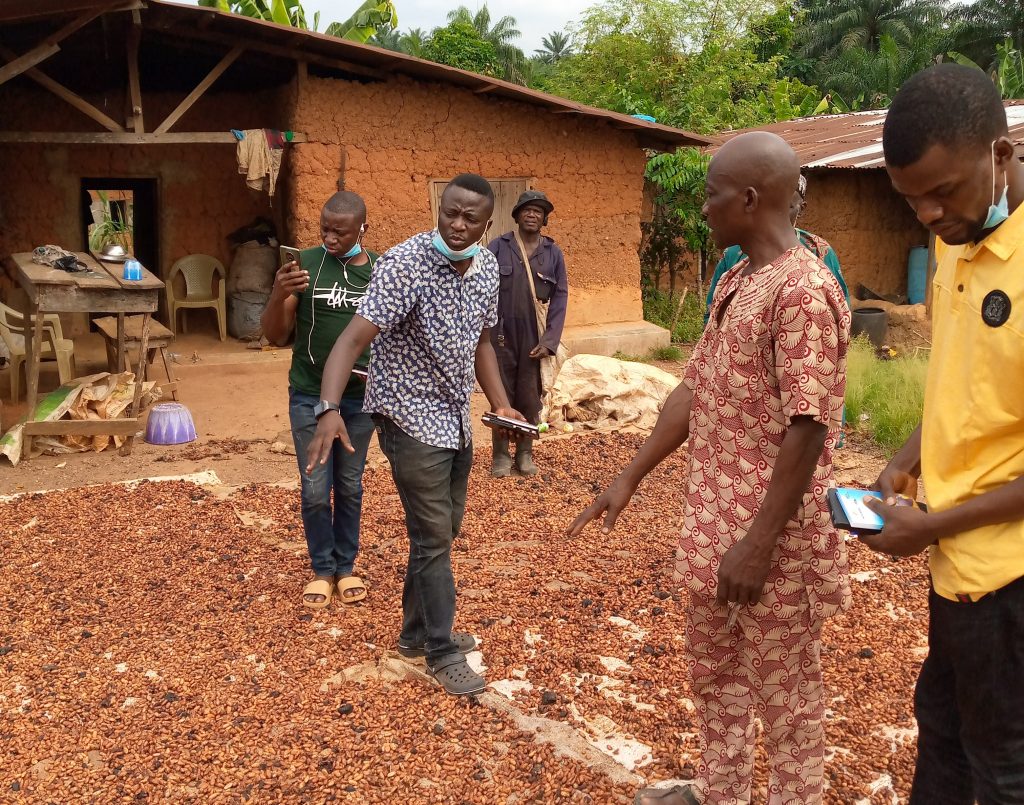
A multi-phase assessment of the effects of COVID-19 on food systems and rural livelihoods in Nigeria
January 17, 2022Since the outbreak of COVID-19 in Nigeria, there have been serious concerns about the impact of the pandemic on agri-food systems, given that most of the population depend directly or indirectly on agriculture for their livelihoods. These concerns are compounded by the fragile state of the country’s health and food systems. This blog summarises the findings of APRA’s A Multi-Phase Assessment of the Effects of COVID-19 on Food Systems and Rural Livelihoods in Nigeria, which studied the differential impacts of the pandemic on agricultural commercialisation, food and nutrition security, employment, poverty, and well-being in rural households. The assessment was designed to help gain timely insights into how the COVID-19 crisis was unfolding in various parts of Nigeria and how rural people and food and livelihood systems were responding.
Read more »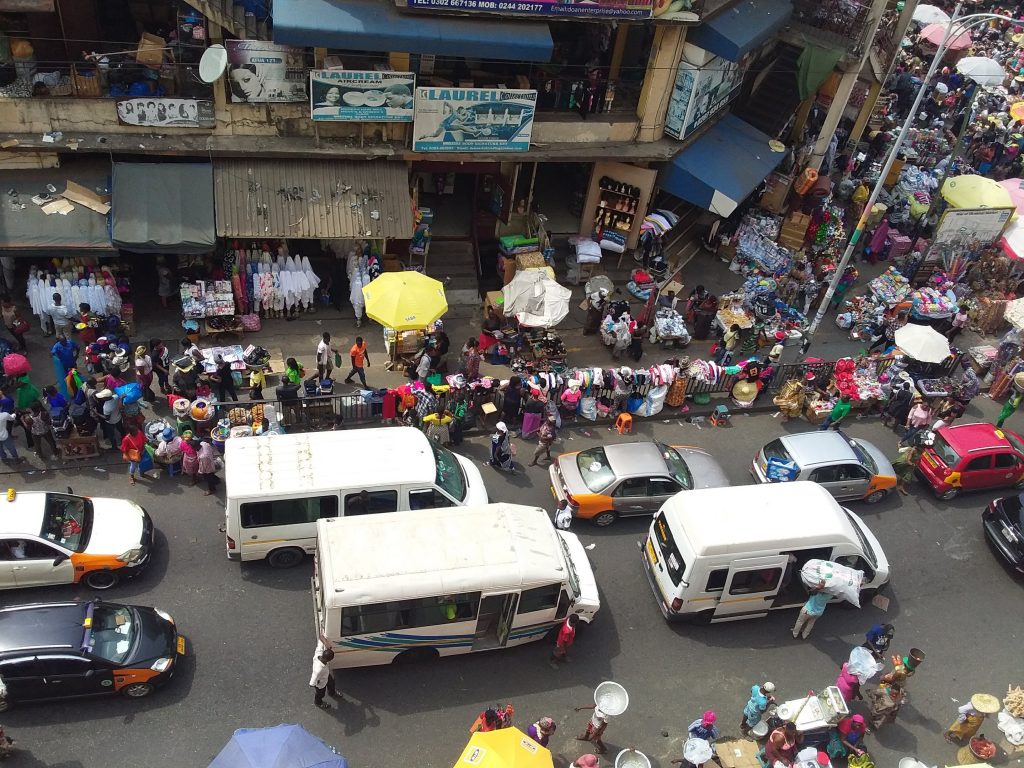
Hard pressed but not crushed: A story of resilience and adaptation to COVID in Ghana
January 12, 2022The COVID-19 pandemic has killed and destroyed – not only lives – but livelihoods as well. The COVID-19 crisis has disrupted food systems in Ghana since its emergence in the country in March 2020. According to the United Nations World Food Programme, the socio-economic burden imposed by COVID-19, particularly through restrictions on social and commercial activities, appears to be more devastating than the actual health burden of the virus in many countries. The story of the disruptive consequences of the crisis on food systems and livelihoods have been told worldwide. Yet, these stories are not the same for all societies and sectors. The recent APRA publication ‘A Multi-Phase Assessment of the Effects of COVID-19 on Food Systems and Rural Livelihoods in Ghana’ explores these differential effects in Ghana. This blog explores the findings of this report.
Read more »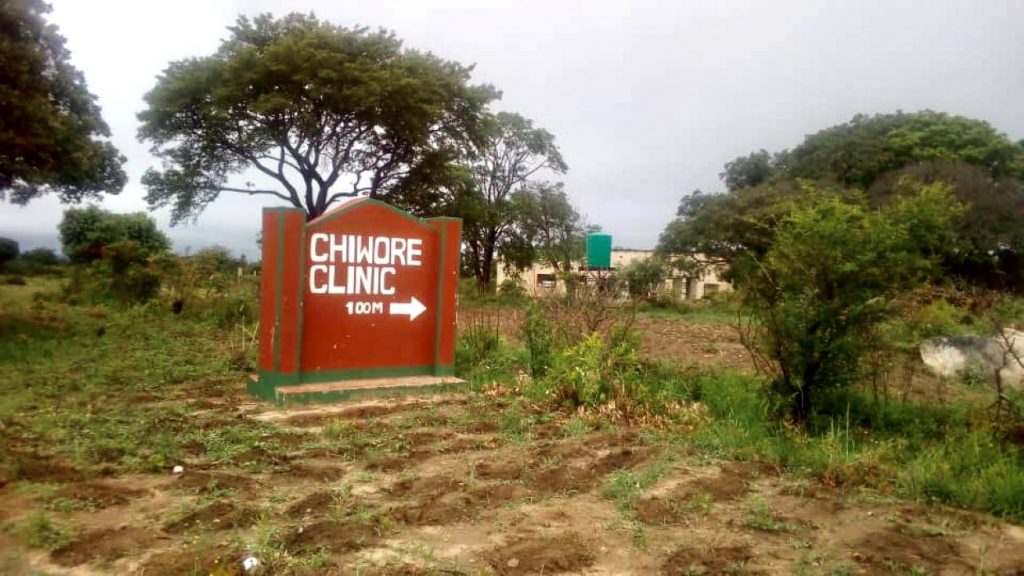
As Omicron sweeps through Zimbabwe, how are people responding?
January 10, 2022It was just a few weeks ago that our last report noted the arrival of a new variant identified in South Africa. In the interim Omicron has swept through the country. This initially resulted in panic, with a rush to get vaccinated and the government swiftly responding with further lockdown measures. As someone recalled, “it was like the world was about to come to an end”, so panicked were both officials and many in the population.
Read more »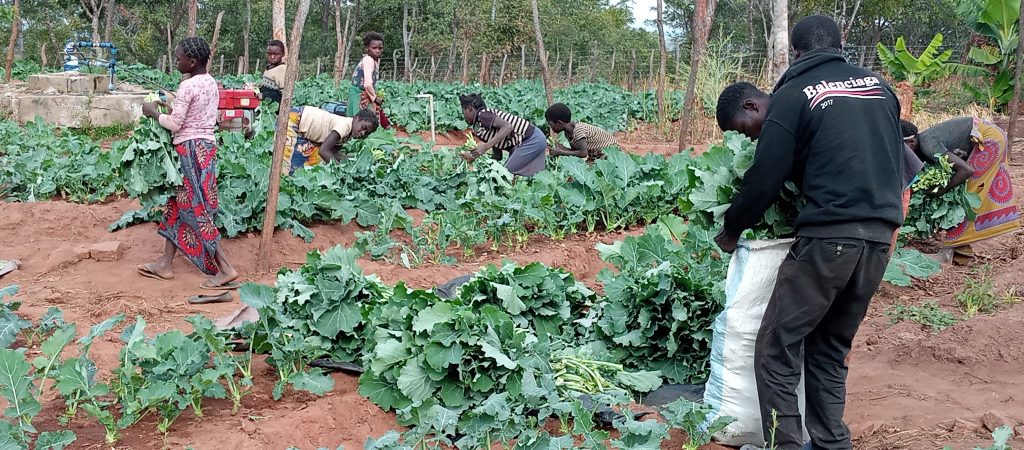
A multi-phase assessment of the effects of COVID-19 on food systems and rural livelihoods in Zambia: The case of small-scale farmers surrounding Mkushi Farming Block
January 6, 2022Following the identification of the first COVID-19 case in Zambia on 18 March 2020, the government announced some lockdown measures intended to prevent the spread of pandemic. Since then, the COVID-19 pandemic has not only led to loss of human life and negatively affected health systems in the country, it has also disrupted local food systems and rural livelihoods. This blog reflects on the findings of APRA’s A Multi-Phase Assessment of the Effects of COVID-19 on Food Systems and Rural Livelihoods in Zambia, which highlights a case study on small-scale farmers surrounding the Mkushi Farming Block in Central Province of Zambia. The study focused on documenting and understanding the impacts of the pandemic at the household level in terms of changes in farming activities, availability and cost of services for agricultural production, labour and employment, marketing, transport services, food and nutrition security, and poverty. It also reviewed the COVID-19 health guidelines and ‘lockdown’ measures imposed by the state authorities, and how they may have contributed to these observed changes over time.
Read more »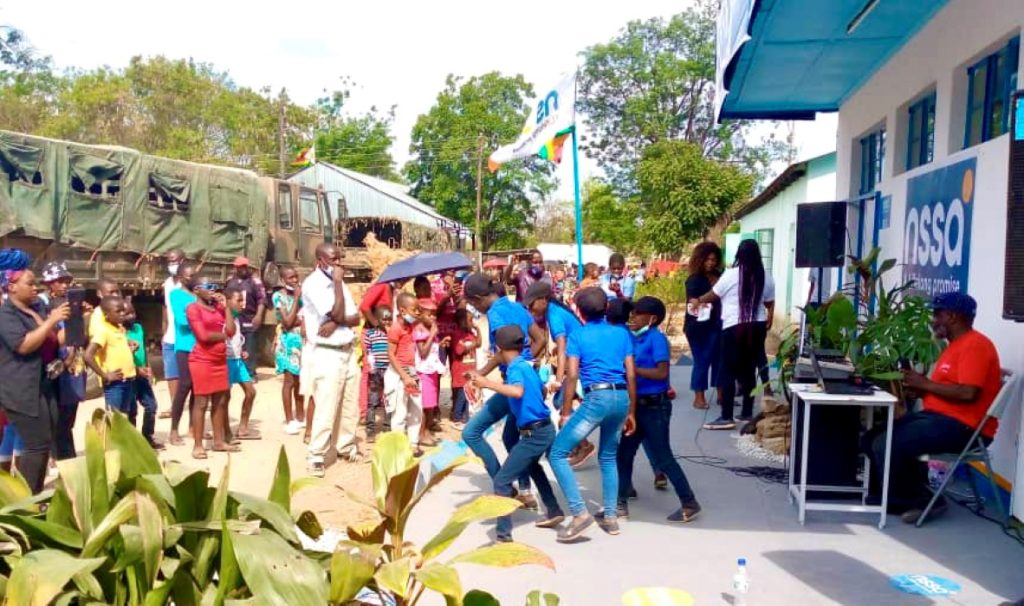
New COVID uncertainties in Zimbabwe
December 10, 2021The unfolding drama of the pandemic continues. With a new variant identified in the region (Omicron) thanks to the effective work of South African genomics monitoring, Zimbabwe has been subjected to international travel restrictions. However, despite the global concern about the potential spread of what may be a highly transmissible, immune-escaping variant, things on the ground feel very different. So far at least. After the sky-high infection rates and substantial deaths of a few months back, rates subsequently declined dramatically again. Will the new variant upset this? No-one knows of course.
Read more »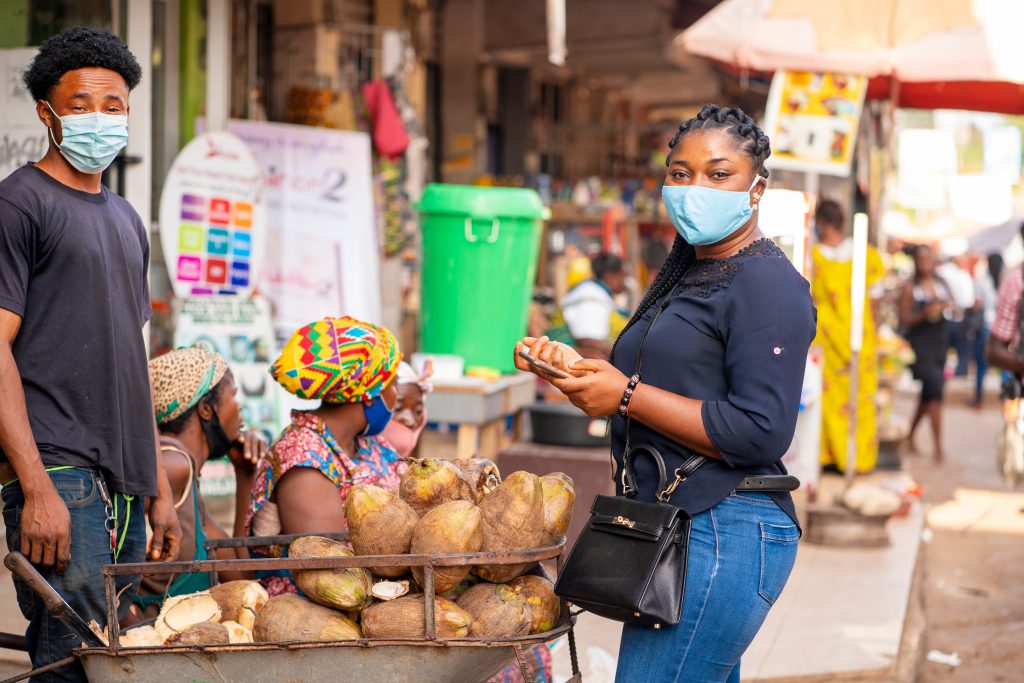
Streetwise explanations for extremely low new COVID-19 cases in Malawi
December 2, 2021From September, throughout October and as we now enter November, Malawi has seen its new daily COVID-19 cases sharply reduce to an all-time low. In fact, zero new daily COVID-19 cases have become very common during this period as reported by the Ministry of Health. New admissions into the COVID-19 hospital wards have also sharply reduced. The flattening of all these three curves is obviously a great relief to government, private sector, and households whose businesses and livelihoods ground to a halt as a result of the ruthless pandemic. This blog reflects on this steep decline in COVID cases and the public’s perception of its causes, as well as recent research presented in APRA’s Impact of COVID-19 on Food Systems and Rural Livelihoods in Malawi Synthesis Report.
Read more »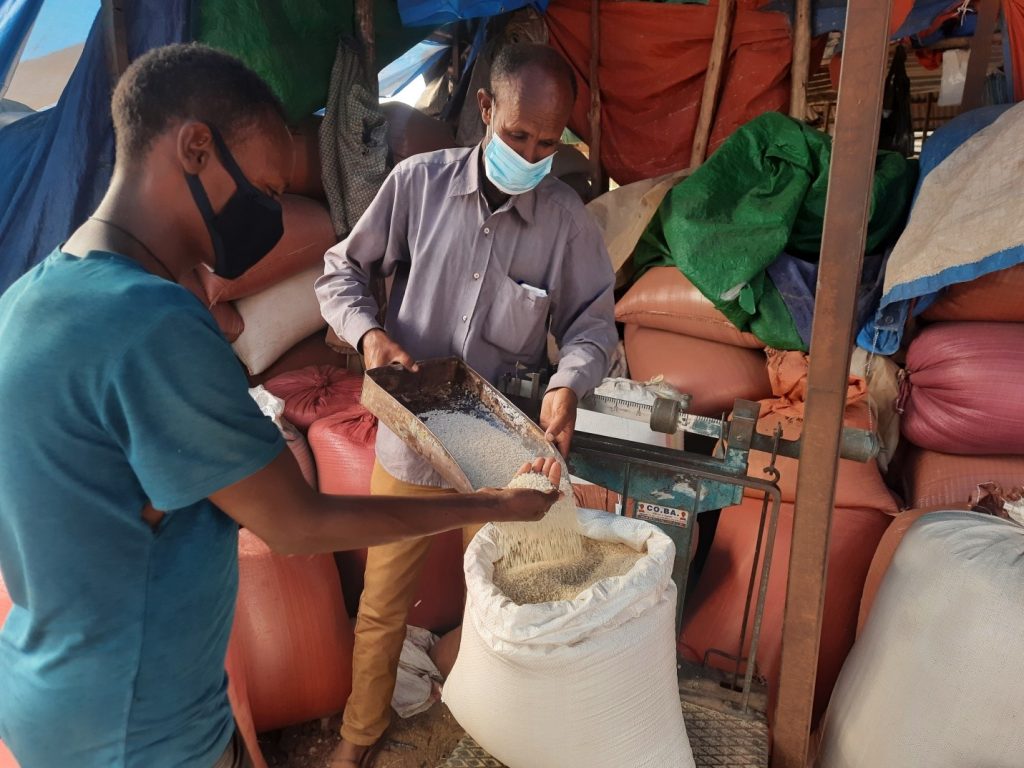
A multi-phase assessment of the effects of COVID-19 on food systems and rural livelihoods in Ethiopia: The case of Fogera Plain
November 25, 2021The COVID-19 pandemic has not only led to the loss of human life and resulted in an unprecedented challenge to public health, but has also seriously affected food systems and work opportunities.Following the confirmation of the first COVID-19 case in Ethiopia on 13 March 2020, and concerns about the sharp increase in cases, the federal government put in place different measures to prevent and control the pandemic that have affected the food system and rural livelihoods. This blog reflects on the findings of APRA’s Multi-Phase Assessment of the Effects of COVID-19 on Food Systems and Rural Livelihoods in Ethiopia: The Case of Fogera Plain, which presents the characteristics and awareness of the country’s different public measures, the responses to these measures, their effect on farming and marketing, food and nutritional security on smallholders, and perceived/self-assessed household level of poverty, drawing on primary data generated from three rounds of surveys and key informant interviews of rice farmers and other actors in the Fogera Plain of Ethiopia.
Read more »


